The best times to visit Mongolia
Aug 27, 2023 • 5 min read
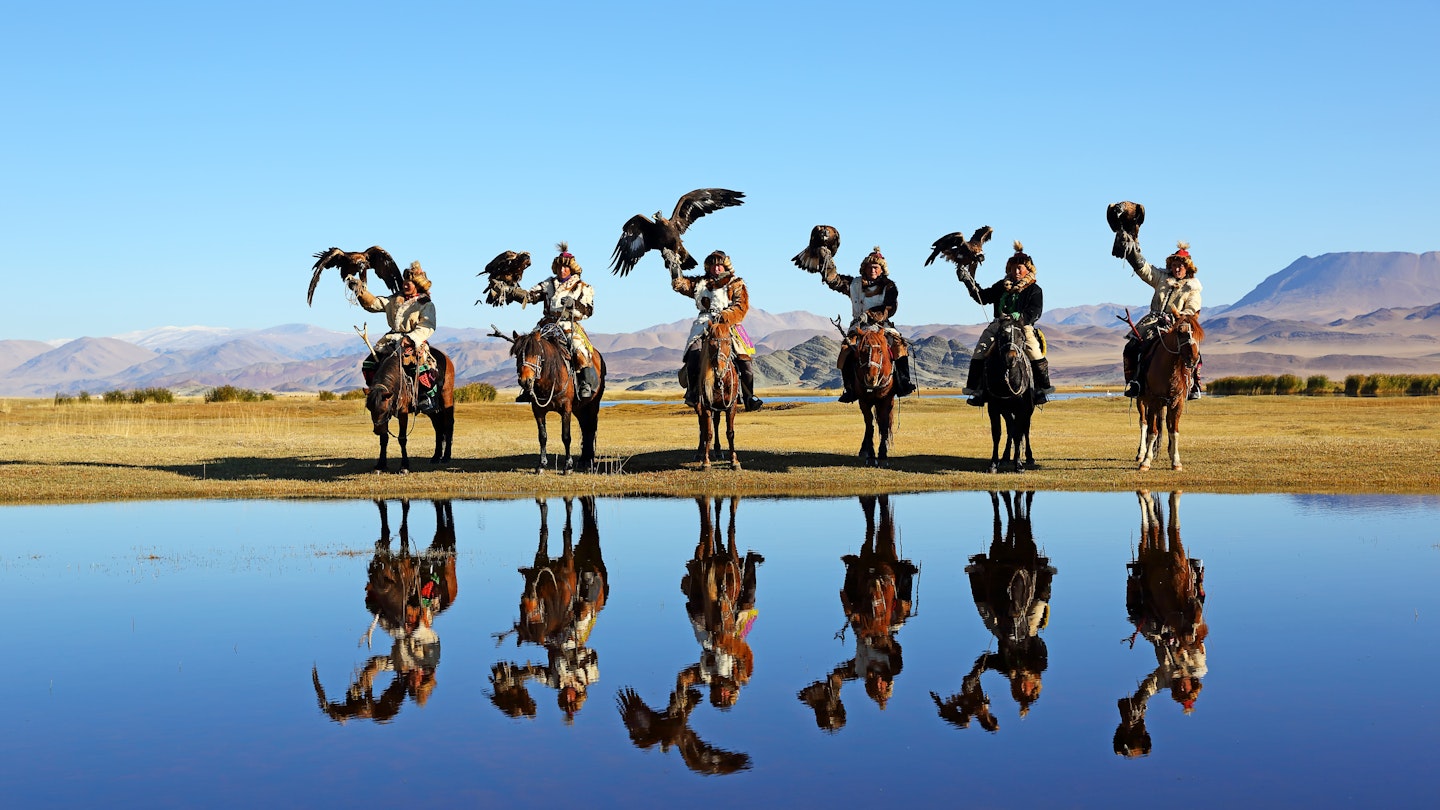
Whether you're visiting for eagle festivals or to explore the Gobi Desert, we can help you choose when to go to Mongolia © isarescheewin / Shutterstock
Famed for endless steppe vistas, fascinating nomadic culture, its thriving modern capital and stunningly diverse landscapes, Mongolia is a lot to take in. Before you decide on where to go, you’ll need to decide when to go – as the time of the year you visit will largely shape your trip.
When you weigh up those all-important variables of weather, big calendar events and peak season crowds versus low season savings, picking the optimum time to come is by no means an easy task – that’s why we’re here to help!
Ultimately, the best time to visit Mongolia is an answer that lies with you, the traveler, and what your interests are. Are you here to tick off bucket-list cultural events such as the world-renowned Naadam festival or the country’s fascinating golden eagle hunting festivals? Maybe you’re an outdoor enthusiast, here to trek on horseback or bike Mongolia’s wide-open lands in sublime weather? Or perhaps you’re more into snow sports and Mongolia’s unique winter festivals ?
Given the temperature extremes in Mongolia – peaking at 45°C (113°F) and plummeting to -40°C (-40°F) – the weather is obviously a big factor in deciding the best months for a visit. But truth be told, anytime is a good time to visit Mongolia, with each season bringing unique, memorable experiences. But if you’re looking for ideas, here are some of our favorite times to visit.


June to August brings glorious weather and the Naadam Festival
The summer is the peak season, and rightly so. This is when the weather really turns it on, making it adundantly clear why they call Mongolia “the Land of Blue Skies.” June, July and August are Mongolia’s warmest months, so this is the optimal time to hit the countryside. Under clear skies, you can experience nomadic hospitality as you traverse the grassy steppe by horse, foot, bike or 4WD before spending nights in ger (yurt) camps.
June is a particularly good time to visit, right before the main tourist season ramps up, meaning you’ll get to enjoy the landscapes with smaller crowds, and get a taster for Naadam with several smaller mini festivals. But the main event happens in mid-July, when travelers flock here en masse from around the world for the Unesco Intangible Cultural Heritage–listed Nadaam Festival – a colorful three-day spectacle of traditional Mongolian games.
These include distinctively local versions of horseracing, wrestling and archery – all traditions that date back centuries in Mongolia – set against a backdrop of much merrymaking. But this is also the time when things get really busy, so be sure to book accommodations and transport months in advance.
Also held in July is the Altai Nomad Festival in Altai Tavan Bogd National Park , featuring traditional Kazakh horse games such as kokbar , involving a tug of war with the carcass of a goat. August sees more wonderful weather, but things quieten down as the tail end of the high season approaches. At this time you can attend the low-key Danshig Naadam festival, which combines all the expected traditional sports with religious ceremonies and cultural events.
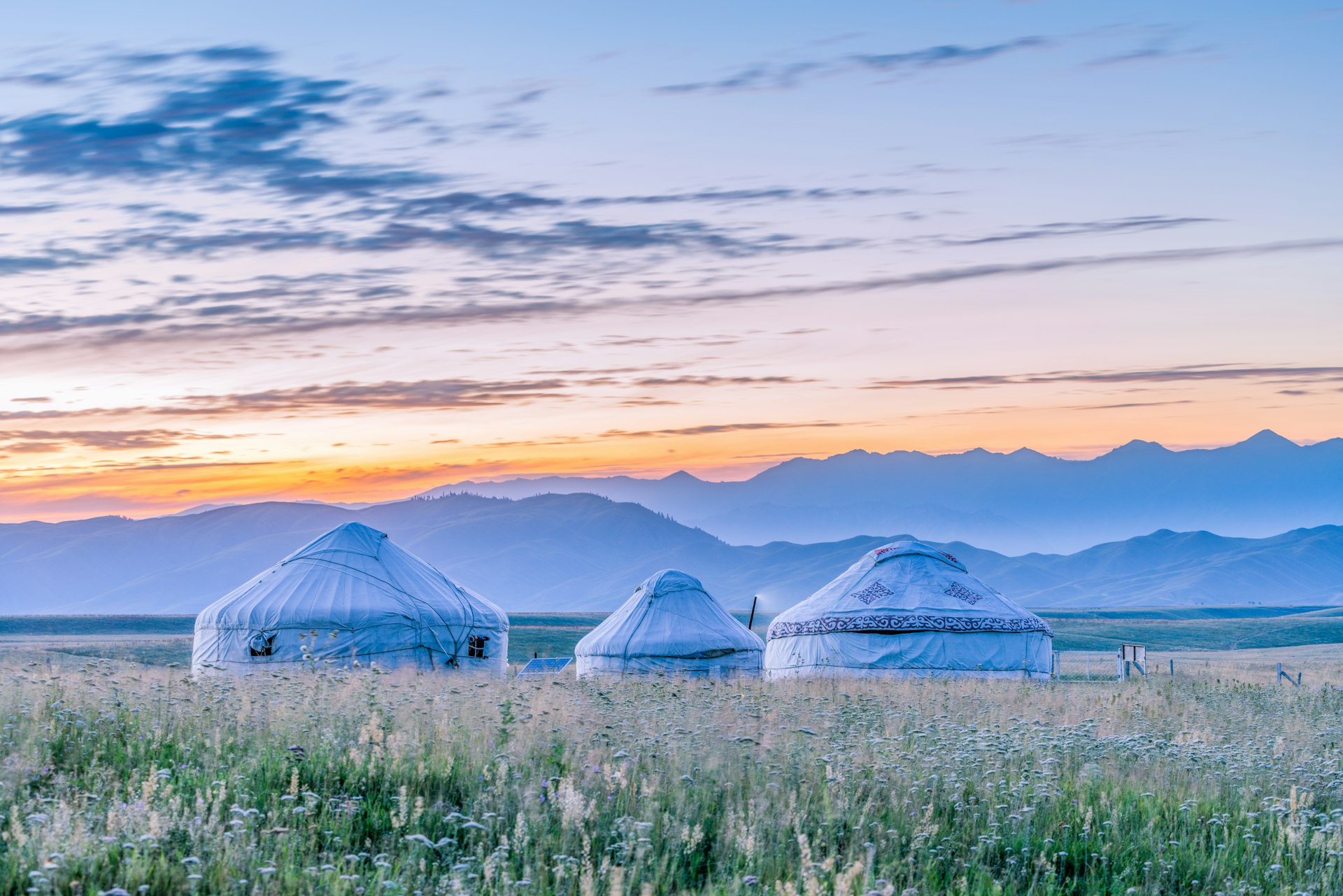
Come from April to May or September to October for eagle hunting, budget travel and fewer crowds
We’re big fans of traveling in the shoulder season, not just for the chance to experience Mongolia through a less touristy lens, but also for a more relaxed pace and lower prices. Sure, the weather can be a mixed bag (come prepared for four seasons in one hour) but in a land famed for 250 sunny days a year, you’ll still get plenty of clear weather.
Around April and May, Mongolia begins to thaw out from its winter deep freeze, as spring wildflowers bloom to color landscapes that turn progressively greener as time progresses. Many ger camps open up for the season, allowing you to enjoy Mongolia’s far-flung, empty wildernesses before tourists sweep in for Nadaam.
Late May is a good time to visit the Gobi Desert , when the storms and vicious airborne sand have subsided. You’ll also avoid the desert’s notorious freezing nighttime temperatures and scorching daytime heat. September sneaks in some warmer weather, but by October, winter is very much on the march.
But this is the time to visit if you’re here for one of Mongolia’s spectacular eagle festivals. Held in the first weekend of October, the Eagle Festival in Bayan-Ölgii is the big-ticket attraction, and you’ll be treated to dazzling displays of falconry by master Kazak eagle hunters, putting their prized birds of prey to the test in a number of competitions, from fashion parades to catching wild prey.
In late September there’s the more low-key Altai Kazakh Eagle Festival, an equally exciting event held over two days, combining eagle hunting demonstrations with horse and camel racing.
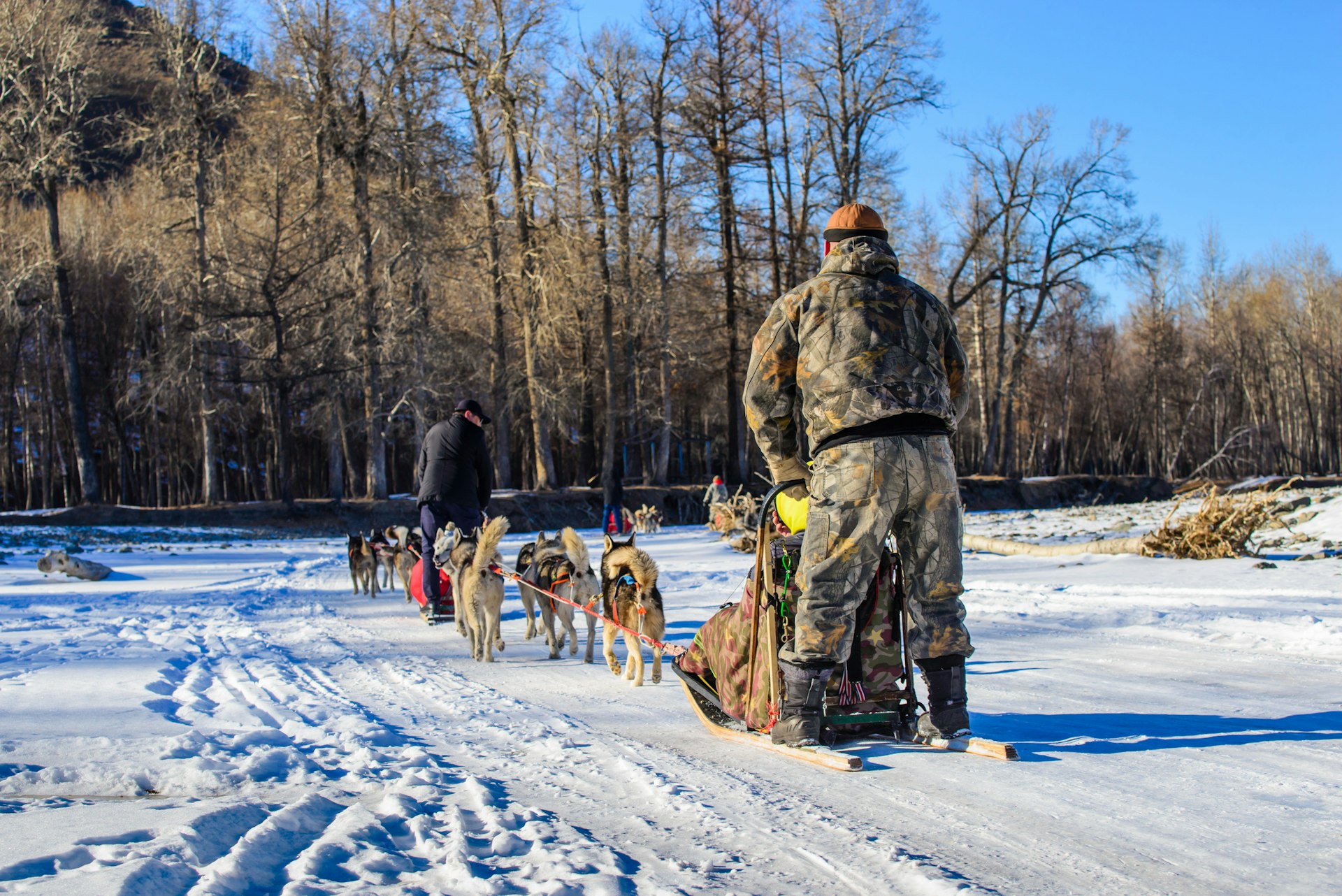
November to March brings winter festivals, snow sports and extreme cold
November is when things start to get really cold! But don’t let that stop you; instead our advice is to wrap up warm and dive in. There are plenty of highlights to take in, including cultural festivals and snow sports, and winter can bring price reductions for flights and accommodation, but not massive savings.
February is particularly good for traditional winter events, with both the Khatgal Ice Festival and Ulaanbaatar Winter Festival showcasing unique sports such as ice ankle-bone shooting (a fascinating game of skill played with animal bones), ice archery, and horse sledding competitions, alongside more familiar winter activities such as ice skating, ice fishing and dog sledding.
Tsagaan Sar, the Lunar New Year, is also in February, when you may be lucky enough to celebrate the festivities with local families. There’s also the Bulgan Camel Festival, the Gobi’s biggest event, when crowds flock to Ömnögovi for camel polo, camel races, camel shearing and other activities involving these prized beasts of burden.
November to March is also the time to get involved in snow sports, including downhill skiing at Ulaanbaatar’s Sky Resort . Dog sledding tours can easily be arranged, along with long-distance skating on Khövsgöl Nuur lake.
One word of warning, however. December and January can bring not only bitterly cold temperatures to Ulaanbaatar , but also horrendous pollution. If there are any months to avoid, we would single out January, unless you’re particularly hardy.
Explore related stories
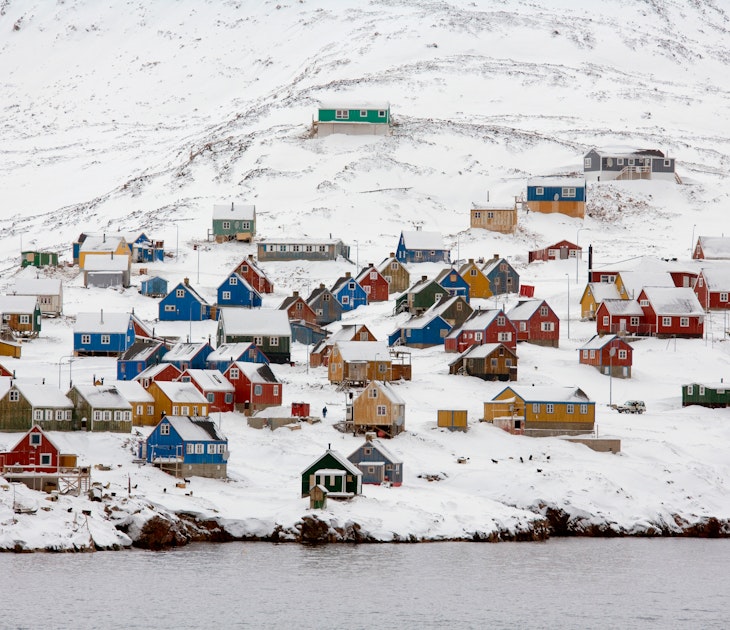
Wildlife & Nature
Dec 1, 2023 • 6 min read
How about chilling out – truly – on your next big trip? These are the coldest, most beautiful places to visit in the world.

Aug 30, 2023 • 9 min read
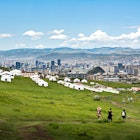
Aug 25, 2023 • 7 min read
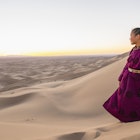
Aug 20, 2023 • 7 min read
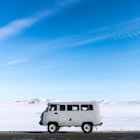
Sep 30, 2023 • 6 min read

Sep 28, 2023 • 4 min read
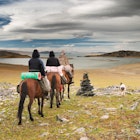
Aug 12, 2023 • 6 min read

Oct 24, 2021 • 4 min read

Oct 21, 2019 • 4 min read

Sep 23, 2019 • 7 min read
- Deutschland

- Mongolia Tours
- Tailor My Trip
- Tour Calendar
- Travel Guide
- Mongolia MICE Tour
- Car Rental & Transfer
- Mongolia Train Ticket
- Hotel Booking
Best time to visit Mongolia
Mongolia is known to the world as country of “Blue Sky of 4 Seasons “. In Mongolia there are 257 sunny days a year, often with clear cloudless skies. Along with Southern Siberia this part of Asia has a continental climate, with long, cold, dry winters and brief, mild, and relatively wet summers. The average summer temperature is +21°C, (+65°F) and winter is –20°C, (-13°F). The average rainfall is 200-220 mm.
The best time to visit Mongolia is during the Mongolian summer, from the mid of June till last week of August. This is the safest time of the year to travel to Mongolia in terms of weather, sunny days throughout Mongolia and sufficient rainfall to make the steppes lush and green. June and September are both very pleasant times to visit Mongolia. September, autumn is enjoyable, colorful, not hot, and not cold. Nomads have plenty of dairy products and are busy processing milk and preparing for winter. Beautiful countryside of Mongolia is even more beautiful and picturesque with the autumn colors.
Best Months of the Year
- July is the best time to see the Mongolia Naadam Festival.
- The best season for Gobi Desert tour: from June to September and October is shoulder season.
- July to August is the best season to travel to Northern Mongolia and Khuvsgul Lake tour and September is shoulder season.
- First of October is chance to see Golden Eagle Festival in Altai, Western Mongolia.
- February is the best time to experience Mongolia winter season.
Best Time to Visit Mongolia
What is the average monthly temperature & weather in mongolia, best times to visit mongolia.
November to February are the winter months, temperatures are consistently well below freezing. In January and February the temperature can sink as low as -30°C and will not rise above freezing until April arrives. If a visit is planned at this time then very warm clothes will be a necessity as wind chill is a very significant factor. This season features little but strong winds and snow covered landscape but often days of fine, clear weather will break through where the sun shines down on the snow.
Springtime breaks in March and April and temperatures are generally still below freezing. The locals consider this to be the worst of the year. After a long winter with harsh weather, livestock will be thin and may be close to death. There will be much hardship throughout the region but particularly amongst the nomads.
The summer season starts in May and lasts until August with temperatures peaking in July. This is the most popular season for tourists visiting Mongolia. The month of May might still see some snowfall, but the weather is usually good. Almost all of the rain in Mongolia falls between the months of June and September; this is due to the influence of the Chinese summer monsoon. The rainfall is heaviest in November causing the rivers begin to swell and greenery to return to the landscape.
September and October see cooler weather throughout Mongolia. When the autumn sets in, changing colours in the forests of the north provide even more appeal to the already spectacular landscape. At this time of year the weather is known to be extremely variable and clothing should cater to pretty broad conditions. There may be occasional snow in the north however travel is generally unaffected.
MONGOLIA TOURS 2023/2024
Related posts, mongolia weather.
Continue reading
Mongolia Visa Waiver
Packing list for mongolia, flights to mongolia.
How it works?
Let's plan your trip
Enquire now and a Travel expert will get back to you within 24 hours.
WE ARE MEMBER OF
Tour category.
- MONGOLIA TOURS
- PRIVATE TOURS
- GROUP GROUPS
- LUXURY TOURS
- TAILOR MY TRIP
- TRIP CALENDAR
DESTINATIONS
- ULAANBAATAR
- CENTRAL MONGOLIA
- SOUTHERN MONGOLIA
- NORTHERN MONGOLIA
- EASTERN MONGOLIA
- WESTERN MONGOLIA
TRAVEL GUIDE
- TRAVEL PLANNING
- BEST TIME TO VISIT
- TRAVEL TO MONGOLIA
- MONGOLIA VISA
- MONGOLIA TRAVEL FAQ
AMICUS TRAVEL
- TRAVELERS’ REVIEWS
- PARTNERS LOGIN
- HOW TO BOOK A TRIP
- TERMS & CONDITIONS
Sitemap Link Exchange © Copyright by Amicus Mongolia

- Tour packages
- Tailor Made
- Trip Calendar
- How to get to Mongolia
- Book train ticket
- Book cheap air ticket to Mongolia
- Best time to travel
- Tourist Sim card
- Mongolia Visa information
- What to pack
- Travel Insurance
- List of Mongolian Embassy
- Company profile
- Clients Feedback
- Job Vacancy
- Terms & conditions
- Privacy Policy
- Practical Information
- Destinations
- Things To Do
- Culture, Art & History
- Nature & Geography
- People & Society

- Practical information
- Gobi Desert
- Western Mongolia
- Eastern Mongolia
- Central Mongolia
- Northern Mongolia
- Ulaanbaatar
- Around Ulaanbaatar
- Weather Forecast
How it began

Latest blogs
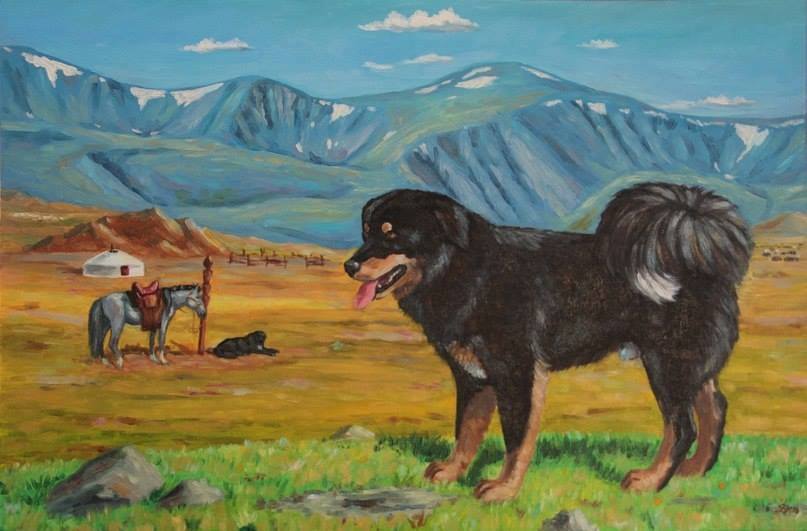
Travel tools
Need help planning your vacation.

The Best Time to Travel to Mongolia
If you are planning to travel to Mongolia, the most significant thing to consider is the weather. The country experiences an extreme continental climate; it is so far inland that no sea tempers its climate.
Mongolia has four seasons and each has its own character. Keep in mind that the country has an average of 230-260 annual days of sunshine. That is why Mongolia owns a nickname of “The Land of the Blue Sky” . Do not forget your sunglasses and sunscreen.
Each season of Mongolia is favorable along with the festivals and the best of activities. This article will help you to get acquainted with the climate and to choose the best time to visit Mongolia .
Visiting in summer (June to August)
- The temperature ranges from 20C to 25C, Gobi temperatures this month can rise up to 40°C
- Dry throughout the central and southern regions
- The mountains and northern areas can be cold in August
Pack a fleece, windproof rain jacket and a good pair of waterproof shoes.
Things to do in summer
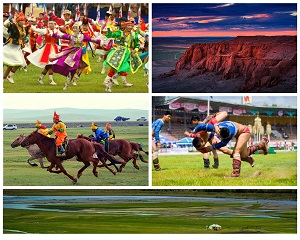
If you are wondering when is the best time to visit Mongolia , June might be the answer. It's a decent time to get out of the city and drive to the countryside. You will love camping in Mongolian spectacular scenery.
July is the time to see the largest and Olympic-like Naadam Festival in Ulaanbaatar city. Also, each province or soum (small administrative district) of Mongolia organize the festival of their own on different dates throughout the summer allowing travelers to experience a genuinely authentic and uncrowded Mini Naadam.
Seasonal highlight
- Mongolian Naadam Festival /10-12 July, Ulaanbaatar city/
- Local Naadam Festival /08-09 July, Kharkhorin soum, Uvurkhangai province/
- Gobi March /27 July - 03 August, Bulgan and Uvurkhangai province/
Click here for amazing summer tours.
Visiting in Autumn (September to October)
Nature at its best in autumn featuring with colorful landscape and temperate weather. The cool weather brings respite to the Gobi and the varying colors in the forests in the north are beautiful. October is again cool and sees the occasional or rare snow bustle up north but is still fine for travel, especially in the Gobi desert.
- The temperature ranges from 3C to 10C, Gobi temperatures this month can rise up to 40°C
- Unpredictable
- Rare snow bustle up north
Pack your fleece, gloves, scarfs, windproof rain jacket and a good pair of waterproof shoes.
Things to do in Autumn
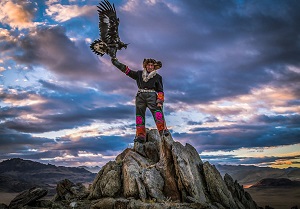
Drive to the Gobi the land of dinosaur and enjoy the pleasant and mild weather. It is a great time to go on a birdwatching tour or wildlife spotting tour to see the beautiful birds and animals in their natural habitat. Try fishing, horse trek, and hiking.
- Golden Eagle Festival /15-16 September, Sagsai soum, Bayan-Ulgii province/
- Golden Eagle Festival /05-06 October, Bayan-Ulgii province/
Click here for amazing autumn tours.
Visiting in Winter (November to February)
- The temperature ranges from -25C to -30C, sometimes the temperature drops down to -40°C
- Cold with snow storms and freezing cold wind
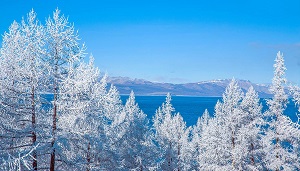
Pack your woolens and warmest clothes if you trotting here.
Things to do in Winter
In February when the weather comes closer to be stable and nice, the largest cultural festival Tsagaan Sar (Lunar New Year) is held. It will give you a memorable experience if you really want to know Mongolian culture and cuisine.
Also, the country has plenty of snow in winter where one can try winter sports. Enjoy dog sledding adventure in peaceful and beautiful Mongolian landscape. Experience Winter Horse Festival features a parade of unique and rare horses, thrilling competitions among horsemen, traditional singing and dancing performances, and horse race.
- Tsagaan Sar (Lunar New Year) /23-25 February, Erdene soum, Tuv province/
- Winter Horse Festival /02-03 November, Batnorov soum, Chinggis province/
Click here for amazing winter tours.
Visiting in Spring (March to May)
- The temperature ranges from 5C to 15C.
- Unpredictable weather, one can see four seasons in one day
- Rainfall occurs in the taiga areas of Khentii and Khuvsgul
- Dry and sunny
- You can see snowfall in the north
Things to do in spring
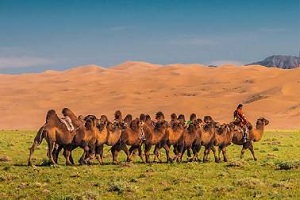
Also, spring is a great time when a new life begins. For herders, it is the happiest and the busiest time of the year dealing with offspring/young borns. Therefore, it would be an interesting experience to visit a nomadic family during that time.
Visit Khustai National Park or Terelj National Park to enjoy the wildlife spotting, bloom of flowers, grassland, and trees as well as the smell of spring in the air.
Seasonal highlights
- 1000 camel festival /06-07 March, Bulgan soum, Umnugobi province/
- Ice Festival /03-04 March, Khatgal soum, Murun province/
- Yak Festival
- Eagle Festival /05 March, Ulaanbaatr city/
Click here for amazing spring tours.
We hope that this article will be helpful for your trip planning to Mongolia. If you choose your ideal season, contact us for more information.

Don't let the planning stress you out
Most popular.
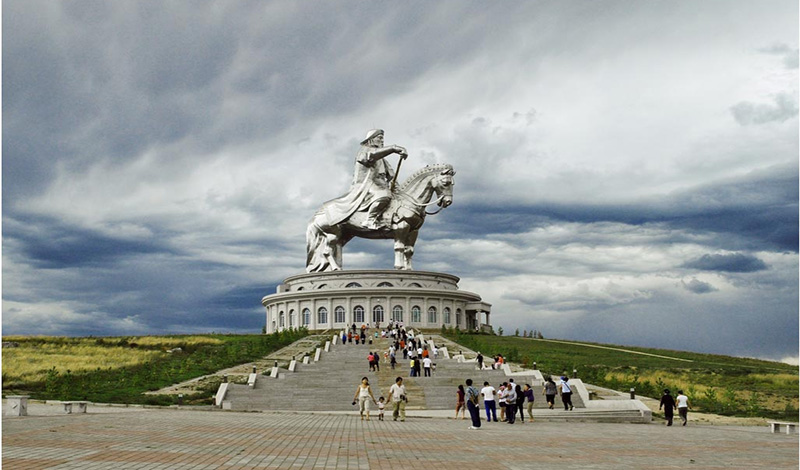
Since 2004, we have been helping people the world over to enjoy unforgettable adventures to our homeland, and we do it all with expertise and passion.
- Best seller tours
- Tailor made tour
- A day tours
- Join in tours
- Private tours
- Best Time to Travel
- Mongolian Visa Information
- Hotel booking
- Flight ticket booking
- Train ticket booking

We’re not taking new bookings for travel to Mongolia at the moment. Our specialists can advise you on all the destinations you can currently book with us.
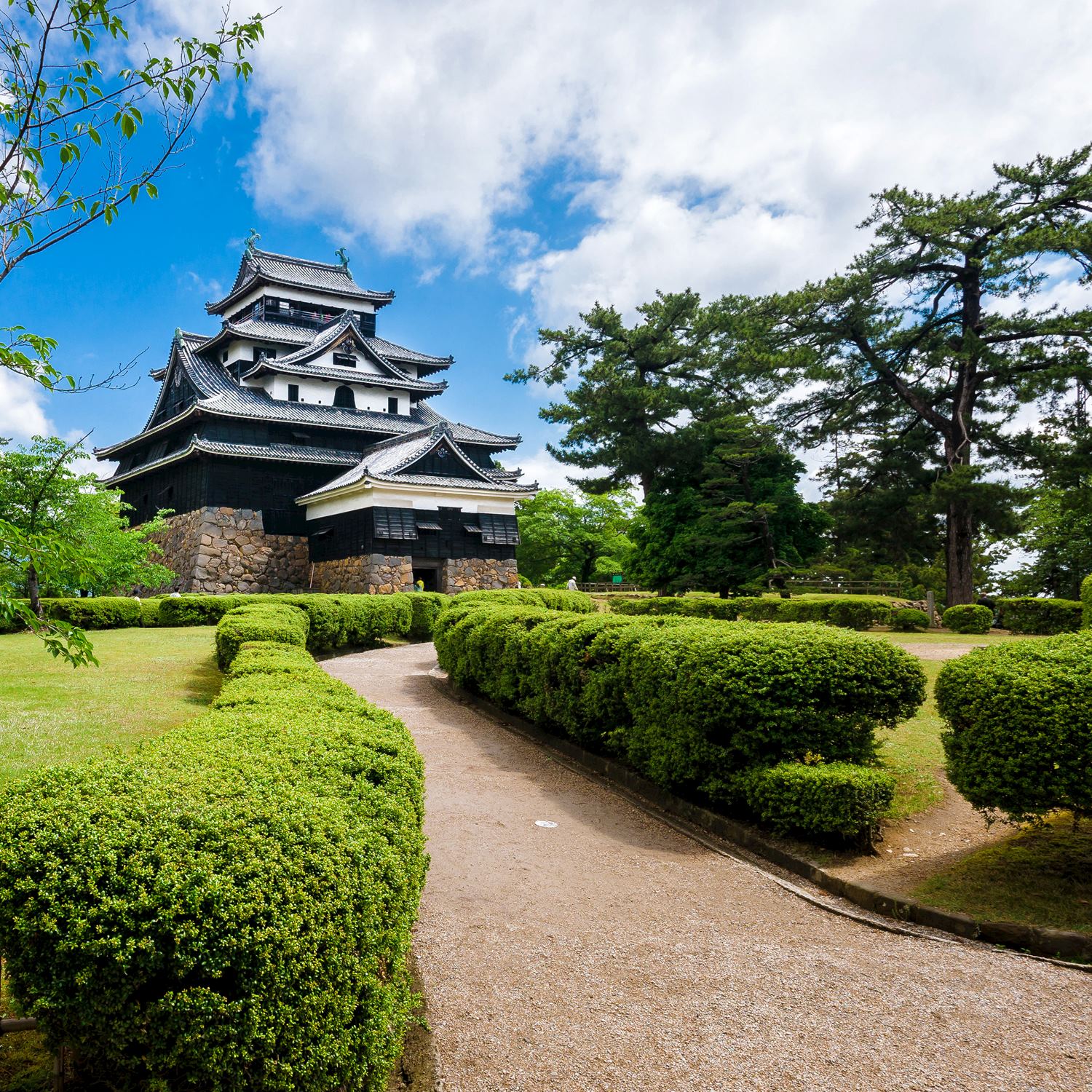
Change location
- Call us today from 9am 01993 838 925 01993 838 225 or
- REQUEST A QUOTE
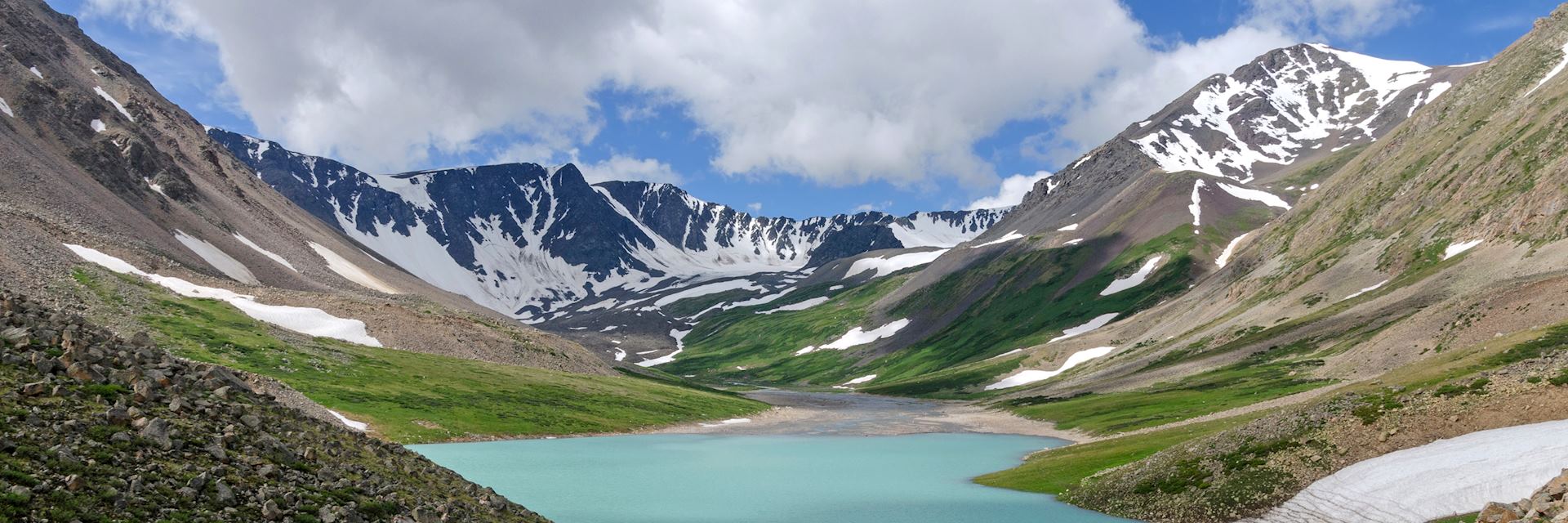
When is the best time to visit Mongolia?
- Month-by-month
The best time to visit Mongolia is between June and August, when the landscapes are lush and green, and temperatures are warm, ranging from 18°C to 28°C.
Mongolia’s landlocked location gives rise to an extreme continental climate, with temperatures varying wildly. Only the southern Gobi is truly hot during the summer months, though this is also when you’re more likely to encounter the little rain that does fall each year.
Temperatures are normally anywhere between -2°C and -18°C in winter, although they can drop as low as -30°C across the country at this time. Given this, it’s no surprise that Ulaanbaatar is the world’s coldest capital. Travel to the areas around the city is only feasible between May and October due to the severity of the winter months.
It’s possible to travel to Mongolia on the Trans-Siberian Railway at any time of year, although certain months can be much more rewarding than others.
Month-by-month guide for travelling in Mongolia
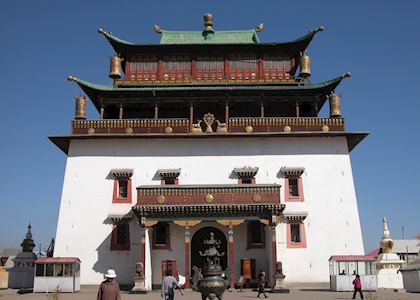
Visiting Mongolia in January - March
Mongolia’s wintertime is fierce — Ulaanbaatar becomes the world’s coldest capital — so we advise against all travel during this period.
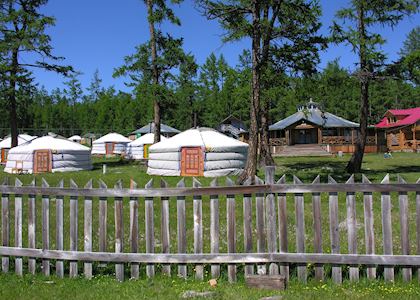
Visiting Mongolia in April - May
Mongolia starts emerging from its arduous winter (although you may still see snow on the ground well into June). The countryside outside Ulaanbaatar is dotted with wildflowers and the landscapes are generally greener. Ger camps are open all year round, but springtime can be a particularly good time to visit when the nights aren’t quite as bitingly cold.
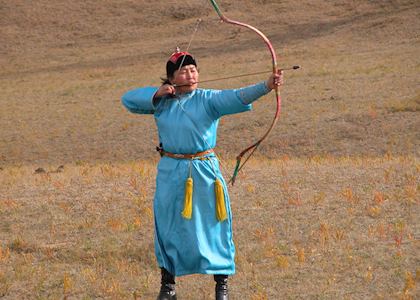
Visiting Mongolia in June - July
Mongolia’s summer months of June and July see the country at its busiest. Visitors arrive in droves to attend the Naadam Festival, so availability can be non-existent (if you plan to visit in July, we recommend booking your trip well in advance). The days are longer and warmer, making for generally more comfortable travel conditions.
Events & Festivals
- The Naadam Festival is a major tournament celebrating Mongolian culture and its national sports (archery, horse racing and wrestling).
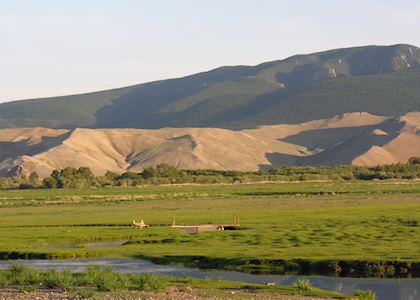
Visiting Mongolia in August - September
The weather is still warm, although Ulaanbaatar and its surrounds can experience a little more rain. The country quietens down and can become a little colder, especially toward the end of September.
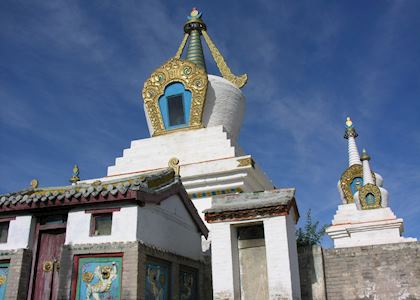
Visiting Mongolia in October - December
October sees winter close in on Mongolia again. The cold temperatures last until April, making travel anywhere in the country unadvisable during the final months of the year.
Why travel with Audley?
- 100% tailor-made tours
- Fully protected travel
- Established for over 25 years
- 98% of our clients would recommend us

Travel advice
Practical tips for travelling to Mongolia, from social protocols to guidance on money matters, with a link to the latest FCDO travel advice.

Request our brochure
Covering all seven continents, The World Your Way shows you how you can see the world with us. It features trip ideas from our specialists alongside hand-picked stays and experiences, and introduces our approach to creating meaningful travel experiences.
Trip ideas and travel guides for exploring Mongolia
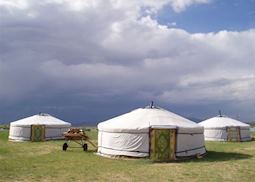
Staying in a Mongolian ger camp

The best time to visit Mongolia
When is the best time to visit mongolia.
The best time to travel to Mongolia depends on your preferences and the experiences you seek. Here is a detailed breakdown of the different seasons and what they offer:
Summer (June to August):
Mongolia’s summer is the peak tourist season, and for good reason. During this time, the landscapes transform into lush green meadows, making it ideal for outdoor activities such as trekking, horse riding, and camping. The temperatures range from 18°C to 28°C, providing comfortable conditions for exploration. It is essential to pack lightweight, breathable clothing and sunscreen.
Spring (April to May) and Autumn (September to October):
Spring and autumn in Mongolia offer pleasant weather and fewer crowds compared to summer. These transitional seasons bring milder temperatures, ranging from 10°C to 20°C. Spring brings blooming wildflowers and a vibrant atmosphere, while autumn showcases stunning fall foliage. It is a great time for nature lovers, photographers, and those who prefer a more peaceful travel experience.
Winter (November to March):
Mongolian winters are notorious for their cold temperatures and heavy snowfall. However, it is also a time when you can experience the unique beauty of the country covered in snow. Winter opens up opportunities for activities like dog sledding, ice fishing, and visiting the famous ice festivals. Temperatures can drop as low as -30°C, so be sure to pack heavy winter clothing, including thermal layers and insulated boots.
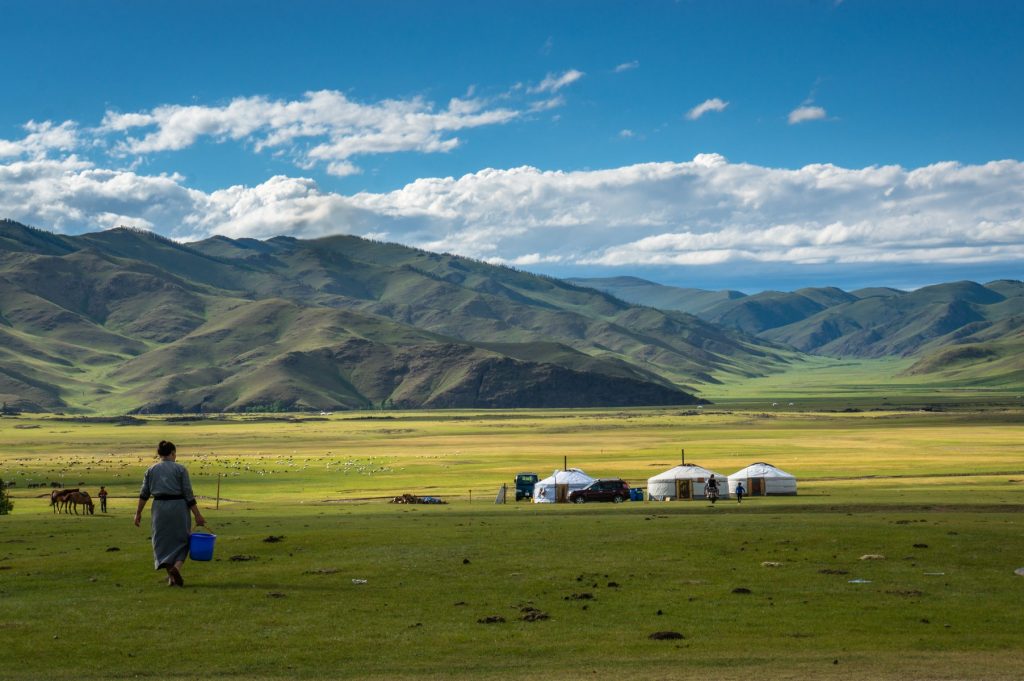
It is important to note that due to Mongolia’s extreme continental climate, weather conditions can be unpredictable and vary widely. Always check the weather forecast before your trip and be prepared for sudden changes in conditions. Furthermore, the specific region you plan to visit in Mongolia may have slightly different climate patterns. For example, the Gobi Desert experiences hot summers and extremely cold winters, while the northern regions, such as Khuvsgul Lake, have colder temperatures throughout the year.
Ultimately, the best time to travel to Mongolia depends on your interests and the kind of experience you desire. Consider the activities you wish to engage in, temperature preferences, and the level of tourist crowds when planning your trip.
The best tour packages to know before you plan your trip:
Vacation in mongolia tours.
Vacationing in Mongolia is increasingly gaining popularity year after year, as it remains one of the few countries that still holds an air of mystery for many people around the world.
TREKKING IN MONGOLIA TOURS
Mongolia is truly one of the most beautiful countries on earth, and if you would like to check it out yourself well, here are a few good reasons to consider jetting off to Mongolia on your next hiking adventure.
EXPLORE GOBI DESERT TOURS
This is yet another highly sought-after tourist destination in Mongolia. Gobi desert tours in Mongolia have been experiencing a steady rise in popularity, attracting individuals who seek adventurous exploration in the wildest parts of the country.
THE TOUR HUNTING WITH EAGLES
This tradition, known as eagle hunting, was introduced to the Mongolian steppes by the Kazakhs, who constitute one of the significant ethnic minority groups in Mongolia.
TOURS NEAR ULAANBAATAR CITY
Here, we present to you a selection of the finest tour destinations located near Ulaanbaatar. These places offer easy accessibility and remain open throughout the year, ensuring a delightful experience for visitors.
SHORT TOURS IN MONGOLIA
There are many interesting sights and places to visit near Ulaanbaatar city. If your time is shrinking that would be the best option for you to do in Mongolia.
KHUITEN PEAK CLIMBING TOURS
Our Mongolian local tour operator provide professional guided Khuiten peak climbing tours and expeditions in western Mongolian Altai mountain range.
THE PHOTOGRAPHY TOURS
Photography tours in Mongolia or workshop tours in Mongolia. Virgin nature, breathtaking landscapes, and beautiful lakes, and fascinating mountains make Mongolia one of the best countries for photographing activities.
THE DOG SLEDDING TOURS
Dog sledding tour near Ulaanbaatar is one of the must do tour activity during the winter. This tour is operated near Ulaanbaatar in Terelj national park.
Join in group tour for central Mongolia
2 seats left for the group starting at 3rd of June 2024.
Max group size 4 people!

The Ultimate Mongolia Travel Guide 2024
From the best time of year to visit to how to get a SIM card and where to register with immigration , these are the important things to know as you plan your trip to Mongolia.
- April 9, 2020
- Updated: January 24, 2024
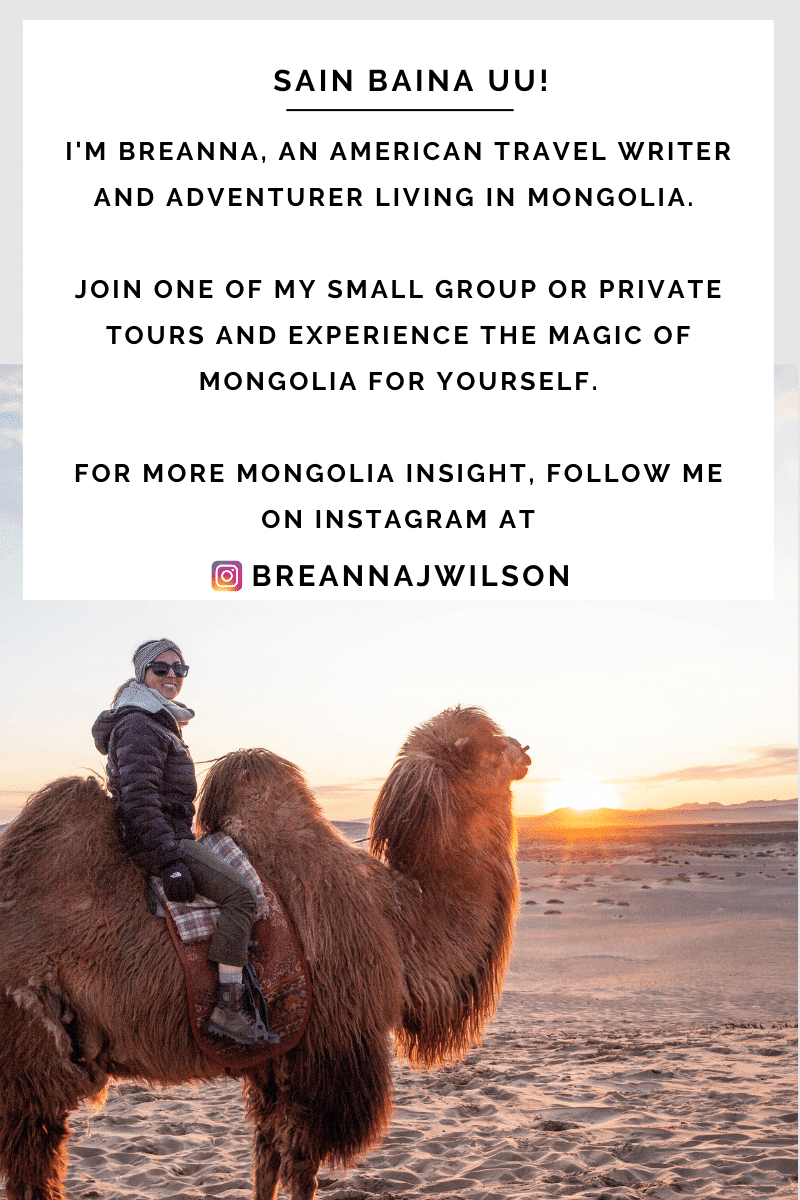
The Mongolian Snuff Bottle Explained
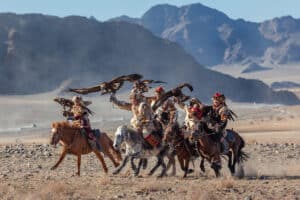
Live with an Eagle Hunter Family During this Eagle Festival Tour 2024

What is Mongolian Traditional Mounted Archery?
Table of contents.
When I say I love living in Mongolia, I mean it with every part of my heart and soul. It was after coming here in 2018 as a tourist to join a Mongolia tour and experience the local culture that I remember thinking, this place can’t be real.
It turned out to be the best way to experience Mongolia I could have asked for. That short trip made me realize the Mongolian steppe is one of the last truly untouched places in the world for nature lovers and true adventure seekers.
Nomadic families really did still live of the land, and their herds, the same way they have for thousands of years. Talk about sustainable.
In fact, 25% of the Mongolian population still lives this way. That’s a huge percentage in a country of just over 3.2 million.
However, it wasn’t just the Mongolian countryside that I fell in love with. After coming back and living a summer in Ulaanbaatar (also written as Ulan Bator), Mongolia’s capital city, I knew this was the country, and the place for me.
It’s by no means easy living here. This is not the United States, where everything runs smoothly. Language barriers are a thing, credit cards always have issues (especially Mastercard), and you really need to get used to Mongolian time. Whether you want to or not.
In the end, I’ve learned it’s better not to resist this style of living and just go with the flow. It’s probably the only reason I’ve made it this long here. Living here has taught me a lot about patience, compassion, and myself. Things living in Los Angeles, New York, and growing up in Pittsburgh couldn’t do in 32 years.
Because, when it comes down to it, Mongolia is a tough place to be as a foreigner among the local people. When I moved here, there was no information on how to navigate the the city, let alone rural Mongolia. I’m talking, nothing! I had to become my own local guide.
Not just for people crazy enough to move here like me, but for travelers, too. The type of people willing to travel more than 24 hours to a place where they usually have no idea about the chaos they are about to encounter. The kind of people who book a tour but the tour company could be real and you could have the adventure of the lifetime, or it could be a complete scam. The people who just go for it with fearlessness without ever looking back. Those are my people. You are my people.
So, I hope this Mongolia travel guide, along with the other guides on this Mongolia travel blog give you the insight and information that wasn’t available to me when I first came here. That these articles will help you navigate Ulaanbaatar like a local and Mongolia like a travel pro.
As always, if you need help planning an itinerary or have more specific travel questions, you can always book a 30-minute travel consultation with me. There’s nothing I love more than talking about Mongolia and getting people excited about visiting.
When is the Best Time of Year to Visit Mongolia?
Summer is the best time of year to visit Mongolia and is considered peak season. June, July, and August are beautiful months with a great deal of things to see and experience. This is when most tourists visit Mongolia, so you can expect peak rates, sometimes crowded natural landmarks and museums, and full flights.
The average summer temperature in Mongolia is between 25° and 32° C, with cold nights. You can comfortably wear t-shirts during the day and a light jacket when it gets dark. Dust storms are common in the summer season, especially when you’re on the wide-open plains.
Keep in mind that if you visit areas in the north or west, at higher elevations, temperatures will be lower than this. If you visit places in the south, particularly the Gobi Desert, temperatures will be much higher. Temperatures in the Gobi Desert average 40° C, and higher, in June, July, and August.
If you plan to visit Mongolia in the summer, especially in July, book your tours, hotels, and flights no later than March. July is the busiest month for tourism in Mongolia thanks to the Naadam festival. Hotel rates in Ulaanbaatar are even known to double in price between July 10 and 12, when the Opening Ceremony takes place in the city.
Naadam is the biggest and most important festival of the year and visiting Mongolia during Naadam gives you the best of Mongolia, and Mongolian culture, in just a few short days. The festival always takes place in July, with the National Opening Ceremony always being held in Ulaanbaatar on July 11. Thus, the high hotel rates in the city.
It’s during Naadam when you can watch wrestling, horse racing, and archery competitions big and small across the country.
Here are some other great things to see and experience when visiting Mongolia in June, July, and August:
- Annual Naadam Festival
- PlayTime Music Festival
- Spirit of Gobi Music Festival
- Tenger World Shaman Festival
- Mongol Derby
- Monkey Run Mongolia
- Free Daily Cultural Shows in Ulaanbaatar
- Polo Matches at the Genghis Khan Retreat and Polo Club

What to Expect When You Visit Mongolia in Fall, Winter, or Spring
While summer is the most popular, and best time to visit Mongolia for many reasons, fall, winter, and spring shouldn’t be immediately ruled out. Here are a few reasons why.
Personally, fall is my favorite time to be in Mongolia .
Tourism starts to die down at the end of August as school starts and the weather starts to get a bit chillier and days shorter. This is the time when most nomadic families begin to prepare for the cold winter months ahead, which makes it an especially interesting time to visit. You can help families move to their winter camps, either by truck, camel, or yak, and help tear down and build their gers (homes) with them. It’s a special time to bond with families and feel like you’re being useful. The worst is when you go somewhere and feel like they’re just putting on a “show” for tourism reasons. This isn’t that. I can promise.
September is also the time when the landscape turns a beautiful golden hue. Trees turn bright shades of yellow, orange, and red, and snow starts to cover the mountain tops.
Because of all these things, traditional ger camps begin closing up for the season at this time. This is usually to traveler’s benefits because it means you can find great deals on nightly rates before they do.
Then, when October hits, it’s time for the famous Golden Eagle Festival .
The festival is extremely popular with tourists, so be sure to make your arrangements if you want to attend as far in advance as possible. I would recommend making your arrangements before June. Especially since securing flights from Ulaanbaatar to Ulgii can be tricky and confusing. For this I also recommend hiring a local tour company to make all your arrangements.
The annual Golden Eagle Festival is always held the first weekend in October .
Here are some other great things to see and experience when visiting Mongolia in September, October, and November:
- Sagsai Eagle Festival
- Golden Eagle Festival
- Ulaanbaatar Jazz Week
Don’t let the idea winter in Mongolia intimidate you. Yes, temperatures do reach -30° C. And yes, Ulaanbaatar is officially the coldest capital city in the world . But it’s because of these things Ulaanbaatar, and Mongolia, are something special to see and experience during December, January, and February.
While temperatures do drop to around -30° C, you can still do things like visit and spend the night in a yurt with a nomadic family out in Gorkhi-Terelj National Park. Out there, you can go horseback riding on Mongolia’s famously wild horses, and even dog sledding through the winter wonderland that has become the snow-covered countryside.
Or, better yet, head down to the Gobi Desert, one of the only deserts in the world where snow can lay across the dunes covering them in a sea of white. This is the perfect time to experience the natural beauty of the Mongolian desert, but with fewer crowds.
Alternatively, Tsagaan Sar , or Mongolian Lunar New Year, happens in February and is a unique way to experience a Mongolia relatively free of other tourists.
The holiday marks the first day of spring and a time when Mongolians take the time to visit each of the elders in their family, bringing gifts and sharing a meal. This is a special time for Mongolians to celebrate with family and look forward to new beginnings.
Here are some other great things to see and experience when visiting Mongolia in December, January, and February:
- Ulaanbaatar’s Christmas Markets
- New Year’s Eve Celebrations
- Tsagaan Sar (Lunar New Year)
- See the Gobi Desert Covered in Snow
- Dog sledding on Lake Khusvgul
- Ice Fishing
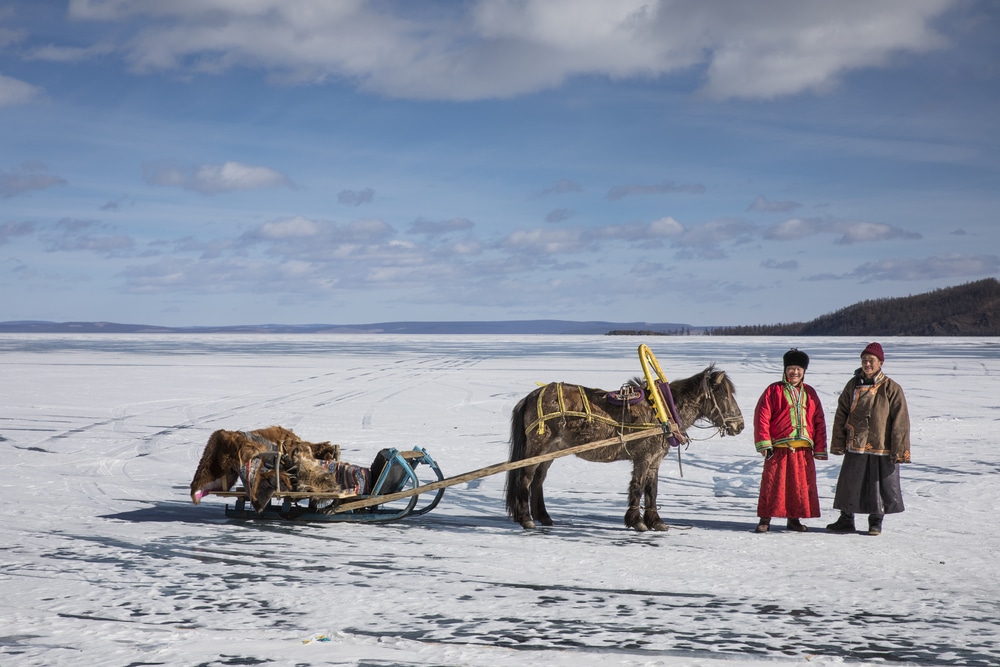
While most people think of spring as a time when temperatures start to warm up, flowers begin to bloom, and life returns to nature, spring in Mongolia isn’t quite that. In fact, spring is still uncomfortably cold and you should probably just think of spring in Mongolia as winter-lite.
Blizzards can still occur in May, which locals refer to as dzud (or zud, a natural phenomenon that kills off a large portion of herds from starvation since they aren’t able to graze), and it’s still a harsh time in the country as locals start to run out of winter rations and look forward to warmer summer months.
However, as is usually the case in Mongolia, the brave are rewarded with two very cool festivals that make a trip to Mongolia in the spring worth it.
The annual Camel Festival is held each March in the Gobi Desert.
During the festival, there are camel polo matches, camel races, and friendly competitions among the local camel breeders. Mongolia is one of the few places in the world where you find Bactrian (two-hump) camels, and the Gobi Desert one of the only deserts in the world where snow accumulates. Making a trip down to the desert during this time is actually quite a magical experience.
Also in March, the annual Ice Festival is held on Lake Khuvsgul, the world’s second-largest freshwater lake. The lake is completely frozen over and is strong enough to drive cars over and host an entire festival on.
And yes, this region bordering Siberia will be every bit as cold as you’d expect it would be, so don’t come unprepared. A fur-lined winter deel (traditional Mongolian robe) probably wouldn’t be a bad investment. You can have one custom-made in Ulaanbaatar as soon as you land.
Here are some other great things to see and experience when visiting Mongolia in March, April, and May:
- Camel Festival
- Ice Festival
- Ulaanbaatar Eagle Festival
Finding a Cheap Flight to Mongolia
Check the cheapest rates to Ulaanbaatar on CheapOair.com below.
The best direct flights to Mongolia are on the following airlines:
- Mongolian National Airline (MIAT)
- Turkish Airlines
If you’re traveling from the U.S., your two best options are via Istanbul on Turkish Airlines or via Seoul on Korean Air. I usually recommend traveling via Istanbul if you’re departing from the east coast and via Seoul if you’re departing from the west coast.
Turkish Airlines is my personal preference and I’ve never had an issue with them. I particularly like Turkish Airlines right now because they have a layover program that includes a free 4-star hotel in Istanbul . Besides helping break up your jetlag, it’s also an excuse to cross another country off your list. Two birds, one stone!
From Europe, flying via Frankfurt on MIAT, Mongolia’s national airline, is another good option. As an airline, MIAT is safe, but they don’t always have the best track record for being on time, having a smooth check-in process, and cancellations do happen with them more often than other airlines. I have flown MIAT, but they usually aren’t my first choice.
Internal domestic flights can be booked through MIAT, Aero Mongolia, or Hunnu Air. Domestic roundtrip flights are not cheap, usually costing at least a few hundred U.S. dollars. It’s also extremely confusing to book these flights on your own, especially without a local Mongolian bank account. If you plan to book a domestic flight in Mongolia, I recommend getting a local tour guide or agency to help you through the process.
Once you land in Ulaanbaatar at Chinggis Khaan International Airport, here are the best ways to get from the airport into the city center .
Taking the Trans-Siberian Railway
Taking the Trans-Siberian Railway from Moscow to Beijing is one of the most iconic train journeys in the world. It’s high on my list of things to do, and I’m hoping to do it sooner rather than later.
Conveniently, the Trans-Siberian Railway stops in Ulaanbaatar, giving travelers an excuse to explore the city and surrounding countryside for a few days. The train station is located in the heart of Ulaanbaatar and most hostels and guesthouses offer free transfers from the train station.
Tips for Taking Taxis, Public Transportation, and Hiring a Driving
When it comes to hailing a taxi, finding the bus schedule, or hiring a private driver, there are a few things to know. Use these travel tips for getting around Mongolia cost-efficiently and with less hassle than if you were to have to figure it out on your own.
Finding a Taxi in Ulaanbaatar
You can hail a taxi in Ulaanbaatar simply putting out your hand to your side, signaling you’re looking for a ride.
These are not official taxis, but they are the most common way to get around the city. It’s how I get around almost every day. It’s safe and reliable, but you do need to explain where you’re going. I usually tell the driver a major landmark that’s close enough to where I’m going or I show them on Google Maps. On occasion, the driver will ask for your destination before allowing you in their car, just in case they aren’t going that way. Both male and female drivers stop and do this, sometimes with kids and other family members in the car. It’s all normal here.
When it comes time to pay your driver, expect to pay 1,500 MNT per kilometer . It’s helpful to have small bills and exact change, most drivers don’t carry cash.
If the thought of getting into a strange Mongolian’s car freaks you out, apps like UBCab are the Mongolian equivalent of Uber, which don’t exist in Mongolia. You’ll need a local Mongolian number to register within the app and begin requesting rides. The app is okay from a user perspective and the driver usually calls when they’re on their way to your pickup location.
You’ll still need cash if using UBCab, the app doesn’t accept credit cards. At the end of the ride you’ll see your total in the app, which also helps you get a gauge on the average taxi price to get around the city.
Scooters and Bikes
Ulaanbaatar is now home to both scooter and bike sharing apps.
Jet scooters are hard to miss scattered around town. To use one, download the Jet app ( Apple , Android ), scan the scooter’s QR code, and then pay by the minute. You can use the app to find a nearby scooter and while they are a convenient way to beat rush hour traffic, Ulaanbaatar’s sidewalks and drivers don’t make it the safest option. Ride with caution!
Hi Sainuu ( Apple , Android ) is the bikesharing app that’s taken over the city. It works much the same way as Jet and, again, should be used with caution.
Public Transportation in Ulaanbaatar
Buses within Ulaanbaatar are often crowded, especially around rush hour thanks to a lack of routes and other public transportation options. Ulaanbaatar does not have a subway system.
Cash is not accepted once you step on the bus so you’ll need a refillable U Money Smart Card (3,600 MNT to purchase) to take the bus. The price per ride is 500 MNT. You can purchase and refill a U Money Smart Card at bus kiosks around town or inside CU convenience stores. Note that routes and bus numbers will appear in Cyrillic.
You can find information on bus stops, waiting time, routes, and U Money kiosks on the UB Smart Bus app ( Apple , Android ).
Additionally, it’s possible to take buses from Ulaanbaatar to different cities throughout the country. Bus tickets and schedules are found at the Dragon Center Bus Station, on the outskirts of Ulaanbaatar. You can now purchase bus tickets to destinations outside of Ulaanbaatar online , but be warned the system doesn’t always work as promised. I recommend going to the bus station a day before you plan to depart Ulaanbaatar to get the most up-to-date schedule and purchase your ticket in-person then.
A bus ride to Moron, for example, will be relatively inexpensive, costing 32,000 MNT for the 14-hour ride.
Renting a Car in Ulaanbaatar
Renting a car in Mongolia these days isn’t as cheap as it used to be. In fact, it’s downright expensive. With only two major rental companies to choose from, Avis and Sixt, there’s a monopoly on the car rental market. When you rent from either company, expect to pay a deposit on the rental around $2,000 USD, not including any of your rental costs, which will also need paid up front. If there’s no damage done to the car, you’ll get the deposit money back after returning the rental at the end of your trip.
One hack to that is renting a car through a company like Follow the Tracks . The company offers self-driving tours of Mongolia and these cars are equipped with rooftop tents and they even give you a route to follow.
Another reason I really like Follow the Tracks is because it can be very difficult to navigate Mongolia on your own. Once you leave the city the roads conditions start to worsen, and fast.
Unless you’re a driver who’s really comfortable driving off-roading, and in extreme conditions, I don’t recommend renting a car in Mongolia.
Instead, hire a driver.
Hiring a Driver in Mongolia
There are a few benefits to hiring a driver in Mongolia.
First, like I mentioned above, unless you are really comfortable driving off-road, driving in Mongolia is not easy.
Second, you can’t beat the cost. The cost per day to hire a driver with a car in Mongolia is currently 200,000 MNT per day. You are responsible for the driver’s meals, making sure they have a place to sleep, and you’ll pay for your own gas along the way. Your gas costs will depend on your route, and the type of car you’re in, but expect to fill up at least three to four times during your trip at 300,000 to 400,000 MNT per tank.
Your driver will need to be paid in cash at the end of your trip. Gas can usually be paid for by credit card at gas stations like Petrovis, but you should also carry emergency cash on you for at least two tanks of gas, just in case.
I recommend hiring a driver with either a Toyota Land Cruiser 200, Toyota Delica, or Russian UAZ furgon. These will be the most reliable cars that will get you across the steppe. UAZ furgons are the least comfortable of the three options, and usually also the cheapest.
Drivers are always flexible, easy going, and ready to fix their own car when something goes wrong. Something I can almost guarantee will happen. Usually drivers don’t speak English, but you’ll quickly learn the key words you need to get through your journey. Never underestimate the power of sign language and Google Translate. Take the time to get to know your driver, they’re funny characters that start to become like family in no time.
Popular Mongolia Guides:
- 11 Traditional Mongolian Foods To Know
- Gift Ideas for Visiting a Nomadic Family
- Best Books About Mongolia
- What to Budget and Travel Costs (2023)
- How to Get From Ulaanbaatar Airport to the City Center
Itinerary Ideas & Packing Lists:
- Chinggis Khaan Equestrian Statue & Gorkhi-Terelj National Park Day Trip
- How to Attend Naadam, Mongolia’s Biggest National Festival
- Mongolia Packing List: The Essentials
Plugs and Voltage
Sockets in Mongolia work with both U.S. (type B plugs with two flat prongs and a grounding pin) and European plugs (type C plugs with two round pins). Each socket has one type of each plug.
So, if you’re coming from the U.S., your device will work in most wall sockets in Mongolia. However, it is important to note that there will be a voltage difference. In Mongolia the sockets are 230 volts, compared to the typical 120 volt sockets we use in the U.S.
Most computer chargers, phone chargers, and other electronics have power converters built into the device to account for these types of voltage differences.
For example, I use my U.S. computer charger without any issue. I plug it right into the socket in my apartment, in coffee shops, in hotels – everywhere – and I’ve never had an issue. The same goes with my phone charger, camera battery charger, drone charger, hair straightener, and just about any other electronic you can think of.
If you’d like to bring a wall charger that will allow you to charge via USB-A and USB-C, I recommend this travel adapter . This two pack also gives you the most charging power out of the shortest available charging time.
When packing for Mongolia, be sure to bring travel adapters, power banks, extra C charging cables, and a solar powered charger, if you have one. Electricity is not reliable or regularly available once you leave Ulaanbaatar, so you need to be prepared if you plan to travel around the country for several days. Especially if you plan to do a homestay or spend time in the more remote corners of the country.
As I mentioned above, be aware that the voltage is much higher in Mongolia than it is in the U.S. (230 V vs 120 V). If you plan to plug directly into the wall socket make sure your device has a built-in power converter, or you have a power adapter that allows for dual voltage.
Getting a SIM Card
The best place to get a physical SIM card in Ulaanbaatar is at the State Department Store on the 5th floor. There you’ll find Unitel , MobiCom , Skytel , and gmobile kiosks next to each other. Since they are all located next to each other, it’s easy to browse and compare each company’s service plans and choose the right one for your trip.
Most locals use Unitel, myself included, which offers some of the best service coverage across the country.
Getting a SIM card is quick and easy, but you will need to bring your passport with you to get one issued. You can use a credit card or cash to purchase your car and plan, which should cost less than 40,000 tugrik all together.
If you have an iPhone 15 that doesn’t have a SIM card holder , you can ask for your SIM to be converted to an eSIM . From experience, I know that Unitel offers eSIM cards .
eSIMS are also available in Mongolia and can be purchased through apps like Airalo. Purchasing an eSIM this way is more expensive ($35 USD compared to $10 USD), but it is more convenient and works just as well as using a physical SIM. If you’re short on time and won’t have time to make it to the State Department Store before leaving the city, this is a great option.
Before you purchase a SIM card of any kind, be sure to ask yourself if you really need or want one. Service in the countryside is hit and miss, so even if you purchase a SIM you may not have any data or service.
Only purchase one if it’s absolutely necessary for you to stay connected. Otherwise, enjoy being disconnected, that’s one of the best things about traveling in Mongolia.
If you do decide to purchase a SIM, the two most reliable service providers in Mongolia are MobiCom and Unitel. Tourist plans start as low as 20,000 tugrik and include international call rates, SMS messaging, and different levels of data. No service provider will be able to offer unlimited data, we just don’t have that in Mongolia yet.
Exchanging Cash in Ulaanbaatar
The local currency in Mongolia is Tugriks , also spelled togrog or used as the abbreviation MNT.
As of December 2023, one USD = about 3,455 Tugrik .
You will always need to have cash on hand in Mongolia. Even in Ulaanbaatar where credit cards are becoming more widely accepted. But, you can’t always rely on them to work. It’s especially known that there are issues with Mastercard credit cards and American Express. If you have a Visa credit card, that is your best option for using around the city.
Cash will always be needed if you hail a taxi off the street, and be sure to carry smaller bills on you at all times. Expecting exact change isn’t always possible. I recommend carrying at least ten 1,000 MNT bills, four 5,000 MNT bills, and two 10,000 MNT bills with you at all times. This is still a country where cash is king.
The easiest way to exchange USD or Euros for Tugriks is at one of the currency exchange offices off of Sambuu Street, near the Holiday Inn , where this Google Maps pin is.
There is also a cash exchange stand in the State Department Store, on the third floor, near the kitchen electronics.
ATM’s are more available than cash exchanges in the city, so you can pull out money that way as well. ATM’s typically have a withdraw limit of 500,000 MNT, 800,000 MNT at very select terminals.
Prepare to have what will seem like a large amount of cash on you and note that Mongolia does not use coins.
While most tour operators, guides and private drivers are happy to accept cash in USD or Euros, taxi drivers and local businesses will only accept MNT.
Take my advice and take care of this before you leave Ulaanbaatar for the countryside. Finding working ATMs and currency exchange counters isn’t so easy in the country’s small towns and remote areas.
Visa-Free Countries and How to Get an E-Visa
Citizens from more than 60 countries, including the U.S., Canada, Australia, New Zealand, Germany, Italy, Spain, and the United Kingdom of Great Britain and Northern Ireland can enter Mongolia without needing a visa.
U.S. citizens do not need a visa to enter Mongolia. If you are a U.S. passport holder, and you plan to stay more than 30 days, you will need to register with the immigration office within 7 days of arriving in the country. Then, you can stay up to 90 days without issue. If you fail to register with immigration, you’ll be fined a few hundred dollars at the airport when leaving the country.
Citizens of Canada, Denmark, Belgium, Germany, Iceland, Israel, Italy, France, Spain, Greece, Norway, Sweden, and Switzerland can stay visa-free for up to 30 days .
Citizens from 98 countries, including India, China, Mexico, Saudi Arabia, South Africa, and Armenia can now apply for an electronic visa before departing for Ulaanbaatar.
See the full list of visa-free countries here.
Registering with the Immigration Office
When I first started coming to Mongolia this process had to be done in person at the Immigration Office, which is nowhere near the center of town. Today the process is automated and takes only minutes to complete.
U.S. citizens who plan to stay in Mongolia for more than 30 days need to register with the Immigration Office within 48 hours of arrival.
This has nothing to do with being allowed to stay for up to 90 days visa free. This is absolutely mandatory. I can’t stress this enough. If you fail to register at the Immigration Office you will be stopped at passport control on your way out of the country and not allowed to board your flight until you pay the fine for violating this law. Even worse, you could be banned from entering the country ever again.
Luckily, you can now register with the Immigration Office online.
To register online with immigration you will need to do the following. You will need the information for the person responsible for your stay in the country, including their ID number, email, local phone number, and address . You should have this information before you begin filling out the form.
- Go to https://immigration.gov.mn/en/
- Click “Registration of a Foreign National”
- Follow the steps on the form
- Click submit and you’re all set. The form may not look like it’s been submitted, but it has.
- You won’t receive a confirmation email so I recommend taking a picture of the screen or a screenshot in case there is an issue or dispute when you go to leave the country.
Language and Religion
Mongolian is the official language spoken in Mongolia. It’s written using the Cyrillic alphabet. Although it’s becoming more common to see it written using Latin letters.
Russian and English are the second and third most spoken languages by Mongolians. However, don’t expect most people in Ulaanbaatar to speak English. Most Mongolians don’t.
It will be more likely to find English-speakers in Ulaanbaatar. Once you leave the capital, don’t expect English to be a common language to use for communicating. (You can always use my Mongolian Language Cheat Sheet for help.)
Buddhism is the main “religion” practiced in Mongolia. About 80% of the population considers themselves Buddhist.
Mongolians also believe in respecting the earth and its inhabitants above all else. This is called Tengerism and it was primary religion in Mongolia centuries ago. Today Tengerism and Shamanism still play an important role in the core beliefs of most Mongolians, but they’ll still call themselves Buddhists.
While most of the country’s monasteries were destroyed during Soviet times, a handful can still be found across the country and are worth taking the time to seek out and visit.
Eating and Drinking in Mongolia
There are many amazing traditional Mongolian dishes to taste during your travels. From homemade buuz (dumplings) to tsuvian (friend noodles with dried meat and vegetables) and khuushuur (think: Mongolian hot pocket meets an empanada), you’ll have plenty of opportunities to taste them all. Especially if you’re planning to spend time with a nomadic family in their home.
There are a few important things to remember about eating and drinking in Mongolia.
First, it’s rude to accept food and not finish it. Food is a scarce and sacred resource on the steppe and it should be treated that way.
Second, always accept a plate, cup of tea, or anything else from your host with your right hand or two hands.
Finally, drinking is very common in Mongolian culture. A bottle of vodka for your nomadic host will always go a long way but be warned that (like many post-Soviet countries), alcoholism can be a problem. Always drink with caution and be aware of your surroundings and never drink and drive. Mongolia has a zero tolerance policy.
Besides vodka, airag , or fermented mare’s milk, is another common alcoholic beverage. It’s most commonly consumed in the countryside, where nomadic families make their own brew. Be cautious when drinking airag, your stomach won’t be used to the bacteria and it’s been known to make people run to the toilet. I’m speaking here from experience!
I recommend keeping your drinking to a minimum when you’re staying with a host family. Especially if you’re female or traveling alone.

Travel Insurance and Emergency Healthcare
Getting medical treatment is cheap compared to other countries. I paid about $3,000 all in for surgery in Ulaanbaatar at a private hospital when I broke my collarbone. If I was in the U.S. that same surgery would have probably been $30,000.
The downside of cheap medical treatments is that they aren’t always the most reliable or consistent. While I had a great experience, I can’t say that other foreigners have had the same.
This is why I always recommend purchasing travel insurance for your trip to Mongolia.
Should something terrible happen to you during your trip, such as a horse riding or car accident, your travel insurance policy should cover medical emergencies and evacuation. Be sure to do your research when looking at policies and choose the best one for you, your travels, and your budget.
Look for a policy that also covers trip cancellation in case you need to unexpectedly cancel your travel plans. Trip cancellation policies cover unforeseen events, like an illness, injury, jury duty, or an airline strike. Reimbursable costs in these instances could include transportation, accommodations, and tour costs, up to 100% depending on your policy.
If you experience a medical emergency while in Ulaanbaatar, the phone number is +976 103.
If you experience a medical emergency while outside of Ulaanbaatar, the best thing to do is get to the city as quickly as possible. If you don’t need to, don’t go to one of the local towns for medical treatment.
Hospitals I can vouch for in Ulaanbaatar are:
- UB Songdo Private Hospital
You can find more information, including each hospital’s location and contact information, on our what to do in case of emergency page.
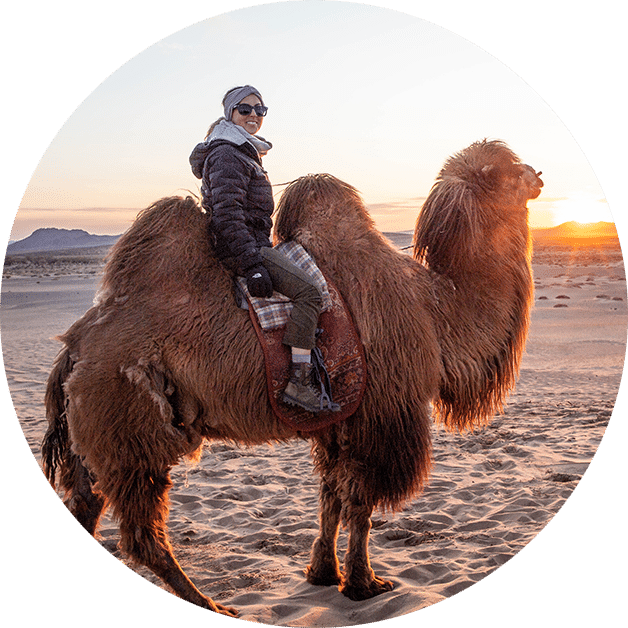
Author: Breanna Wilson
Hi! Sain uu! I’m Breanna, an American travel writer and adventurer living in Ulaanbaatar, Mongolia for more than 5 years. I’ve written for and been featured in Condé Nast Traveler, CNN, Forbes, and the New York Times, among others. Read more of my Mongolia travel articles here .
Mongolian Lunar New Year and Shambala Winter Tour 2025
Privacy policy, terms & conditions, join my private travel group on facebook.
Proudly Based in Ulaanbaatar, Mongolia © 2024 Meanwhile in Mongolia
AFFILIATE NOTICE
This website contains links to products and services where I may make a commission when you purchase. This supports the continued upkeep and development of this website. For an explanation on this policy, read my Advertising Policy page .
The Best Time to Visit Mongolia for Weather, Safety, & Tourism
The best times to visit Mongolia for ideal weather are
May 28th to September 9th
based on average temperature and humidity from NOAA (the National Oceanic and Atmospheric Administration). Read below for more weather and travel details.
Mongolia Travel Guide
Temperature.
- Perceived Temperature
- Rain and snow
- Humidity and wind
- The busiest and least popular months
- Overall travel experience by time of year
Other Mongolia Travel Info
Weather in mongolia.
Average temperatures in Mongolia vary an incredible amount. Considering humidity, temperatures feel cold for most of the year with a very low chance of rain or snow throughout the year. The area is somewhat temperate — in the 43rd percentile for pleasant weather — compared to tourist destinations worldwide. Weeks with ideal weather are listed above . If you’re looking for the very warmest time to visit Mongolia, the hottest months are July, August, and then June. See average monthly temperatures below. The warmest time of year is generally late July where highs are regularly around 80.4°F (26.9°C) with temperatures rarely dropping below 55.3°F (12.9°C) at night.
Mongolia Temperatures (Fahrenheit)
Mongolia temperatures (celsius), “feels-like” temperatures.
The way we experience weather isn’t all about temperature. Higher temperatures affect us much more at higher humidity, and colder temperatures feel piercing with high winds. Our perceived temperatures factor in humidity and wind chill to better represent how hot or cold the day feels to a person.
Mongolia Perceived Temperature (F)
Mongolia perceived temperature (c), average mongolia temperatures by month.
Daily highs (averaged for the month) usually give the best indication of the weather. A significantly lower mean and low generally just means it gets colder at night.
Show Fahrenheit
Show celsius, precipitation (rain or snow).
If dry weather is what you’re after, the months with the lowest chance of significant precipitation in Mongolia are January, February, and then December. Note that we define “significant precipitation” as .1 inches or more in this section. The lowest chance of rain or snow occurs around early to mid January. For example, on the week of January 8th there are no days of precipitation on average. By contrast, it’s most likely to rain or snow in mid June with an average of 1 days of significant precipitation the week of June 18th.
Chance of Precipitation
The graph below shows the % chance of rainy and snowy days in Mongolia.
Snow on the Ground
The graph below shows the average snow on the ground in Mongolia (in).
Average Rain and Snow by Month
Show inches, show centimeters, humidity and wind.
Mongolia has some comfortably humid months, and dry months in the opposite season. The least humid month is May (28.1% relative humidity), and the most humid month is December (54.7%).
Wind in Mongolia is usually calm . The windiest month is May, followed by April and June. May’s average wind speed of around 8.4 knots (9.7 MPH or 15.6 KPH) is considered “a gentle breeze.” Maximum sustained winds (the highest speed for the day lasting more than a few moments) are at their highest in late May where average top sustained speeds reach 15.6 knots, which is considered a moderate breeze.
Relative Humidity (%)
The graph below shows the average % humidity by month in Mongolia.
The graph below shows wind speed (max and average) in knots.
Average Wind Speeds
Show wind speeds.
All wind speeds are in knots. 1 knot = 1.15 MPH or 1.85 KPH.
Show Relative Humidity by Month
Is it safe to travel to mongolia.
Our best data indicates this area is generally safe. As of Dec 04, 2023 there are no travel advisories or warnings for Mongolia; exercise normal security precautions. Check this page for any recent changes or regions to avoid: Travel Advice and Advisories . This advisory was last updated on Oct 26, 2023.
The Busiest and Least Crowded Months
The busiest month for tourism in Mongolia is October, followed by August and May. Prices for hotels and flights will be most expensive during these months, though you can save if you purchase well in advance. Tourists are unlikely to visit Mongolia in February. Those willing to visit at these times will likely find it the least expensive month.
Estimated Tourism by Month
Most popular months to visit, overall mongolia travel experience by season, spring (march through may).
Humidity and temperatures combine to make this season feel moderately cold. Highs range from 69.6°F (20.9°C) and 21.6°F (-5.8°C) with far warmer temperatures in the later months. Rain is rare with 0 to 2 days of significant precipitation per month. Spring is the second busiest for tourism, which makes it a good time for those looking for things to do.
Summer (June through August)
The middle-year months have very comfortable weather with high temperatures that are comfortable. These months see the most precipitation with 4 to 5 days of precipitation per month. June – August is the busiest season for tourism in Mongolia, so lodging and other accommodations may cost more than usual.
Fall (September through November)
Fall daily highs range from 67.6°F (19.8°C) and 19.1°F (-7.2°C), which will feel chilly given the humidity and wind. It rains or snows a normal amount: 0 to 2 days per month. Tourism is fairly slow during these months due to the weather, so hotels may be lower priced.
Winter (December through February)
Weather is far too cold this time of year in Mongolia to be enjoyable for warm weather travelers. The average high during this season is between 21.6°F (-5.8°C) and 3.9°F (-15.6°C). On average, it rains or snows a insignificant amount: consistently 0 times per month. These times of year are the slowest with tourists.
Best Times to Travel › Mongolia
Similar Destinations
- Ulan-Ude, Russia
- Bol’shoye Goloustnoye, Russia
- Listvyanka, Russia
- Baykalsk, Russia
- Utulik, Russia
- Irkutsk, Russia
- Sakhyurta, Russia
- Khuzhir, Russia
- Baotou, China
Popular Destinations
- Penang, Malaysia
- Stockholm, Sweden
- Rhodes, Greece
- Mongolia Tours
- Mongolia Travel Guide
- When to Visit Mongolia
Best Time to Visit Mongolia
- Jan Avg Daily: -16 ° C Avg Nightly: -29 ° C
- Feb Avg Daily: -11 ° C Avg Nightly: -23 ° C
- Mar Avg Daily: -2 ° C Avg Nightly: -14 ° C
- Apr Avg Daily: 8 ° C Avg Nightly: -5 ° C
- May Avg Daily: 17 ° C Avg Nightly: 3 ° C
- Jun Avg Daily: 21 ° C Avg Nightly: 9 ° C
- Jul Avg Daily: 25 ° C Avg Nightly: 11 ° C
- Aug Avg Daily: 23 ° C Avg Nightly: 10 ° C
- Sep Avg Daily: 15 ° C Avg Nightly: 3 ° C
- Oct Avg Daily: 7 ° C Avg Nightly: -7 ° C
- Nov Avg Daily: -5 ° C Avg Nightly: -18 ° C
- Dec Avg Daily: -13 ° C Avg Nightly: -26 ° C
- ~ mins read
Mongolia is laid back country that is ideal for those who enjoy solitude. The vast emptiness of the country and the isolated landscape will make you feel like you’re on a different planet altogether. In a way, it is this ethereal beauty that makes up Mongolia’s charm - there is no other place in the world that even comes close. If you want to experience this otherworldly beauty, figure out when to visit Mongolia , and you’ll be good to go!
- JILEK JAROMIR
- From Czech Republic
Quick Facts
- High season : June - August
- Low season : October - April
- All seasons: May - September (summer), October - April (winter)
- The best time to visit Mongolia is between June and August when the weather is warm, and relatively dry compared to the winter months.
- May and September are also good months to visit Mongolia. They are shoulder months, but it might be too cold for certain visitors.
- October to April is the peak winter in Mongolia, but this is when to visit Mongolia if you are a fan of winter sports.
- The temperature in December - January is freezing, so this is a period when you should avoid Mongolia at all costs.
Mongolia is a vast country, and the endless steppes will definitely make you realize just how the earth actually is. From Khuvsgul Lake, to Gobi Deserts, and the Altai Mountains, the Mongolian landscape is vast and varied, and you will definitely not have a dull moment during your entire trip.
The best time to visit Mongolia is between June and August, which is the peak of summer. The weather is particularly warm (compared to the other months), and except for a few scattered rainstorms, there is little to no precipitation either! Mongolian summers are the best time to travel to the country, for the winter can get rather merciless, and unless you’re used to sub-zero weather, you will not enjoy your time there.
You can also visit during May, or September. The weather in Mongolia is slightly colder than in the summer, but it is still bearable. There will be fewer tourists in the country during this period, and many gers (traditional yurt camps) will either be closing down for winter, or opening up after the end of the season. Make your plans in advance, and have a flexible schedule if you’re traveling during this period, as the weather might change with little notice.
Seasonal Overview
1. may to september — summer/ high season.

Summer is the best time to visit Mongolia for a number of reasons. The weather is usually dry throughout the season, except in Ulaan Baatar , where there may be thunderstorms in the months of July and August. The weather in the Gobi desert will be incredibly warm, with temperatures going above 100 degrees. Towards the end of the season, there may be rainfall in the northern and central parts of the country as well. However, Mongolia looks beautiful after the rains, as the Gobi becomes more comfortable, and the forests in the north start changing colors. The weather can be rather unpredictable during May, and September, so make sure you pack your warm clothes all the time!
- Avg. Temperature : 48 – 62° F / 9 – 17° C (in Ulaan Baatar)
- Rainfall : 50 – 279 mm
- Season : Summer
- Highlights : This is the best time to visit Mongolia for a number of reasons. The weather in Mongolia is ideal to visit Lake Khuvsgul, Karakorum, or the Altai Mountains. If you want to visit the Gobi Desert, September is the best time to do so(the temperatures soar up to 122 degrees Fahrenheit during July - August, and the desert is below freezing the rest of the year). In July, you can head to Ulaan Baatar for the traditional Naadam Festival, where native warriors compete in traditional sports, and nomadic families get together for their annual celebrations.
2. October to April — Winter/ Low Season

Mongolia enjoys sunshine for a good 2/3rd of the year - but don’t let this fool you into thinking that it will be warm. The winters are brutal and unforgiving, especially in December and January. The snow storms and cold wind start blowing around this time. Many mountain passes might close down as well. The Gobi desert will also freeze over around this time. Ulaan Baatar is the coldest capital city in the world, so it will be incredibly cold in the winter months. Air pollution also gets unbearable during this season, so this may not be the best time to visit Mongolia for a number of reasons.
- Avg. Temperature : -11.2 – 30° F / -23 – (-1)° C (in Ulaan Baatar)
- Rainfall : 0 – 50 mm
- Season : Winter
- Highlights : There are still a number of activities for you to take part in if you want to visit Mongolia this season. Many ger camps close down by this point, but the ones that are open will offer discounts. If you are an adventurous person, this is when to visit Mongolia to go for dog-sledding, skiing, and ice-skating in the Altai Mountains. If you want to observe Mongolian culture, you can participate in the Ice Festival, Tsaagan Sar (Lunar New Year), and the Thousand Camel Festival, all of which take place in winter. You will get to observe native traditions, and mingle with the nomadic tribes as well!

Popular Destinations
- Europe Tours
- Everest Base Camp Trek
- Italy Tours
- Spain Tours
- Argentina Tours
- Canada Tours
- Sri Lanka Tours
- Chile Tours
- Antarctica Tours

- Journey into Infinity Grassland

- Products search
No products in the cart.
- Adventures Tours
- Classic Tours
- Community Tours
- Family Tours
- Festival Tours
- Special Interest Tours
- Travel Guide
Best Time To Visit Mongolia | 4 Seasons In Mongolia – Good Time to Travel
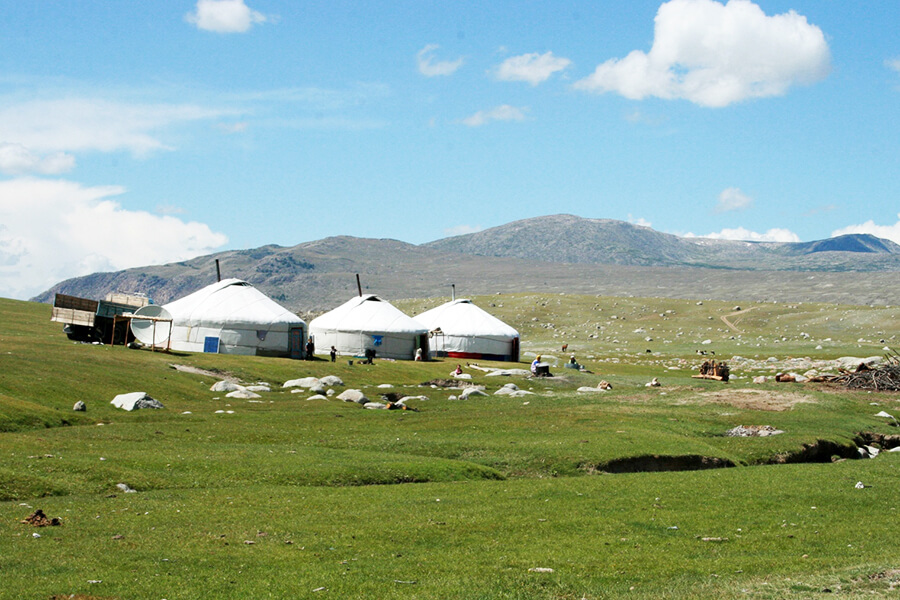
When should I visit Mongolia? And what is the best time to visit Mongolia? Go Mongolia Tours will give you the exact answer for you with this article.
Weather in Mongolia
Located in Central Asia, the country is bordered only by Russia and China. Mongolia has an extreme continental climate with long, cold winters and short summers in which most of the precipitation falls. This country’s days are sweltering and very cold at midnight, varying from 20-30 degrees. Located in a temperate climate zone, the climate of Mongolia is sharply continental. This means that it is characterized by a sharp drop in temperature and a small amount of precipitation.
Mongolia has 4 seasons, winter lasts from November to February, spring from March to mid-May, summer lasts from mid-May to late August, and autumn from September to September. the end of October. The cold period in the North can last for 1 month or more than 2 months in the Gobi desert area.
Spring in Mongolia
After winter, the snow melts, and the animals wake up from hibernation. All the animals and plants here begin a cycle of reproduction and development. In Mongolian “Khansh neekh” means some animals that hibernate, waking up from their sleep. For people and livestock, it can be a harsh season of the driest and windiest days, though temperatures quickly turn warmer in the spring. Finally, spring is a season of prosperity – Of strong beginnings and growth. Starting in March, spring usually lasts about 60 days although it can be as long as 70 days or as short as 45 days in some parts of the country.
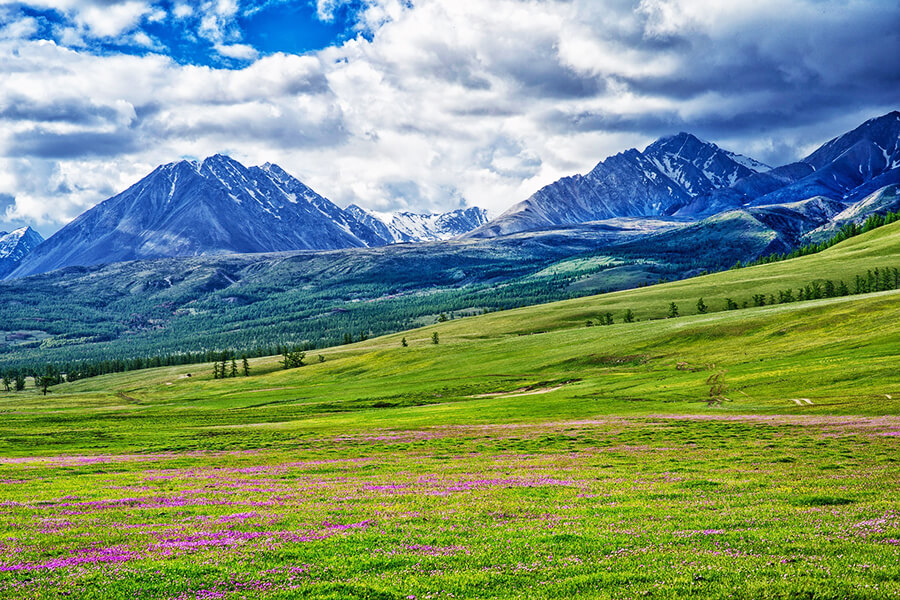
Summer in Mongolia
In the summer, the best time to setup Mongolia Tours is from mid-June to late August. Summer temperatures can be as high as 38 °C (100.4 °F) in the southern Gobi region and 33 °C (91.4 °F) in Ulaanbaatar. In addition, the country’s most famous festival: the “Naadam Festival” is also held in July every year. Visitors in Mongolia will have the opportunity to mingle with the locals and observe and experience the authentic traditional culture here.
According to those who have travel experience in Mongolia, the most suitable time in Summer to come here in July. The weather at this time is extremely cool and pleasant, the day is only hot when the sun is not covered by clouds. Therefore, this is the peak time for tourism, and the demand for accommodation is very high, leading to the phenomenon of the scarcity of accommodation as well as extremely crowded traffic.
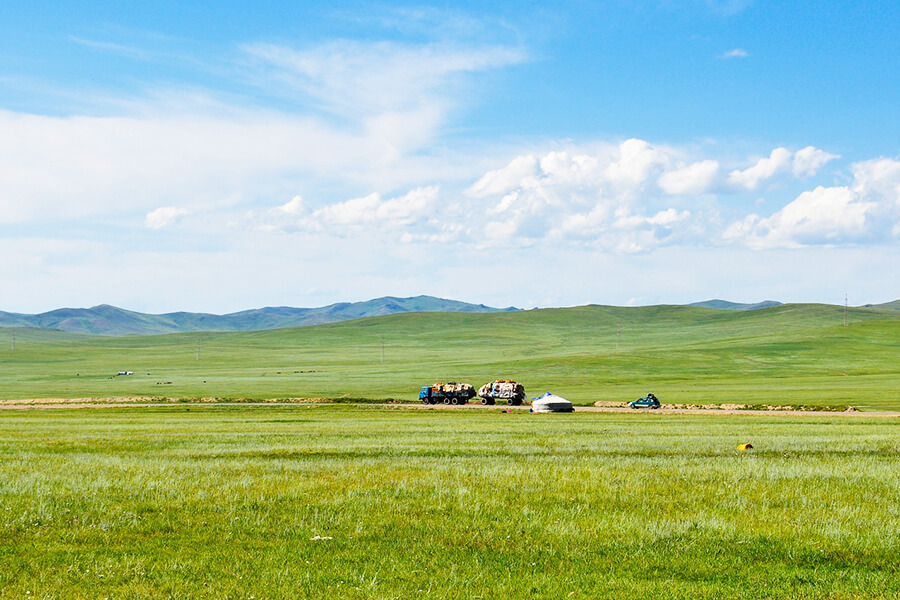
Autumn in Mongolia
In autumn, the climate of Mongolia turns cold and dry with fresh air and a high blue sky. This also is the best season of beautiful for a Mongolia trip. In September, you will see thousands of swans and other migratory birds stopping by the lakes of Mongolia on their journey south. You’ll also see species that don’t normally live in landlocked countries.
Autumn in Mongolia is quite short, only about 2 months and this is known as a time of change of seasons between the heat of summer and the cold of winter. The color of this season is the yellowing of grass, bringing a peaceful feeling to tourists who come to enjoy their trip to Mongolia.
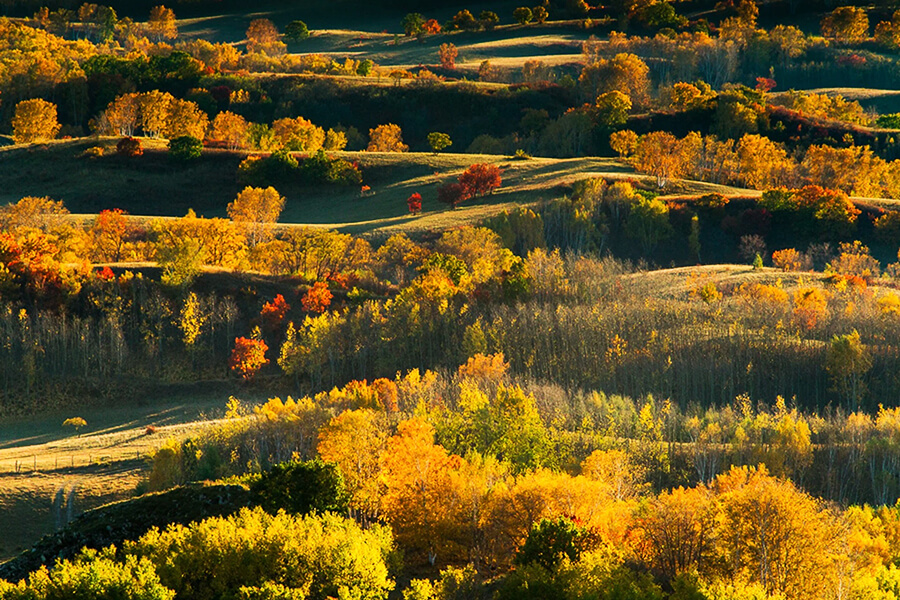
Winter in Mongolia
The weather in this country is often harsh in winter. Due to the influence of the cold Siberian wind, Mongolia’s temperature in winter often drops below minus 40 degrees Celsius. If you want to experience the harsh winter in Mongolia, you can visit the suburbs of the capital Ulaanbaatar. The people here have a semi-nomadic lifestyle, they often set up tents in the valleys or hills in the winter.
The special thing in winter in Mongolia is the festival to celebrate surviving the cold weather. In March, when the weather starts to warm up, the Mongols flock to Khovsgol Lake for a two-day ice festival. The greedy will bring a pitcher of milk, water, black or green tea, and salt, a bag of khuushuur (fried buns filled with meat), and gather together on the frozen lake to celebrate the end of the frozen time, the hardest of the year.
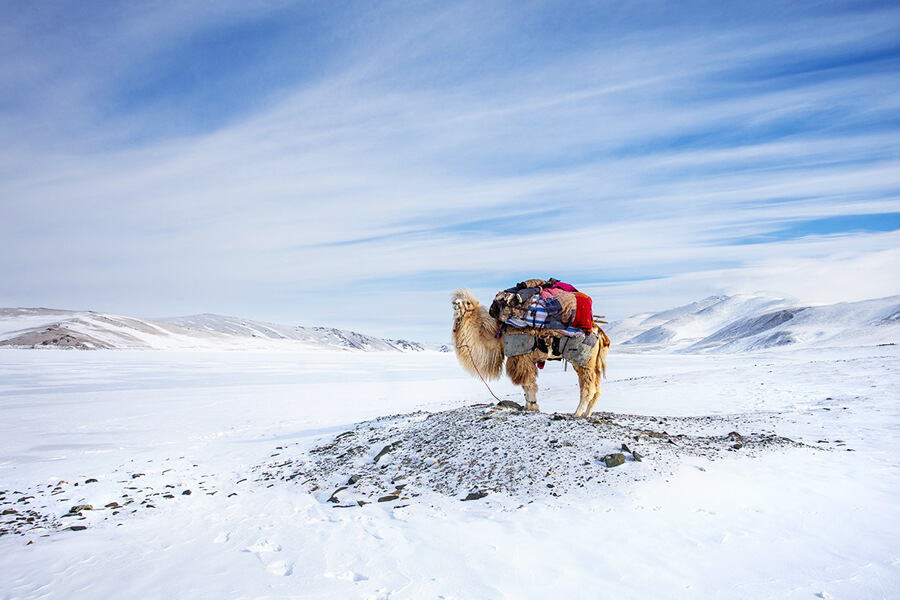

The Best Time to visit Mongolia
The best time to travel to Mongolia is usually from May to early October. July is considered an ideal time to visit Mongolia. The weather is cool, and pleasant, only hot when the sun is not obscured by clouds. However, this is the high time of the tourist season here, the accommodation is not enough and the traffic is very heavy. From late July to August is the wet and rainy season.
The best months to visit the Gobil Desert are September and October. The summer temperature in Gobil is 40 degrees Celsius but winter is windy. You can see snow in the Gobil Desert in late April and some lakes remain frozen until June. There is a short rainy season from mid-July to September. Because of the high pressure, the evenings are cold even in summer. Ulaanbaatar is possibly the coldest city in the world. Temperatures usually start to drop below 0°C (32°F) in October, drop to -30°C (-22°F) in January and February and remain until April. September is probably the most ideal, but this time can still be surprisingly cold.
Attention About Weather in Mongolia Trip
Clothes for mongolia trip.
Regardless of the season in Mongolia, Mongolia’s weather is still extremely harsh for tourists. Because of the large temperature difference between the night and day, whether visitors go in winter or summer, they need to bring warm clothes. In the summer with temperatures that can reach 40 degrees, with the immense green plateaus and clear skies, customers need to bring long-sleeved clothes, sunscreen, and hats to protect their skin from the harmful rays of the sun. Dry wind and hot sun here. With harsh winters that can drop to -40 degrees, travelers enjoying a holiday in Mongolia should wear at least 3 layers of clothing when choosing to visit Mongolia in winter.
The innermost layer should be made of wool or any synthetic material with quick-drying properties. Clothing made of cotton fabrics should be avoided as these are absorbent and can cause moisture or even coagulation. The main purpose of the innermost layer of clothing is to keep the body dry. The middle layer (insulation) also serves the purpose of drying and warming. The outermost layer protects the body from wind and snow, visitors should choose clothes with effective waterproof and windproof properties. In addition to clothes, socks, boots, gloves, hats, and scarves are all essentials for both winter and summer as the nights in Mongolia are cold all year round.
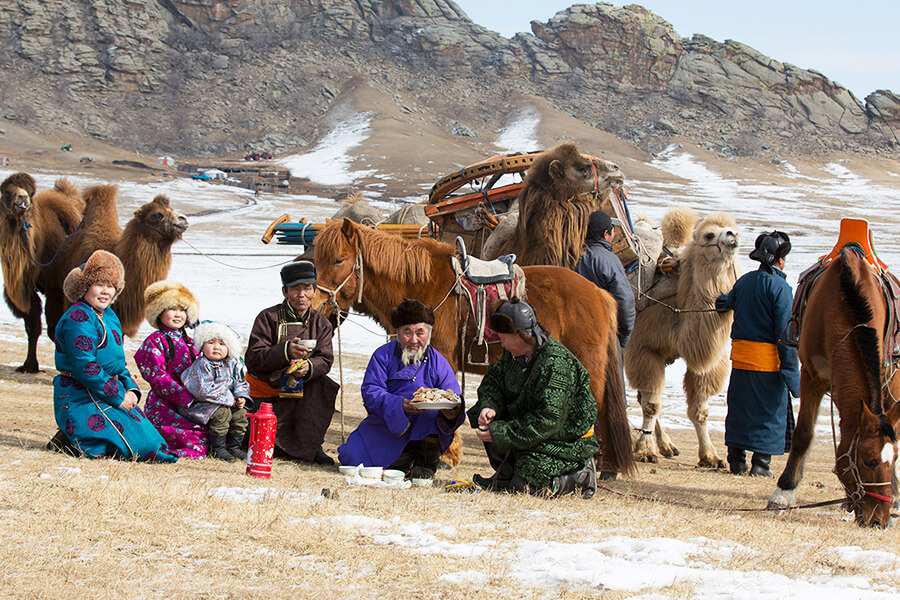
After the weather factor, visitors should also choose appropriate clothing for each activity and destination in Mongolia. Clothing that is easy to put on and take off should also be a priority as it will be easier to equip when traveling to areas such as desserts or savannas. Casual clothing like jeans or tights won’t be an issue when you’re in the capital Ulaanbataar, but it certainly makes it difficult to engage in physical activities like horseback or camel riding. If there is still space, you can choose to bring sunglasses, moisturizer, a camera, or any other items to help you enjoy your trip to the fullest, and remember to always keep your body warm.
Username or email address *
Password *
Remember me Log in
Lost your password?

Mongolia Itinerary: How To Spend 2 Weeks In Mongolia
By Jessie Festa. This guide to planning a trip to Mongolia contains affiliate links to trusted partners.
Need help planning an unforgettable Mongolia itinerary ?
Then you’re in the right place!
Known as the Land of the Blue Sky, Mongolia is renowned for its natural beauty, nomadic heritage, and rich culture, all of which you will experience through the below travel plan.
As this beautiful country is remote and isn’t influenced by mass tourism, it’s possible to enjoy a truly authentic experience while having many of Mongolia’s special places all to yourself.
But, what are the best places to visit within 2 weeks in Mongolia?
The below itinerary shares exactly where to go and what to do – with suggestions for shorter and longer itineraries included. Not only that, but you’ll learn important tips for staying safe and enjoying your trip, plus must-pack essentials.
Ready to embark on an unforgettable trip to Mongolia? Grab your passport and let’s go!
Note: This Mongolia travel itinerary is based on a trip I did with WHOA Travel, a sustainable adventure travel company for women. They work with a local partner, Eternal Landscapes, who focus on immersive and sustainable experiences in Mongolia. I’ll share more below about booking tours and drivers.
⏳ My top Mongolia travel recommendations include: ✈️ Airport Transfer: Book that here 🏨 Hotel: Puma Imperial Hotel (in Ulaanbaatar) 🗺️ Tours: Viator 🎒 Multi-Day Tour Operator: WHOA – use code JESSIEONAJOURNEY for $100 off! 📍 Recommended Excursions: 🐎 Genghis Khan Statue with Terelj National Park & Aryabal Temple 🇲🇳 4-Day Essencence on Mongolia Tour 🛍️ Full-Day Tour of Ulaanbaatar with Museum & Black Market 🥾 Bogd Khan National Park Hiking Day Trip 🥘 Cooking Class: Cooking Class in a Traditional Ger Home in Ulaanbaatar Suburbs 🏥 Travel Insurance: SafetyWing 📞 Staying Connected: Airalo eSIM
Table of Contents
Free Mongolia Itinerary Planning Resources
But first, before we go over tips for planning a trip to Mongolia , I invite you to grab my free Ultimate Travel Planning Kit — which includes 40+ travel resources — from printables to quizzes to itineraries — all meant to help you explore the world beyond the guidebook!
Some highlights of the kit include:
- Free “Where Should You Travel Next?” personality quiz
- Pre-plotted Google Maps for 50+ destinations (including Mongolia)
- Printable travel journal with writing prompts
- Packing lists for different types of trips
Once you’ve grabbed your copy , keep reading for tips for traveling to Mongolia .

Is Mongolia Worth Going To?
As someone who has visited Mongolia , I think it is one of the most special places in the world.
Something really unique about Mongolia is it only receives about 66,900 tourists per year , meaning you can still have a very authentic experience that isn’t watered down to appeal to the masses.
While there are places you go and see a lot, Mongolia is a place you will go and experience a lot – including many that will be unlike anything you’ve ever experienced before!
Is Mongolia Safe?
According to Travel Safe-Abroad , Mongolia has one of the lowest crime rates in Asia and is one of the safest places to travel. Your main concern will be petty theft in Ulaanbaatar – so make sure you know how to avoid pickpockets .
If you’re interested in solo travel in Mongolia, also know that the country is generally safe for female travelers. As always, just make sure to use common sense and keep the usual travel safety tips in mind.

Best Time To Visit Mongolia
The best time to travel to Mongolia depends on where you plan to go, what you plan to do, and your ability to handle extreme heat and cold.
Summer (June-August) is the peak tourism season, with warm weather and important festivals in Mongolia like Naadam taking place.
If you want to enjoy nice weather while saving money on high-season prices, autumn (September to October) and spring (March to May) are also great options. Just note that the latter can still be pretty chilly.
Mongolia’s winters are harsh, though if you can handle the cold you can partake in seasonal experiences like dog sledding and ice festivals.
Getting To Mongolia
If you’re arriving from out of the country, you’ll fly into Chinggis Khaan International Airport in Ulaanbaatar, Mongolia’s capital.
It’s a modern airport with amenities like restaurants, shops, WiFi, and SIM cards for purchase. Additionally, many airlines service the airport, like Turkish Airlines, Korean Air, MIAT, Asiana Airlines, Air China, and more.
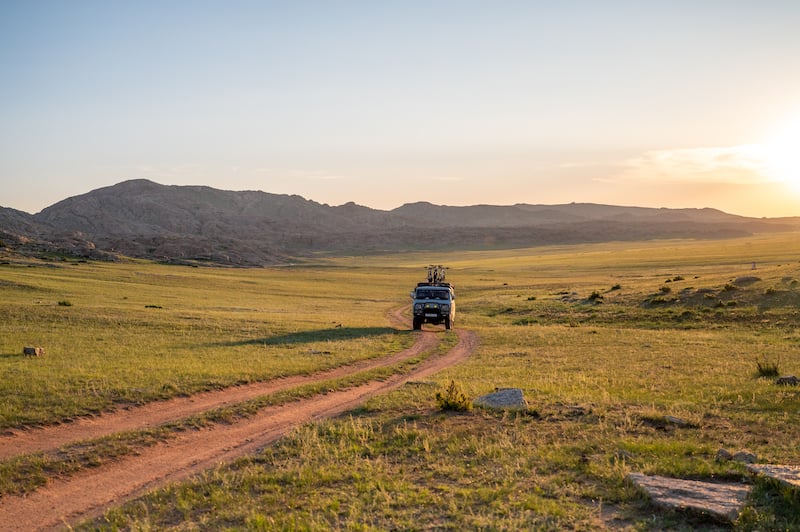
Getting Around Mongolia
In Ulaanbaatar, you can get around on foot and by public bus.
There are also ride-hailing apps like UBCab, though when I tried to use it it required a Mongolian phone number. Alternatively, you can hail a cab on the street by sticking your arm out or call a taxi company to order a car and ask for the driver’s license plate number and arrival time.
To explore Mongolia beyond Ulaanbaatar, it’s highly recommended to hire a driver. Do not try to rent a car, as the roads are typically unmarked, unpaved, and tough to navigate.
You’ll also want to pre-book a driver for getting to and from the airport in Ulaanbaatar, as the drive takes about 1-2 hours. You can book your driver here .
Mongolia Travel Map
To help give you a lay of the land, here is a map for visiting Mongolia. It includes most of the main points and activities mentioned in the below 2 week Mongolia itinerary pre-plotted:
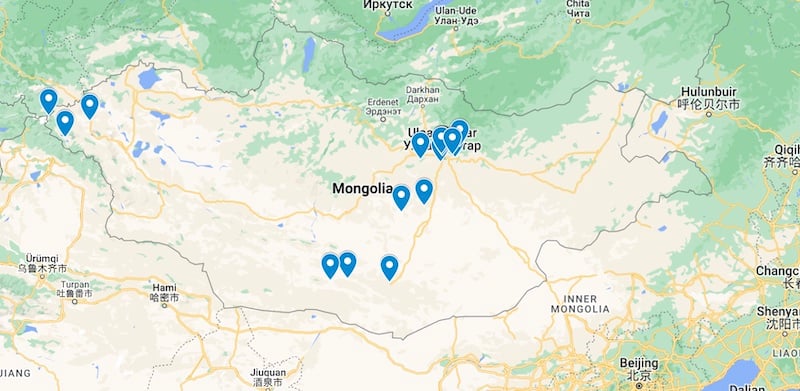
Click here for the interactive version of the above map .
2 Week Mongolia Itinerary (Overview)
Now let’s discuss our recommended Mongolia travel itinerary. With 2 weeks in Mongolia, you can spend:
- 2 days in Ulaanbaatar
- 4 days in the Mongolian Gobi Desert
- 4 days in the Altai Mountains
- 2 days in Hustai National Park
Feel free to adjust the timing of this Mongolia trip based on your preferences.
2 Week Mongolia Itinerary (Full Breakdown)
Now that we’ve quickly gone over where you should go for your Mongolia 2 week itinerary, let’s break down exactly what you should do. These are some of the best places to visit in Mongolia , and the following suggestions can help you really maximize your time in each spot.
Note that this itinerary is based on my own trip to Mongolia with WHOA Travel and their local partner Eternal Landscapes Mongolia – both of which are highly recommended companies!
Stop #1) Ulaanbaatar (North Central Mongolia)
Length: 2 days Tours: Click here for a list of top-rated Ulaanbaatar tours Recommended hotels near the tourist-friendly Chinggis Square area: – Puma Imperial Hotel (my favorite) – H9 Hotel Nine – Shangri-La Ulaanbaatar – Click here for a full list of top-rated Ulaanbaatar hotels Restaurants: -Grand Khaan Irish Pub (wide variety of Mongolian and Western dishes) -Modern Nomads (mix of Mongolian and global fare) -Hazara (delicious Indian food) -Azzurro (Mongolian restaurant with amazing views) -Luna Blanca Vegan Restaurant (Mongolian food is extremely meat-heavy, so head here when you’re craving lighter and more vegetable-forward fare)
Ulaanbaatar is the capital city of Mongolia and is where you can explore the country’s rich heritage as well as its modern present.
Though much of this Mongolia itinerary takes place in the countryside, spending some time in the big city will allow you to adjust to your new surroundings while educating yourself on the local history and culture.
It’s recommended to spend the first day of your Mongolia trip taking it easy and acclimating to the time zone. Grab your camera and wander around the lively Chinggis Square (Sukhbaatar Square), which is frequently used for events, festivals, and concerts.

You’ll also be able to take in some gorgeous views of the city – particularly of the Blue Sky Tower Residence , which looks like the body of a cobra.
Here you’ll also find numerous points of interest like a statue of Chinggis Khaan (Genghis Khan) as well as the Chinggis Khaan Garden , Mongolian State Academic Theater of Opera & Ballet , and the Cultural Palace (which houses the Mongolian National Modern Art Gallery ).
Beyond the square, you can leisurely peruse important institutions like the National History Museum of Mongolia , the Bogd Khaan Palace Museum of Mongolia , and the Zanabazar Museum of Fine Art.
You might also consider visiting Gandantegchinlen Monastery (Gandan Monastery), Mongolia’s largest active monastery. Founded in 1838, it’s one of Mongolia’s only Buddhist monasteries to survive the Stalinist purges , a time when many Buddhist temples were destroyed. Inside, there is a towering 26.5-meter-tall Avalokiteshvara, the Buddha of Compassion, glimmering in gold.
On your second day in Mongolia, you might opt to do another museum – though you should also take a trip to Zaisan Hill Memorial .
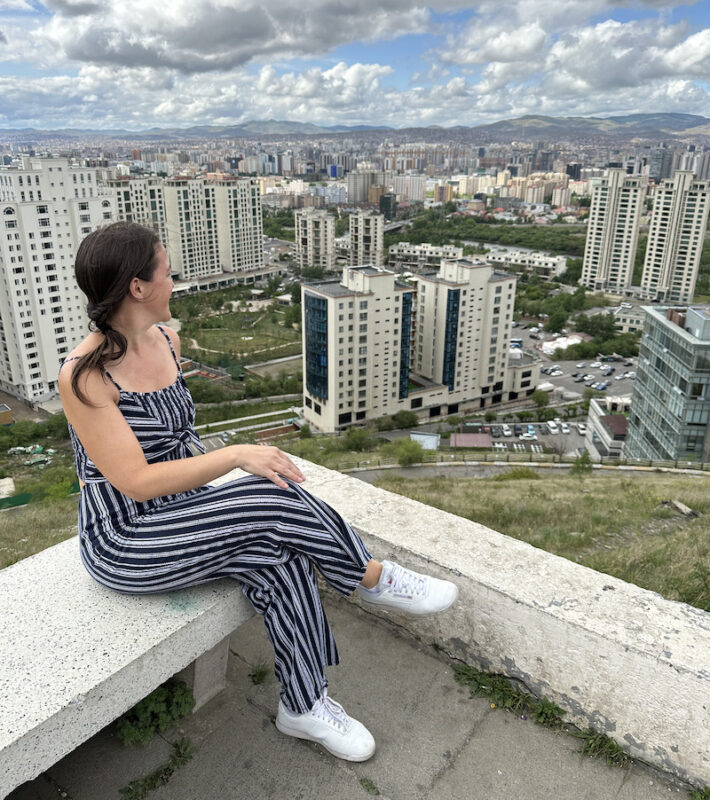
Make sure to eat a hearty breakfast, as you’ll need to walk up 600 steps. Luckily, you’ll be rewarded with 360-degree views of the Ulaanbaatar skyline, the Tuul River, and the surrounding hills and mountains.
For a bit of background, the memorial was built between 1971 and 1974 to show gratitude to the Soviet Union (USSR) for its assistance during Mongolia’s fight against Japanese forces. It features a memorial complex honoring the Soviet soldiers who lost their lives during WWII.
Interested in Ulaanbaatar nightlife? Along with your typical bars and clubs, you can also see a local throat singing performance!
Stop #2) Mongolian Gobi Desert (Southern Mongolia)
Length: 4 days Tours: I was accompanied by Eternal Landscapes for my entire Mongolia itinerary for 2 weeks. No matter what company you go with, you will absolutely want to go with a guide and driver. The roads in the Gobi Desert are unpaved and unmarked, making them extremely hard to navigate. Plus, your guide can act as a translator when needed. Stay: When staying overnight in the Gobi you’ll be camping and/or doing ger homestays organized by your Mongolia tour operator.
No trip to Mongolia would be complete without spending some time in the world-famous Gobi Desert. Spread out over 500,000 square miles (1,300,000 square kilometers), there is a lot to do and see here.
Fun fact: did you know that only 5% of the Gobi Desert is sand dunes ? As you journey through this Mongolia itinerary highlight, you’ll see the landscape morph between grassy steppes, lush valleys, granite mountains, and even rivers and lakes – making it the perfect place for outdoor adventures like hiking and biking.
During my time in the Gobi Desert, I biked from place to place, with support vehicles always nearby.
On the first night, my group camped in Baga Gazriin Chuluu Nature Reserve , which showcases rugged rock formations and towering granite mountains begging to be climbed.
It was incredible sleeping under a sky full of stars and plants (I saw Venus!) and waking up to hike the rock formations at sunrise. There are also horses, mountain sheep, wild goats, and marmots.
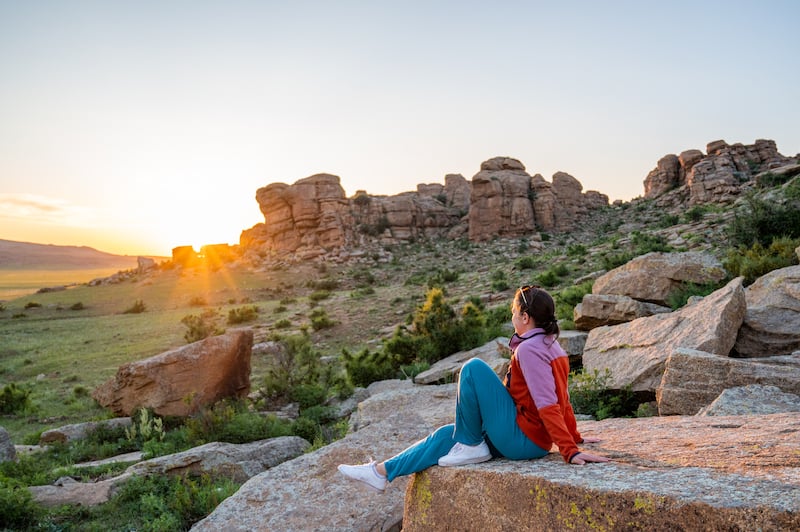
Within the reserve, we also visited the ruins of Chuluun Sum (Rock Temple), believed to be part of the larger Tsorjiin Khuree Monastery. Like hundreds of other monasteries, it was destroyed during the Stalinist purges of the 1930s, though the ruins offer sacred solace as well as sweeping views of the surrounding steppe.
From there, we headed to Jargalant Cave , a striking 18-meter-long cave where you’re forced to belly crawl the deeper you go in.
Continuing on the Gobi Desert portion of the trip, the scenery continued to be stunning and the animal viewing plentiful. Keep your eyes peeled for Bactrian camels, which have two humps. Mongolia is one of the few places in the world where you can see them!
A few other highlights:
- Camping outside the ger home of a local family for a cultural twist
- Planting a tree with the Gobi Tree Planting Project and doing a homestay with the founder’s family
- Seeing a local concert in the town of Erdenedalai
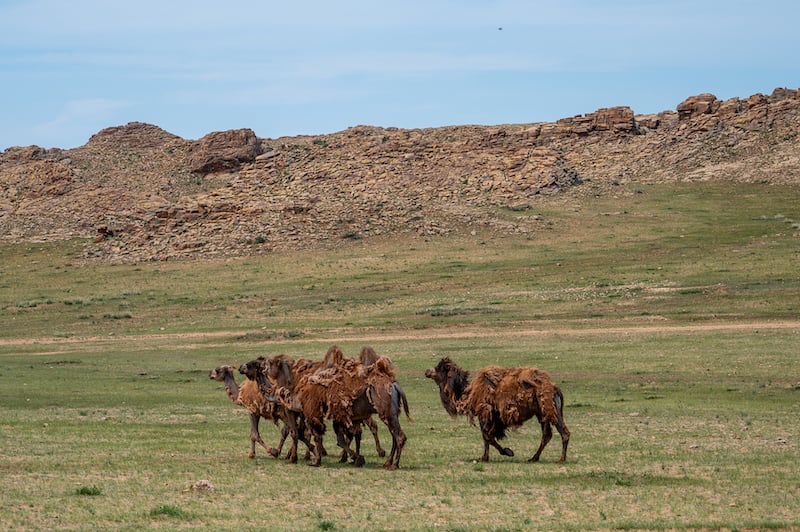
Alternative Gobi Desert Itinerary
Alternatively, another option for this portion of your Mongolia itinerary is to fly from Chinggis Khaan International Airport in Ulaanbaatar to Dalanzadgad Airport to begin your Gobi Desert journey at Bayanzag .
Also known as the Flaming Cliffs thanks to their bright red color, Bayanzag is a famous paleontological site where dinosaur eggs and fossils have been found.
From there, you can travel to the Khongor Sand Dunes , which are some of Mongolia’s largest white dunes. When it is windy, they make a unique sound that leads people to also call them the “Singing Dunes.” You can climb to the top of the dunes to take in gorgeous Gobi Desert views and then slide down for a unique experience.

The dunes are located within Gobi Gurvansaikhan National Park – Mongolia’s largest national park; so on the final days, you can continue exploring its beauty.
This name translates to “Three Beauties of Gobi,” a nod to three beautiful subranges: Western Beauty, Middle Beauty, and Eastern Beauty.
One place of interest within the park is the Yol Valley , which narrows gradually into a stunning gorge as you move through it.
After your time in the Gobi Desert, fly back to Ulaanbaatar.
Stop #3: Altai Mountains (Western Mongolia)
Length: 4 days Tours: I was accompanied by Eternal Landscapes for my entire time traveling in Mongolia. No matter what company you go with, you will absolutely want to go with a guide and driver. The roads in the Altai Mountains are unpaved and unmarked, making them extremely hard to navigate. Plus, your guide can act as a translator when needed. Stay: When staying overnight in the Altai Mountains countryside you’ll be camping and/or doing ger homestays organized by your Mongolia tour operator.
The main reason I love Mongolia is its natural beauty, which really shines in the Altai Mountains. Personally, this was the main highlight of traveling to Mongolia, as the region is one of the most stunning I have ever seen.
Stretching across China, Kazakstan, Mongolia, and Russia, the snow-capped mountains, lush valleys, glacial lakes, and crystal rivers of the Altai region beg you to stay a while and explore the outdoors.
From Ulaanbaatar, you’ll fly into Ölgii Airport , the gateway to the Bayan-Ölgii Province . From here, you’ll journey by car for about 4-6 hours into the Mongolian countryside.
While you can camp, it’s highly recommended to spend some of your time doing a ger homestay with a local Kazakh family to learn more about their way of life as nomadic herders. Many Kazakh people fled political unrest in Kazakhstan in the late 19th and early 20th centuries, ending up in Mongolia.
Today, you can immerse yourself in their culture through activities like learning how they hunt with eagles, Kazakh embroidery, helping tend to the farm animals and cooking, listening to traditional Kazakh music, eating Kazakh foods, sipping milk tea, and simply spending time with them.
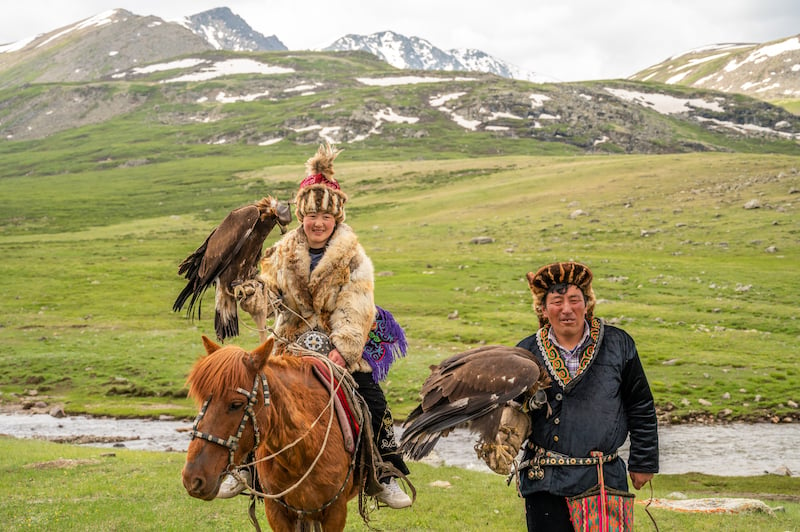
On the first night of my homestay, I was welcomed with a feast that included beshbarmak , a Kazakh dish of boiled meat like mutton and horse as well as thick flat noodles. The name translates to “five fingers” in Kazakh, referring to the traditional way of eating the dish with one’s hands.
While visiting the Altai Mountains , you’ll undoubtedly do a lot of hiking. One incredible place to do this is Altai Tavan Bogd National Park , which encompasses 6,362 square kilometers (2,456 square miles) of beauty.
Some highlights of the national park include:
- Khuiten Peak , the highest peak in Mongolia (the park is actually home to the five highest in the country)
- Potanin Glacier , the largest glacier in Mongolia
- Ancient rock art and petroglyphs (which are considered a UNESCO World Heritage Site)
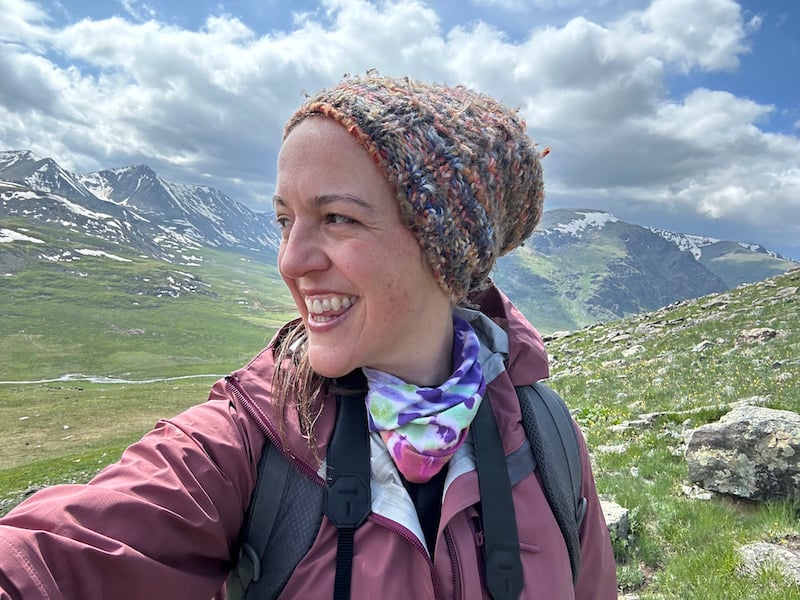
Along with hiking, you can enjoy activities like horseback riding, mountain climbing, fishing, and spotting wildlife like ibex, argali sheep, and snow leopards.
Once you’re done with your adventure, fly back to Ulaanbaatar.
Stop #4: Hustai National Park (Central Mongolia)
Length: 2 days Tours: Click here for a list of top-rated tours to Hustai National Park from Ulaanbaatar – including a day tour of the park if you’d like to do a shorter trip. Stay: When staying overnight near Hustai National Park you’ll be camping and/or doing ger homestays organized by your Mongolia tour operator.
Located about 2-3 hours by car from Ulaanbaatar – including a mix of highway and off-roading – Hustai National Park is known for its wildlife, particularly its wild horses.
Interestingly, the park was originally created to reintroduce Takhi or Przewalski horses in 1992 – which, according to my guide, are the world’s only true wild horses.
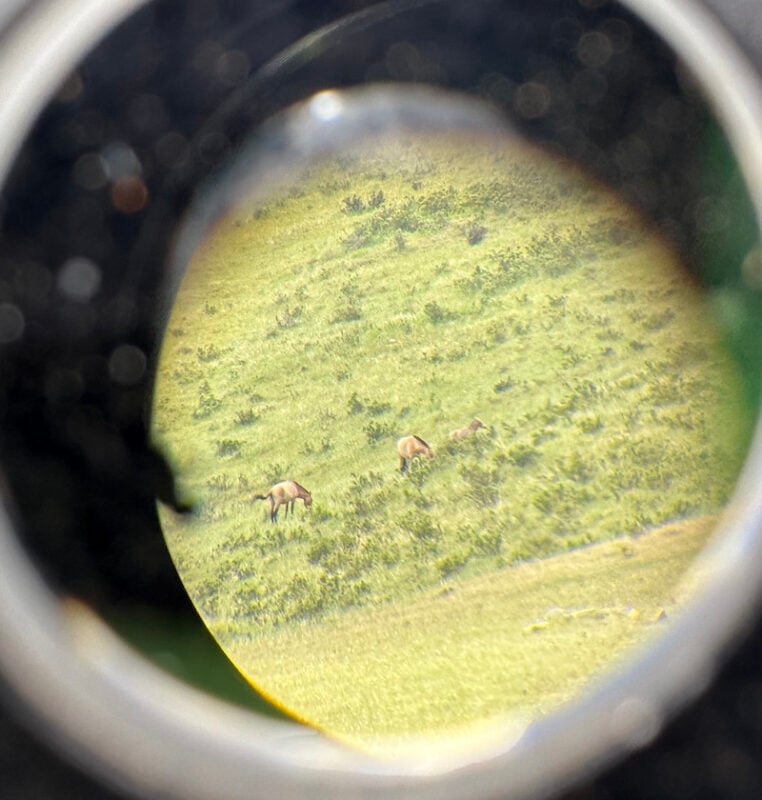
The main activities in the park are:
- Visiting the museum and gift shop
- Doing a wild horse game drive
- Hiking to enjoy the beautiful scenery and see wildlife like red-footed falcons, red deer, eagles, and marmots
- Bird watching
- Horse riding and camel riding
It’s also a great place to stay with a local family in a ger for some cultural immersion. I stayed with the Batchuluun family just outside of the park, who taught me how to do traditional Mongolian felt-making. I even got to make my own pair of earrings!
Another highlight of the homestay was enjoying a traditional Mongolian barbecue ( khorkhog ). For this, large river stones are collected to be heated and used in the cooking process.
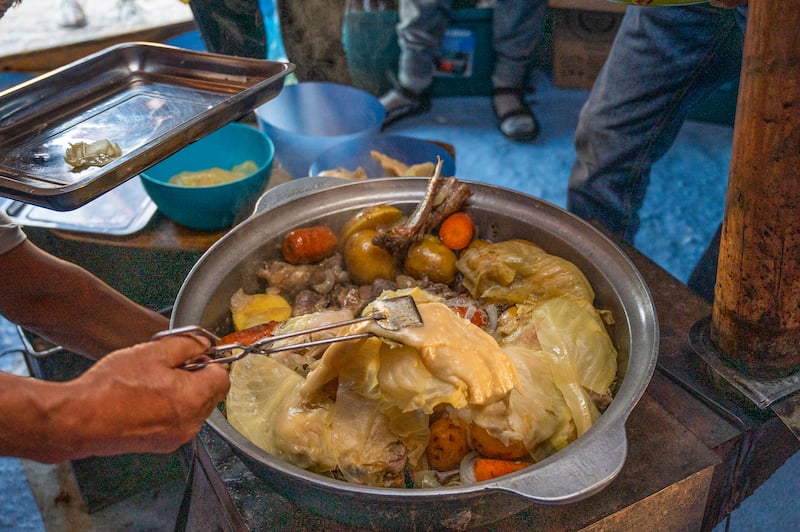
The meat – typically mutton, and we also had chicken – is cut into small, bite-sized pieces and seasoned with salt. Additionally, my hosts added veggies like large carrots, potatoes, and cabbage.
When it’s time to cook the meat, a large pot is heated using the stones – which are also added inside the pot. Basically, you layer the stones, then the meat and ingredients, and repeat this process. Thick dough is added at the top to help seal the heat.
The ingredients are cooked for several hours, allowing them to tenderize. Yum!
Stop #5: Ulaanbaatar (North Central Mongolia)
Finish up your Mongolia tourism experience back in the capital enjoying some of the experiences you didn’t get to do at the beginning and adding on some new ones.
When it comes to what to see in Mongolia, one popular activity is a day tour of the giant Genghis Khan Statue, Terelj National Park, and Aryabal Temple .
The statue is the largest horse statue in the world at 40 meters tall, and you’ll be able to climb to the top.
Additionally, you’ll hike the uniquely-shaped Turtle Rock and to Ariyabal Meditation Temple , the latter of which is a peaceful place known for its beauty and panoramic views. For many, it’s an Ulaanbaatar itinerary highlight!
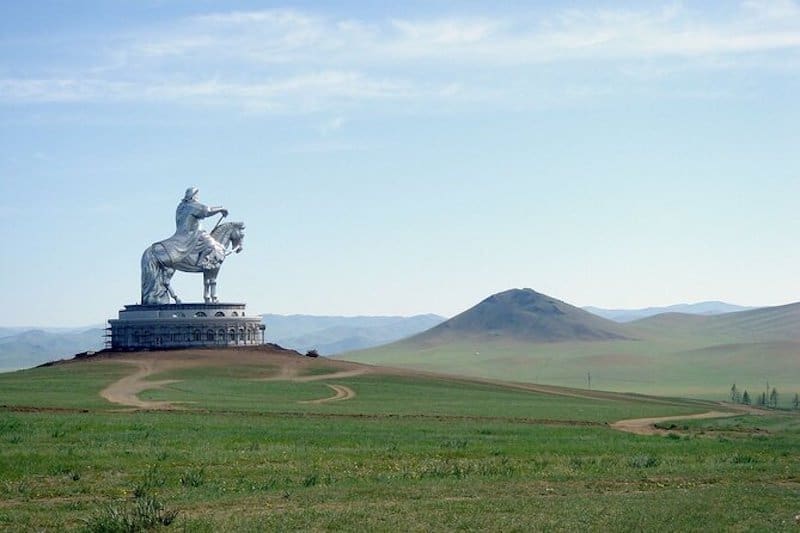
Shorter Mongolia Itineraries
Short on time? Here is how I would tweak the itinerary if you have less than 2 weeks in Mongolia:
5 Days In Mongolia . If your trip is only 5 days, I’d personally start and end in Ulaanbaatar and spend the middle 3 days in the stunning Altai Mountains.
Alternatively, you might choose to base out of Ulaanbaatar and do driveable trips to Gorkhi-Terelj National Park and Hustai National Park. You could also do a day trip to Elsen Tasarkhai for a Semi Gobi Experience .
7 Days In Mongolia. With one week in Mongolia, I’d stick to Ulaanbaatar as well as driveable trips from the city. Additionally, I’d include 3-4 days in the Altai Mountains.
10 Days In Mongolia. With 10 Days in Mongolia, I’d keep the above 2-week itinerary almost the same except I’d cut Hustai National Park and spend one less day in the Gobi Desert and one less day in Ulaanbaatar.
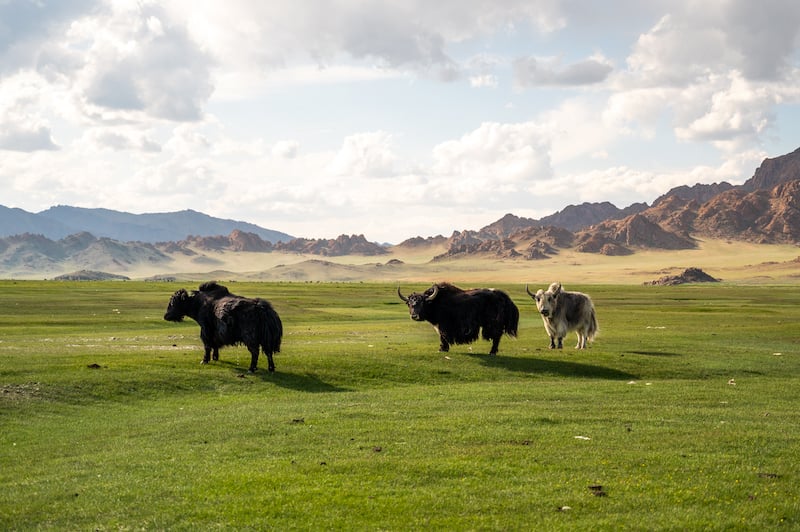
Bonus Destinations For A Mongolia Itinerary
Are you spending 3 weeks in Mongolia, or maybe you want to swap out a different destination for something else?
You can see a long list of recommended Mongolia destinations here, a few of which include:
Lake Khovsgol National Park (Northern Mongolia). Also known as Khövsgöl Nuur National Park, it showcases 8,865 square kilometers (3,423 square miles) of natural beauty, outdoor adventures, and wildlife like the Siberian ibex, argali sheep, Eurasian lynx, and the gray wolf. You can also visit Lake Khövsgöl — aka the “Blue Pearl,” one of Central Asia’s largest and deepest freshwater lakes.
Tsagaan Suvarga (Southern Mongolia). Also known as the White Stupa, this Mongolia attraction showcases huge limestone cliffs that look like a row of stacked stupas in the Gobi Desert.
Orkhon Valley (Central Mongolia). This is a popular addition to a Mongolia itinerary due to its historical, cultural, and natural significance. Take in the astounding beauty of the landscape and also make sure to see Mongolia’s largest waterfall, Ulaan Tsutgalan (Orkhon Waterfall).
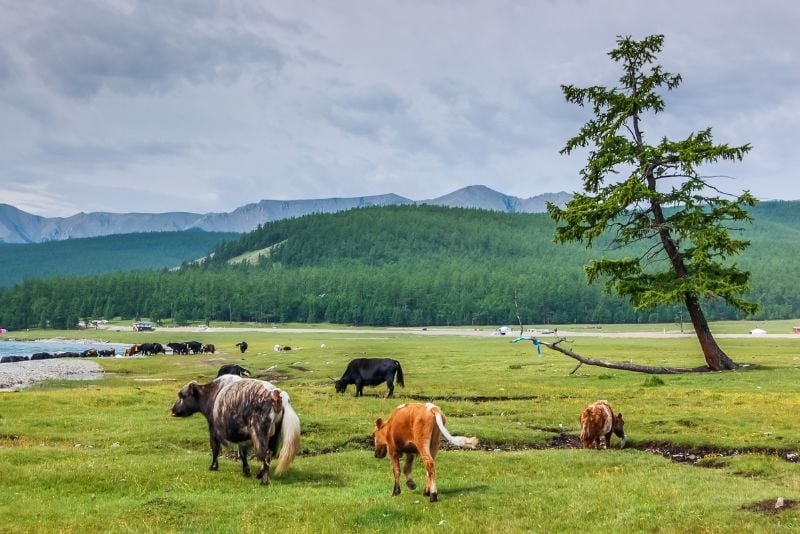
Tips For Planning A Trip To Mongolia
The following advice can help you maximize your Mongolia itinerary:
Consider booking a tour. As I stated in the introduction, my trip to Mongolia was with WHOA Travel and their local partner organization, Eternal Landscapes . Both companies were absolutely fantastic and made traveling through Mongolia a lot easier.
Not only that, but having a local guide allowed me to have experiences I wouldn’t have been able to find on my own while also immersing myself in the local culture. For instance, I did a number of ger homestays, and would not have been able to communicate with my hosts had it not been for my local guides.
Hire a driver. While Ulaanbaatar is a typical city with clear street signs and addresses, traveling through more remote places like the Gobi Desert and the Altai Mountains isn’t as straightforward.
I was constantly amazed at how our drivers were able to figure out where we were going when there wasn’t any signage for hours. For this reason, and because the roads are rough, it’s recommended to go with a tour or at least hire a local driver when you travel to Mongolia.
Realize there will be a lot of travel time and bumpy roads. Along with spending a lot of time in the car, you’ll be going over bumpy and uneven terrain. I suggest doing some yoga or stretching before getting in the car, and having podcasts and audiobooks downloaded for entertainment.
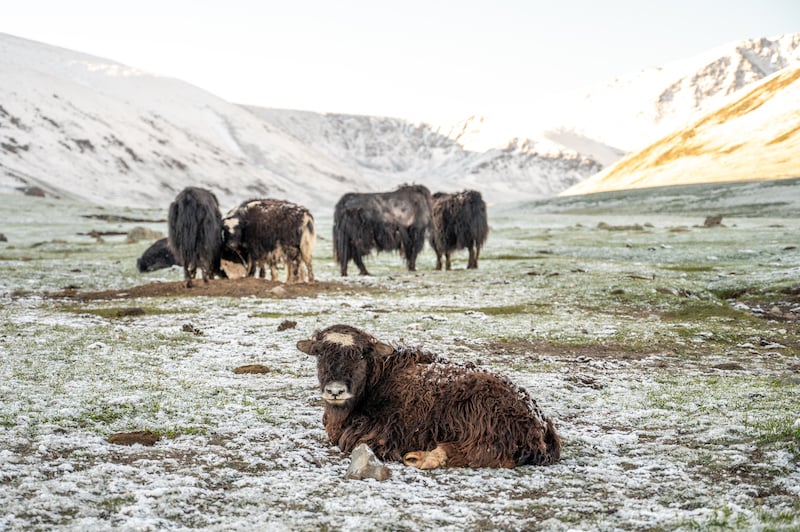
Prepare to eat a lot of meat and dairy. During my 2 weeks in Mongolia, I was offered mutton at almost every meal. Luckily, as a vegetarian, my Eternal Landscapes guides were able to prepare special meals for me.
Additionally, dairy is a huge part of Mongolian culture since many people rely on herding livestock for their livelihoods. When you stay in a ger camp, you’ll always be offered some type of milk or milk tea, which is a sign of hospitality. It is rude to refuse, so drink up.
Always carry toilet paper. In the Mongolian countryside and at your ger homestays, you’ll be going to the bathroom in a hole in the ground. Additionally, even in the city, many bathrooms don’t have toilet paper – so make sure to carry your own.
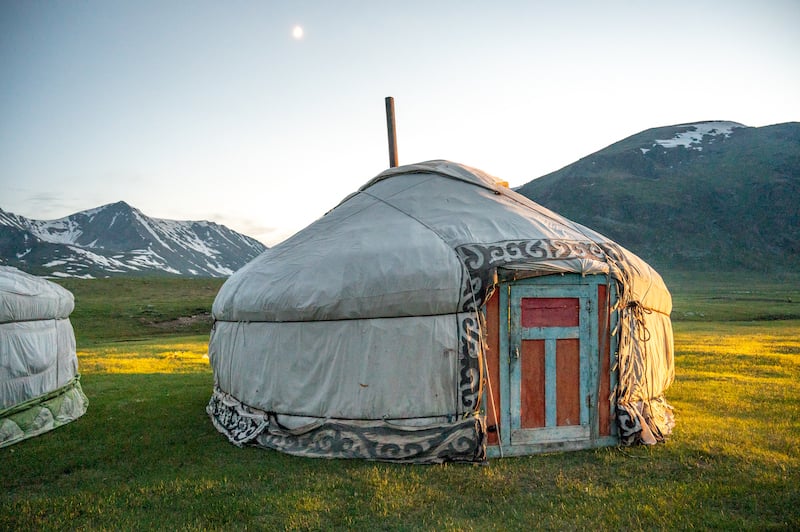
What To Pack For A Trip To Mongolia
Along with your regular packing essentials, clothing, toiletries, and medications, a few specialty items to bring include:
Hygiene Items
- Toilet paper
- Biodegradable cleansing wipes
- Hand sanitizer
Hydration & Sun Protection
- Water bottle or hydration bladder
- Portable water filter
- Chapstick with SPF
- Polarized sunglasses
Camping & Homestay Essentials
- Sleeping pad
- Sleeping bag
- Sleeping liner
Outdoor Adventure Essentials
I found these items particularly important when visiting the Altai Mountains:
- Down jacket
- Rain jacket
- Daypack with waterproof cover
- Hiking snacks
- Moisture-wicking base layer
- Hiking boots with Gore-Tex
- Moisture-wicking socks
- Sock liners
- Moleskine adhesive
Other Items To Bring
- Gifts for your host family (optional, but appreciated)
- Portable charger since there aren’t outlets
- Travel insurance — essential to make sure you’re always protected
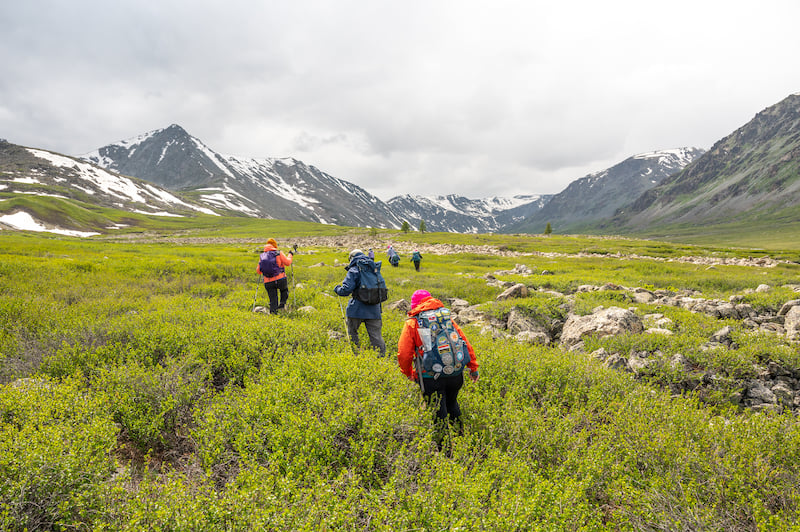
Mongolia Travel Itinerary Planning FAQ
Here are answers to frequently asked questions about planning the perfect Mongolia itinerary:
Q: How many days are enough for Mongolia?
When it comes to how long to spend in Mongolia, realize the country is large and that travel times between places can be long. For this reason, it’s recommended to spend a minimum of 10 to 14 days in Mongolia to see some of the main highlights.
Q) Is Mongolia friendly to American tourists?
Hospitality is deeply rooted in Mongolian culture, and locals are typically friendly and welcoming to all tourists, including Americans.
Q) Is Mongolia a cheap place to visit?
In general, Mongolia is considered to be an inexpensive travel destination. Budget travelers can expect to spend around $30 to $50 per day, while mid-range travelers may spend approximately $70 to $100 per day.
Q) Is it possible to do an independent trip across Mongolia?
While it is possible, it is highly recommended to book a tour or at least a driver, as roads outside of Ulaanbaatar tend to be unmarked, unpaved, and very hard to navigate. Additionally, a guide can help you communicate with your ger homestay hosts, who most definitely won’t speak English.
Q) What are some typical Mongolian foods to try?
A few traditional Mongolian foods to try include buuz (meat dumplings), bansh (smaller dumplings typically boiled in soup or fried), and khorkhog (authentic Mongolian barbecue).
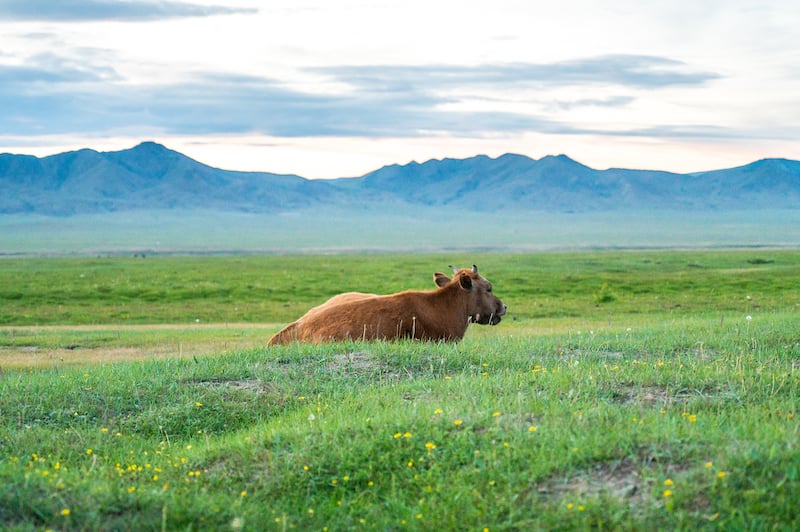
Mongolia Travel Insurance
When visiting Mongolia — or anywhere else in the world — it’s wise to get travel insurance.
One of the best travel medical insurance for travelers is SafetyWing as they’ve got a large network and offer both short-term and long-term coverage — including coverage if you’re traveling for months as well as limited coverage in your home country.
Additionally, SafetyWing is budget-friendly and offers $250,000 worth of coverage with just one low overall deductible of $250.
Click here to price out travel insurance for your trip in just a few clicks .
Final Thoughts On Planning A Trip To Mongolia
I hope you enjoyed this Mongolia travel blog! There are so many incredible places to visit when traveling or backpacking in Mongolia.
Whether you want to use domestic flights to get around, do day trips from Ulaanbaatar, or create more of a Mongolia road trip itinerary, you can enjoy spectacular scenery and rich culture.
And if you follow the above-mentioned Mongolia travel guide, you’ll experience some of the best the Land of the Blue Sky has to offer.
What would you add to this Mongolia itinerary?
Related posts:.

Hi, I’m Jessie on a journey!
I'm a conscious solo traveler on a mission to take you beyond the guidebook to inspire you to live your best life through travel. Come join me!
Want to live your best life through travel?
Subscribe for FREE access to my library of fun blogging worksheets and learn how to get paid to travel more!

Turn Your Travel Blog Into A Profitable Business
Subscribe to my email list to snag instant access to my library of workbooks, checklists, tutorials and other resources to help you earn more money -- and have more fun -- blogging. Oh, and it's totally FREE! :) // Privacy Policy .
Check your inbox for your welcome email + resource library password!
Leave a Comment Cancel Reply

Borders Of Adventure
Leading Culture and Adventure Travel Blog by Becki Enright. Looking at the world with a different angle to change perceptions of misunderstood places, for the best in travel.
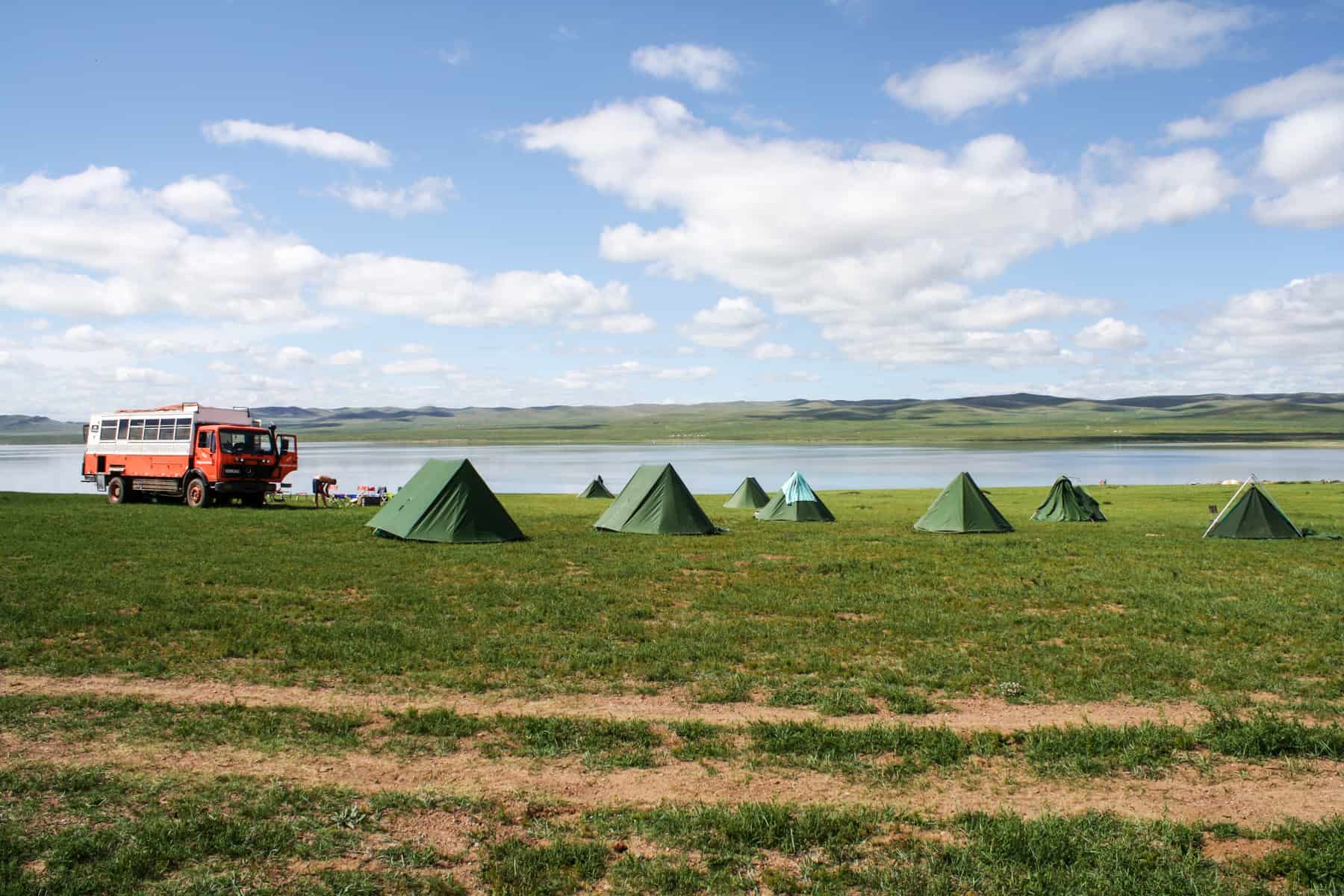
Adventure Travel , Mongolia
This is How to Travel to Mongolia – Overlanding the Least Densely Populated Country in the World
Disclaimer: This post contains affiliate links to handpicked partners, including tours, gear and booking sites. If you click through or buy something via one of them, I may receive a small commission. This is at no extra cost to you and allows this site to keep running.
Want to get to somewhere lesser-known and travel differently? This Mongolia travel guide shows how to go overlanding in the world’s least densely populated country.
Travel to Mongolia means tackling a land of extremes. Both in the landscape, from its vast desert lands and towering dunes to its lush green mountainous national parks, and in its lack of infrastructure, where you become just as frustrated as you are in awe by the country’s areas of extreme isolation.
Visiting Mongolia is to find a canvas of rugged beauty capped by a sky so blue that pollution isn’t even a word that exists here. Passing only wild horses, herds of cattle, an isolated ger in the distance, and the odd truck also on its way to the city, life here is at its purest and most beautiful.
Outside of its unkempt capital, Ulaanbaatar, Mongolia exists with limited facilities, but that’s what makes it attractive. On the road, it can take hours of driving before you pass a small ger community, a Mongolian on horseback or another vehicle, and in between blessed with the most stunning views of a country so desolate that you know you’ve reached the real heart of it.
Overlanding through Mongolia, rather than flying or taking the train, is one of the best decisions I have ever made. This guide will show you how to travel Mongolia from China by land, in a vast loop that takes in some of the country’s most treasured hotspots and wilderness hideaways.
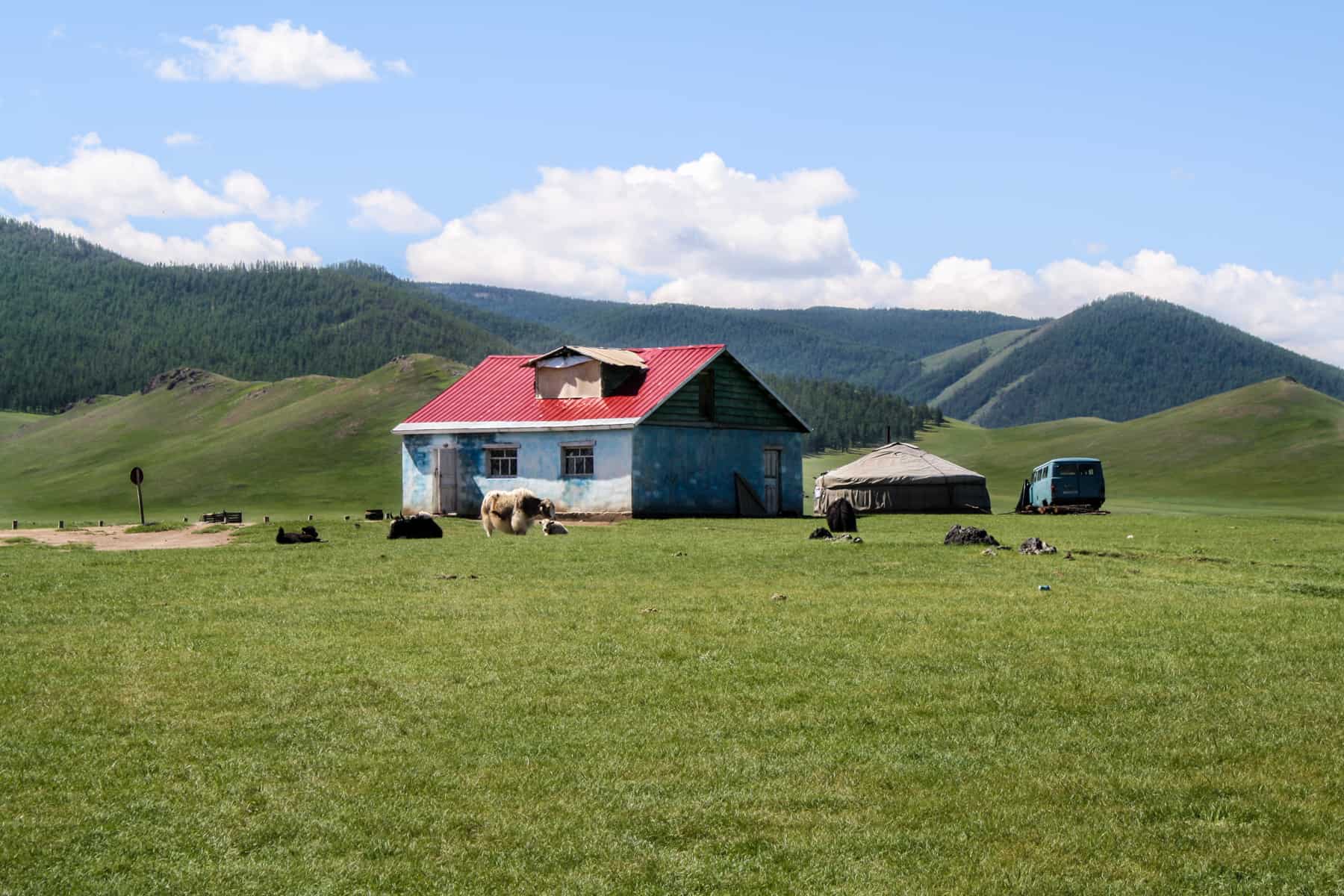
Visit the Least Densely Populated Country in the World
Off the beaten track adventure, when is the best time to go to mongolia, it pays to know a local, classic nomadic mongolia, local living mongolia, discover mongolia – national geographic journeys, experience the naadam festival in mongolia, is mongolia expensive to travel, mongolia visa on arrival, visa-free access to mongolia, day 1: visiting ulaanbaatar, day 2: getting from ulaanbaatar to the gobi desert, day 3: visit the baga gazryn chuluu rock formations, day 4: sleep at a ger camp in the gobi desert, day 5: dalanzagad to gobi discovery ger camp, day 6: hiking in yolin am – mongolia’s ice valley, day 7: a trip to the gobi desert khongoryn els sand dunes, day 8: visiting the bayanzag flaming cliffs, day 9: seeing ongii monastery and driving to arvaikhee, day 10: stuck in mongolia, day 11: hiking in orkhon valley, day 12: seeing the orkhon valley waterfalls, day 13: visiting a mongolian family in a ger, day 14: erdene zuu monastery in kharkhorin, day 15: camping at ugii lake, day 16: visiting hustain national park and seeing przewalski’s horses, day 17: driving to ulaanbaatar and visiting terelj national park, day 18: hiking terelj national park and seeing turtle rock, day 19: a trip to the ghengis khan statue on the tuul river, day 20: back to ulaanbaatar, how to overland in mongolia, building a road in mongolia, getting stuck in the mud, the unexpected river crossing, what to pack for mongolia, planning mongolia travel pin it, why travel to mongolia .
Mongolia travel changes you and makes you appreciate the beautiful patches on the earth’s surface not ruined by extreme modernisation, pollution and overpopulation.
My time in Mongolia meant experiencing everything from bush camping to ger camps, being at one with nature (and not care who sees you squatting in the process) and realising that animals like to roam and Mongolians love to chat – right outside your Ger from 5 am.
I saw a night sky so clear that I didn’t think you could ever see so many stars. I traversed a land so serene in isolation and culture so welcoming that I hope it never, ever becomes ruined by tourist traps or the tight grips of mass capitalism (currently contained to Ulaanbaatar).
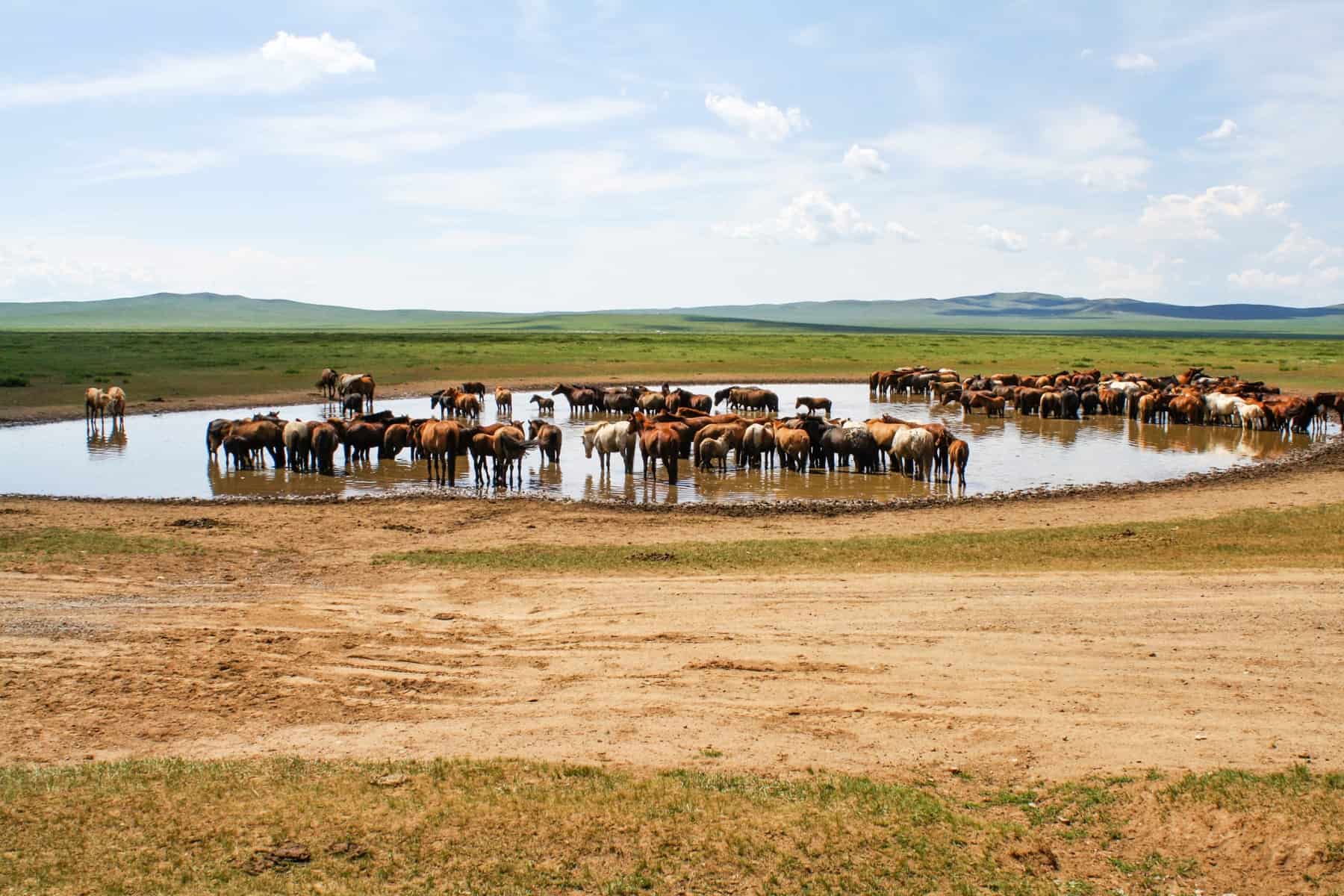
Wild horses in the vast Mongolian landscape
If you want to get off the beaten track, not be on any set grid and take each day as it comes, you will love Mongolia. But this also comes with its frustrations where you need droves of patience and a good chunk of travel time to spare.
There are hardly any roads. Roads are dirt tracks or pre-made grooves in the land pointing the way, and paved highroads are very few and far between.
Mongolia is prone to unpredictable weather conditions. That means random onslaughts of rain and the likelihood that you are likely to get bogged at some point. There were countless numbers of times where we had to dig out and push the truck or find locals to come to the rescue – tractors are a saving grace here.
It’s a vast country that you could get lost in for weeks on end, and when you accept the setbacks, you start to see them as part of the big adventure – travel at its most raw. Back to basics, getting dirty and struggling with the lack of modern amenities we too often take for granted is part of what travelling in Mongolia is all about.
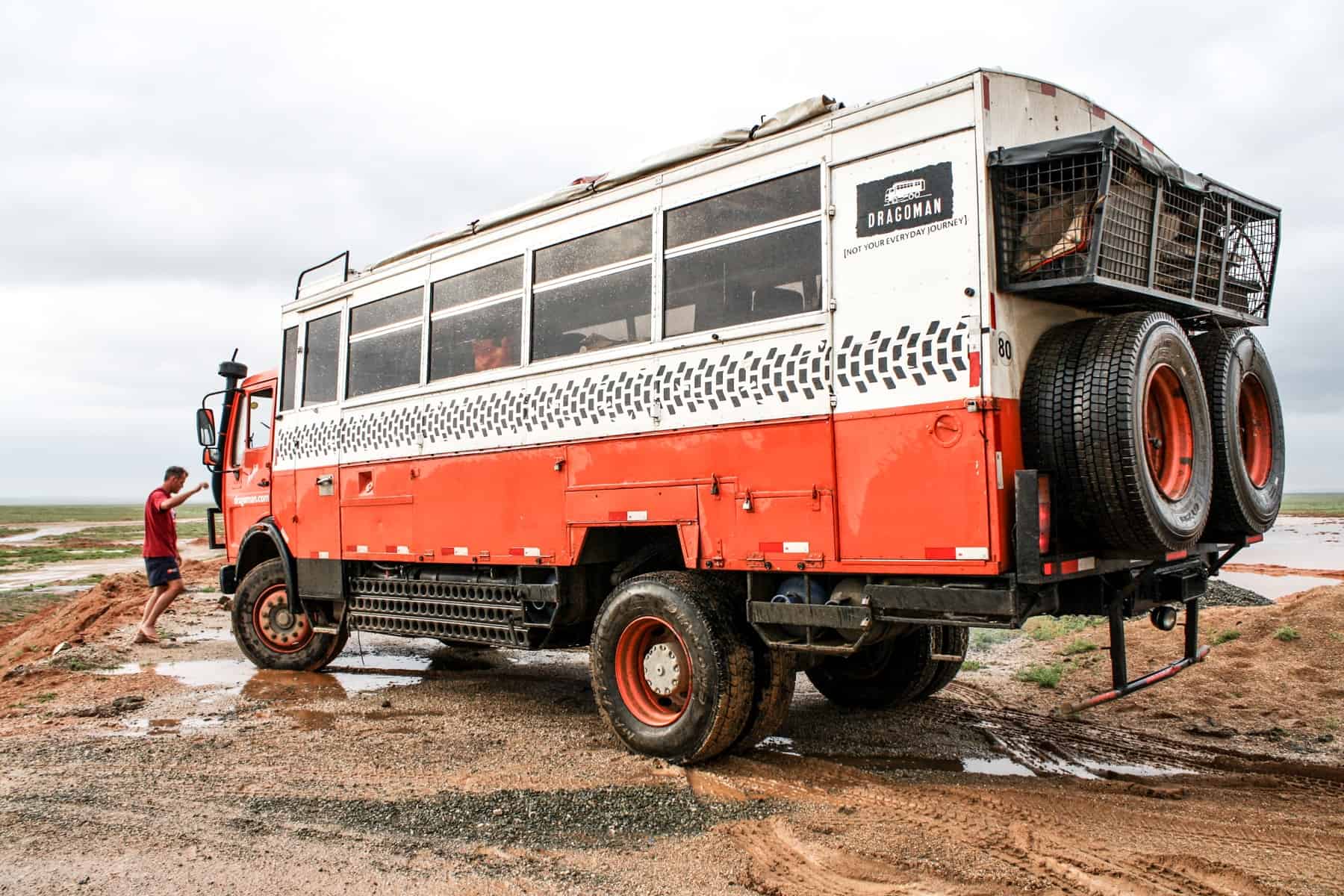
The Overlanding vehicle used to travel to Mongolia and around.
The summer season between May to September is said to be the best time to go to Mongolia. July and August are the hottest months, with temperatures in the Gobi Desert reaching 40°C. Rainfall is at its highest between June and September, balancing out the heat while keeping the forest and valley lands, in particular, lush and fertile. I travelled to Mongolia in July and experienced a lot of rainfall alongside high temperatures.
Mongolia’s winter season is from November to February. While some people like to experience the landscape in this snowy season, temperatures can drop to below minus 20°C – a harsh and challenging environment to travel in. You’ll find that not many companies run tours during this time.
Is it Safe to Travel to Mongolia Safe?
While petty crime and pickpocketing are common in the capital, Ulaanbataar, Mongolia is a relatively safe place to travel, and I never encountered any significant problems. It pays to be more streetwise and alert in the city, as you would in any other. As the landing and departure point for tourists, opportunism poses a higher risk.
Despite the lack of infrastructure and the relative isolation when travelling through the country, the only minor issue we encountered was related to the high levels of alcoholism in the country. We saw drunk drivers on our long drives and an occasion or two when inebriated locals came to our makeshift camp out of curiosity. Even then, it never felt threatening, and we were always within the safety of our group.
On the whole, we rarely saw other people, and when we did, we were met with kindness, invited into homes and welcomed into common spaces such as markets and small-town social spaces.
I also travelled alongside a Mongolian guide – someone who could speak the language when we got stuck, who could walk to a nearby home and explain the need for assistance and who understood the land’s general navigation. Therefore, in Mongolia, it pays to get yourself a local guide, join a small group tour, formulate a small group of your own in Ulaanbataar or be equipped with general wilderness survival skills if going out there entirely on your own.
Mongolia Tours
When I was planning my trip to Mongolia, Dragoman was the only company offering Mongolia tours that lasted from ten days to two weeks. The 21-day overland journey was the first trip itinerary of its kind they were running here, which included Inner Mongolia. Today the 21-day trip, called Nomads & Wilds of Mongolia, is on a loop from Ulaanbaatar and includes Khovsgol Lake in the north. Although Dragoman suspended operations during the pandemic, they are back in 2024.
Adventure travel experts G Adventures, offer Mongolia tours that all start and end in Ulaanbaatar.
A 14-day trip, including all the highlights at an affordable price (from €1999), this Mongolia trip includes a Gobi Desert and Mongolian Grasslands stay, alongside packing in the major historical must-sees and cultural experiences that make Mongolia an unforgettable adventure.
This 10-day local living trip includes staying with three different families in Gers to experience life as a nomad. Mix historical monuments with cultural moments, exploring pastures, forests, lakes and national parks by foot and horseback while helping your host families prepare traditional dinners and learn the skills of their nomadic trades.
G Adventures, in partnership with National Geographic Journeys, offers a two-week comfort adventure through Mongolia . You get to visit Khustai National Park, Karakorum (the ancient capital of Mongolia), Tsenkher Hot Springs, the Orkhon Valley and more. You will also see a nomadic camel-herding family and dive deeper into Mongolia’s culture, as well as support the local community where tourists pass through.
Want to experience the Naadam Festival’s horseracing, archery and wrestling tournaments? This mini adventure takes you to it and throws you right into the buzz of traditional Mongolian festivities.
Mongolia is expensive to travel in and around due to the very nature that it is not overly touristic. Due to the lack of infrastructure, a tour with a local guide and appropriate transport can often be necessary to cover more ground.
- You will need to budget between $2400-$3600 for an extensive trip around the country.
- An average meal (if not making your own on the trip) costs around $5.
- Entrance fees to historic sites and museums average around $2 per ticket.
For those on a budget, day trips can be taken from Ulaanbaatar, or you can try and plan some shorter 3-5 day trips from the city. However, this can often depend on having a minimum amount of people signed up for the trip to run and isn’t always guaranteed.
Do you need a Visa for Mongolia?
If you are not a national of one of the visa-exempt countries listed below, you will need a Mongolia visa.
- A single-entry visa (valid for three months from the date of issue) for up to 30 days – £40/$50
- A double-entry visa (valid for three months from the date of issue) for up to 30 days – £55/$65
It is cheaper to apply directly at a Mongolian Embassy (either at home before you leave or in the country you are travelling in prior). You will need a valid passport, passport photos and supporting trip documents alongside a completed application.
Allow one working week for processing. Some Embassies provide a one-day service for an extra charge.
A 30-day tourist visa on arrival is available for tourists coming from European and other countries where there are no Mongolian Embassies present, obtained at Ulanbataar Airport or the Mongolian land borders. I got my visa in London months before my trip.
The following countries are granted visa-free entry to Mongolia.
Visa-free entry for 90 days: Argentina, Belarus, Brazil, Chile, Kazakhstan, Kyrgyzstan, Serbia, United States (US). Those from Ukraine require a form of invitation.
Visa-free entry for 30 days: Canada, Cuba, Germany, Israel, Japan, Laos, Malaysia, Russia, Singapore, Turkey, Thailand, Uruguay.
Visa-free entry for 21 days: Philippines.
Visa-free entry for 14 days: Hong Kong.
You can find further information on the Embassy of Mongolia website .
Where to Go in Mongolia – Itinerary
I spent 20 days Overlanding in and across the central and western Mongolian plains. We travelled in a big clockwise circle from Ulaanbaatar, through the scorching Gobi Desert to beautiful lakes, forests, canyons and waterfalls, all the while passing vast herds of wild horses, camels, goats, yaks and cows.
Overlanding in Mongolia for Three Weeks:
Kilometres travelled: 2492
Number of significant times the truck got stuck: 2
Number of minor times the truck got stuck: 12
Number of incredible driving days: 15
We spent a full day in Ulaanbaatar exploring outside of the stark Soviet communist-style architecture and moving past the city’s general dodgy feeling. There’s plenty to see and do here, including a walk through the modern Sukhbaatar (Parliament) Square, the Gandan Monastery, the National History Museum and the shopping paradise of the Black Market . In the evening, check out the singing, dancing and contortion talent at the Cultural Show before hitting a few bars and pubs. There’s so many you won’t know where to start.
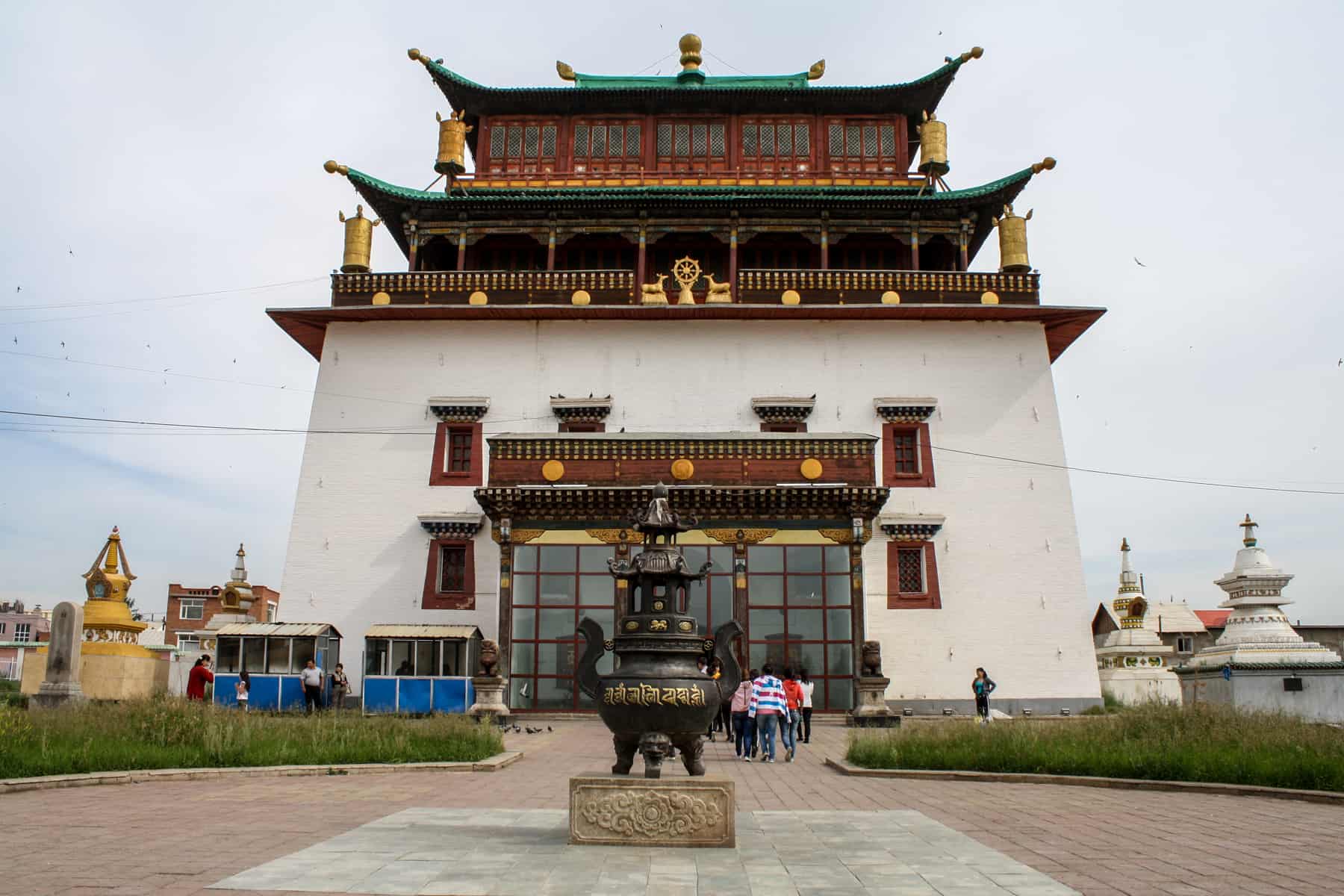
Gandan Monastery in Ulaanbaatar, Mongolia
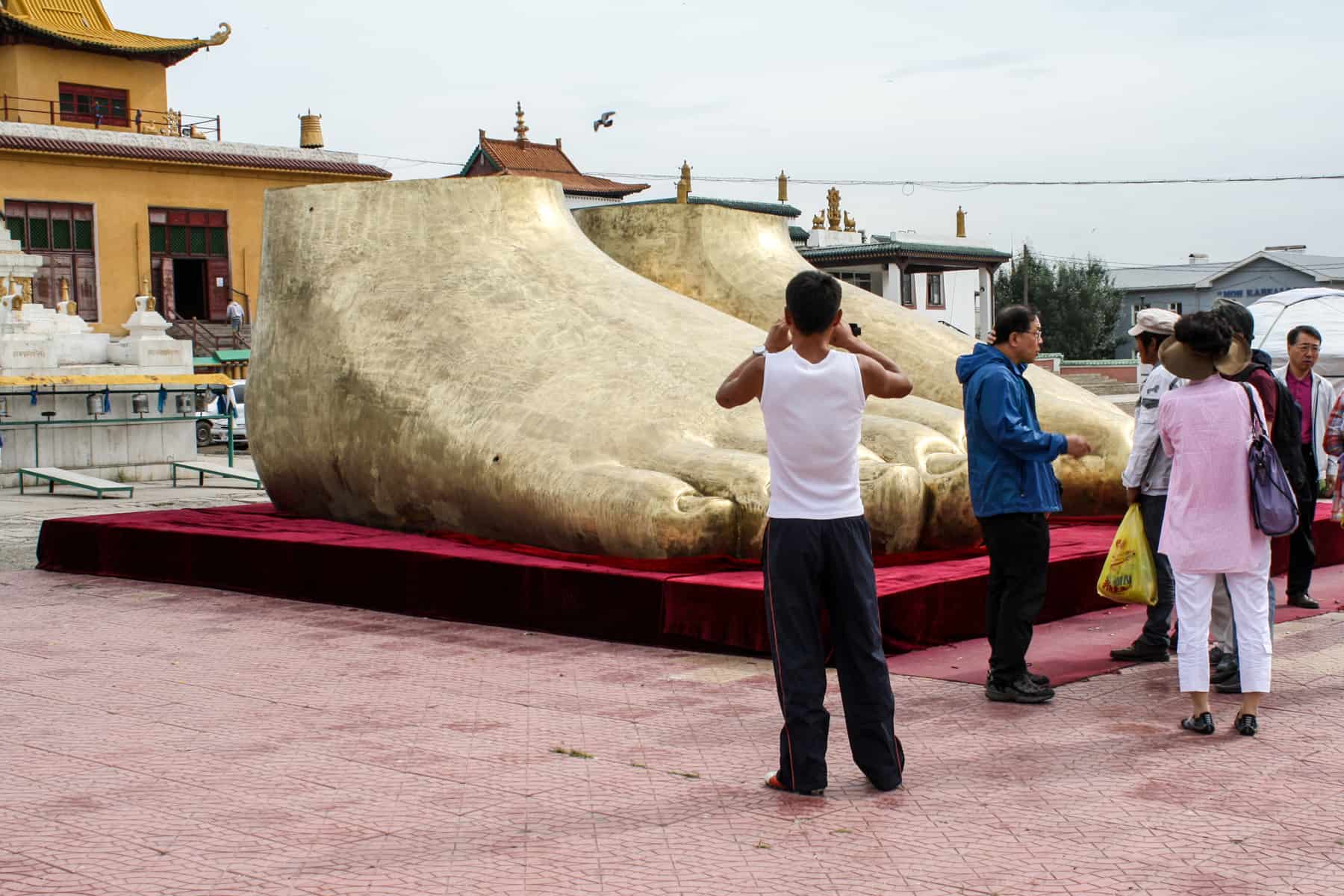
The golden feet outside the Gandan Monastery Ulaanbaatar
We set off in the truck from Ulaanbaatar to drive to the Baga Gazryn Chuluu rock formations in the Gobi desert. Due to heavy traffic when getting out of the city and general road conditions we got delayed and so decided to set up bush camp for the evening. Be prepared for delays in Mongolia but delight in being the only people in the area. All the space is yours.
We got to Baga Gazryn Chuluu – rock formations worshipped by locals who make pilgrimages here partly because legend states that Ghengis Khan camped here – before journeying to the Gobi Desert.
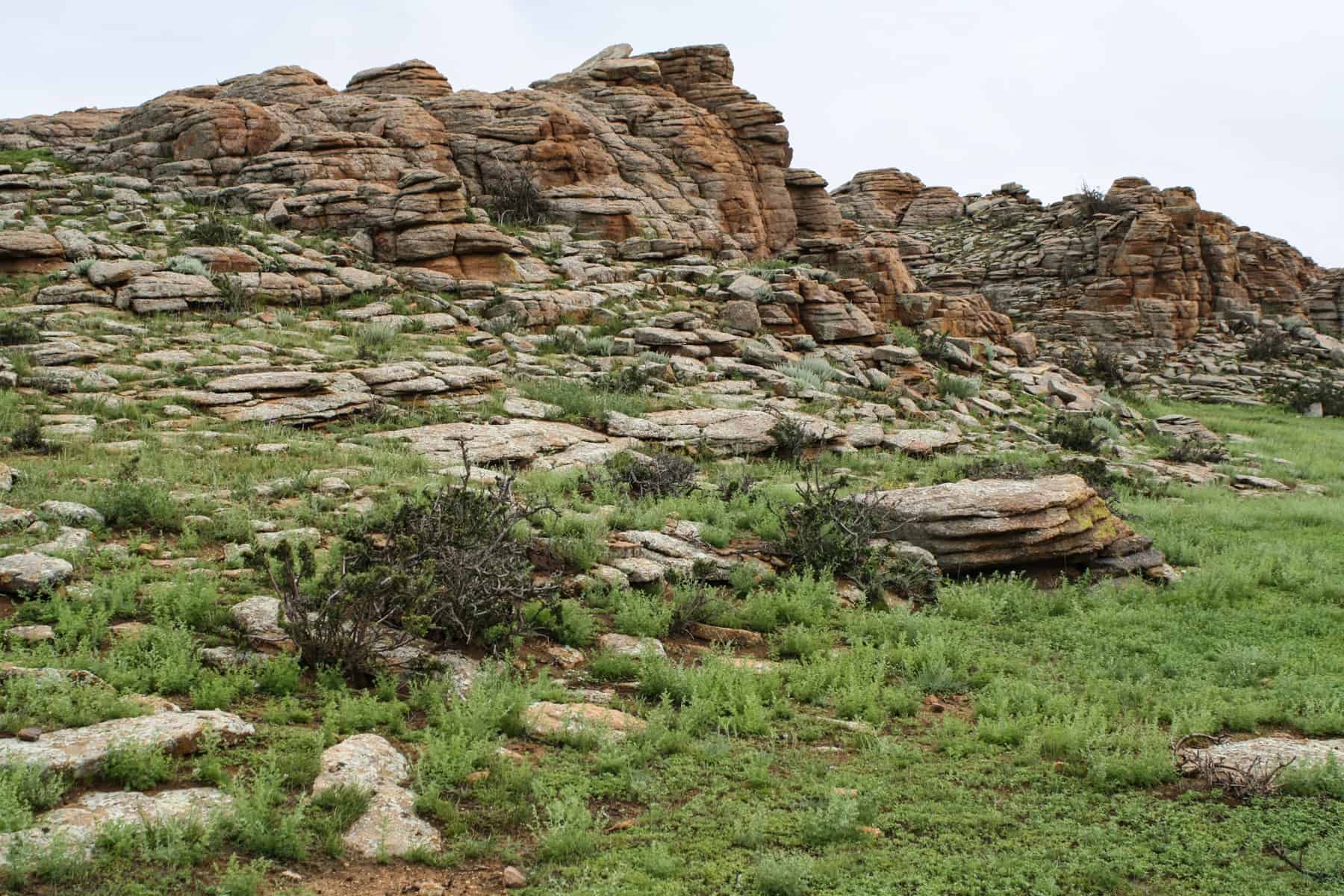
Layers of Baga Gazryn Chuluu rock formations in Mongolia
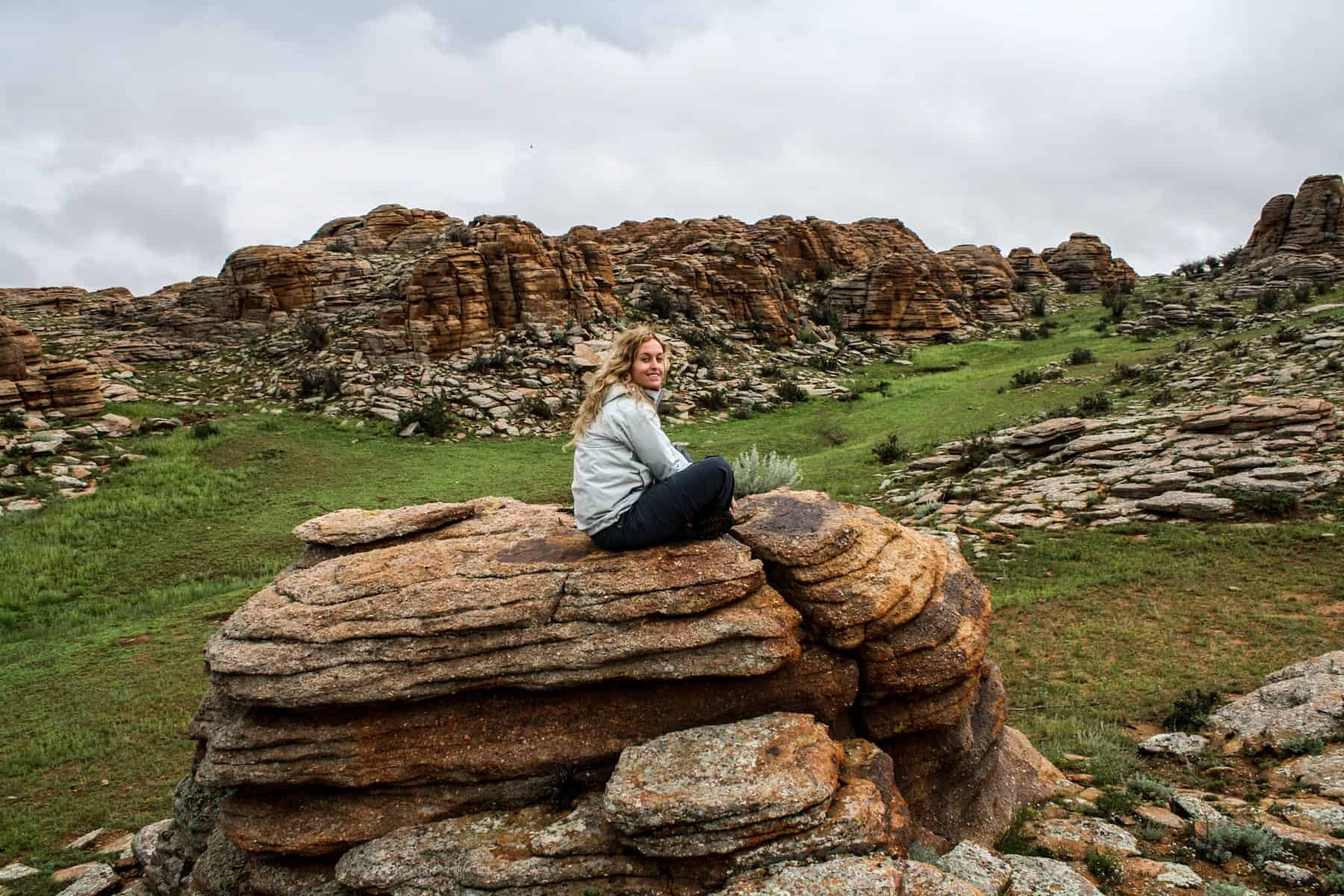
A hike to Baga Gazryn Chuluu as part of a Mongolia travel itinerary
On the way, we got to experience the famous Nadaam Festival when we passed through the local town of Mandal Govi . It was full of wrestling, horse racing, archery and fairground style fun. Nadaam means ‘games’, and the buzz was all around us as the only Westerners there. It was great to be a part of a traditional Mongolian community celebration, even if the afternoon was marred by a bogging, which resulted in the truck not being released from the soft mud until midnight.
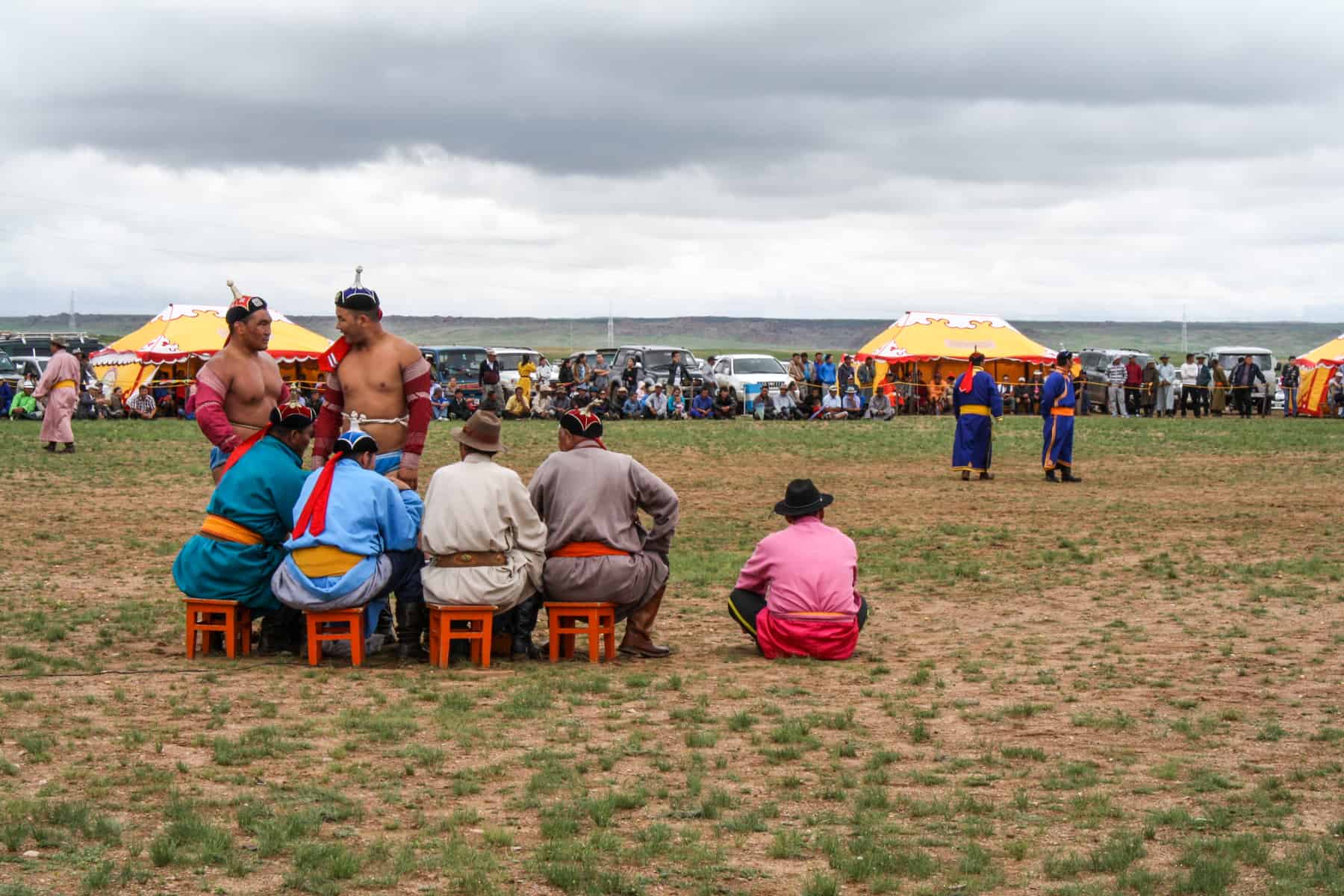
Watching the wrestling at the Nadaam Festival in Mongolia
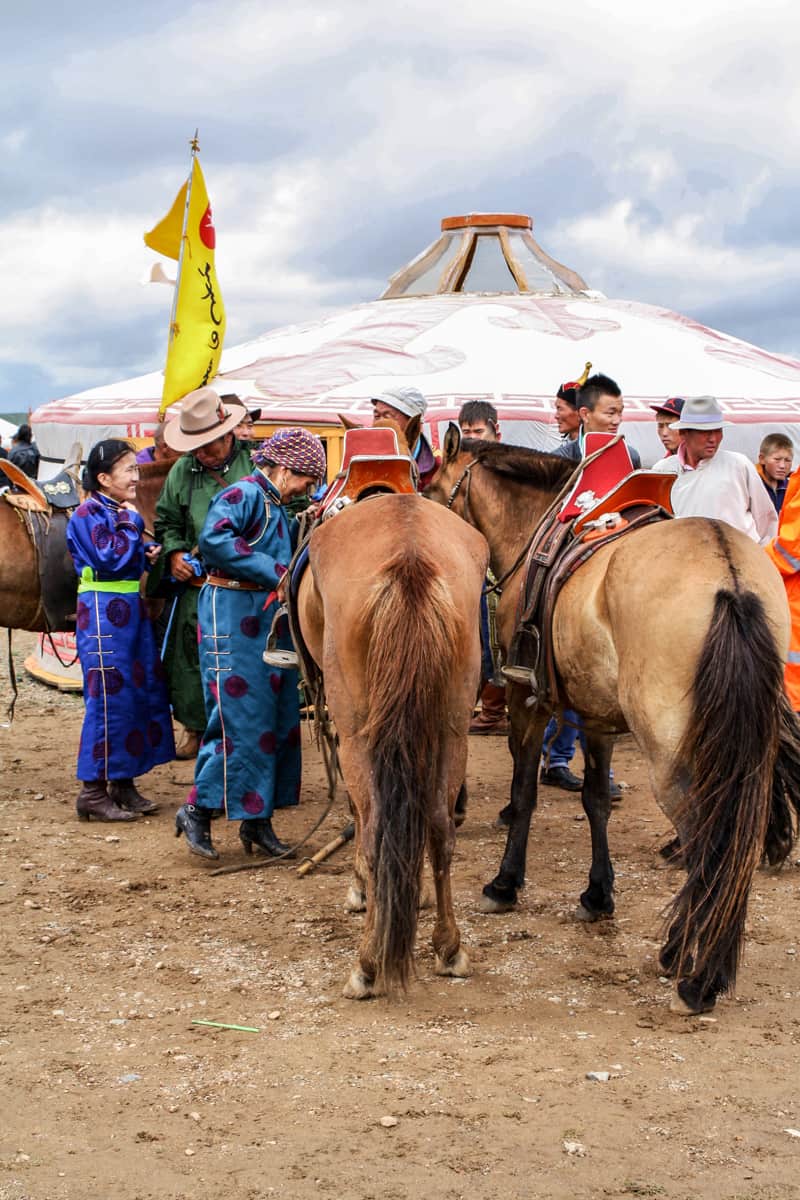
Mongolian locals enjoy the Nadaam Festival.
The plan was to get to our first ger camp, but after approximately 30 kilometres, we encountered a large ditch of water on the road. It resulted in us having to drain the water by hand and build a road and a dam for most of the afternoon to help us get across. Although this sounds horrendous, it created a great sense of camaraderie and, ultimately, an immense sense of achievement. We got to camp on a high point of the Gobi Desert instead near the town of Tsogoovi .
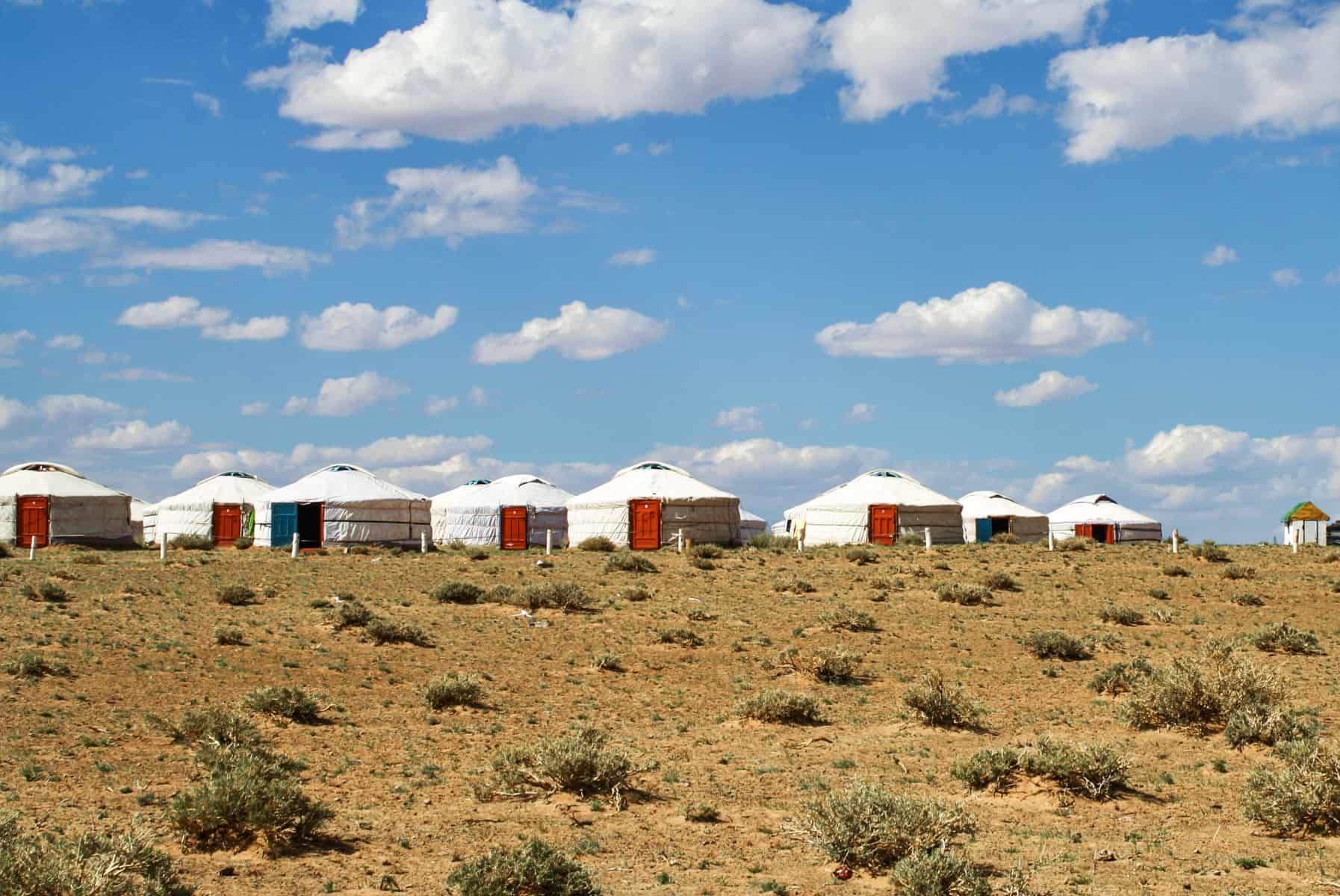
A Ger Camp on a hilltop in the Gobi Desert, Mongolia
We began our journey without a hitch to the ger Camp called Gobi Discovery, stopping at the town of Dalanzagad on the way. Mongolian towns are typically tiny and compact settlements that are reasonably large but without the ruin of a city like Ulaanbaatar.
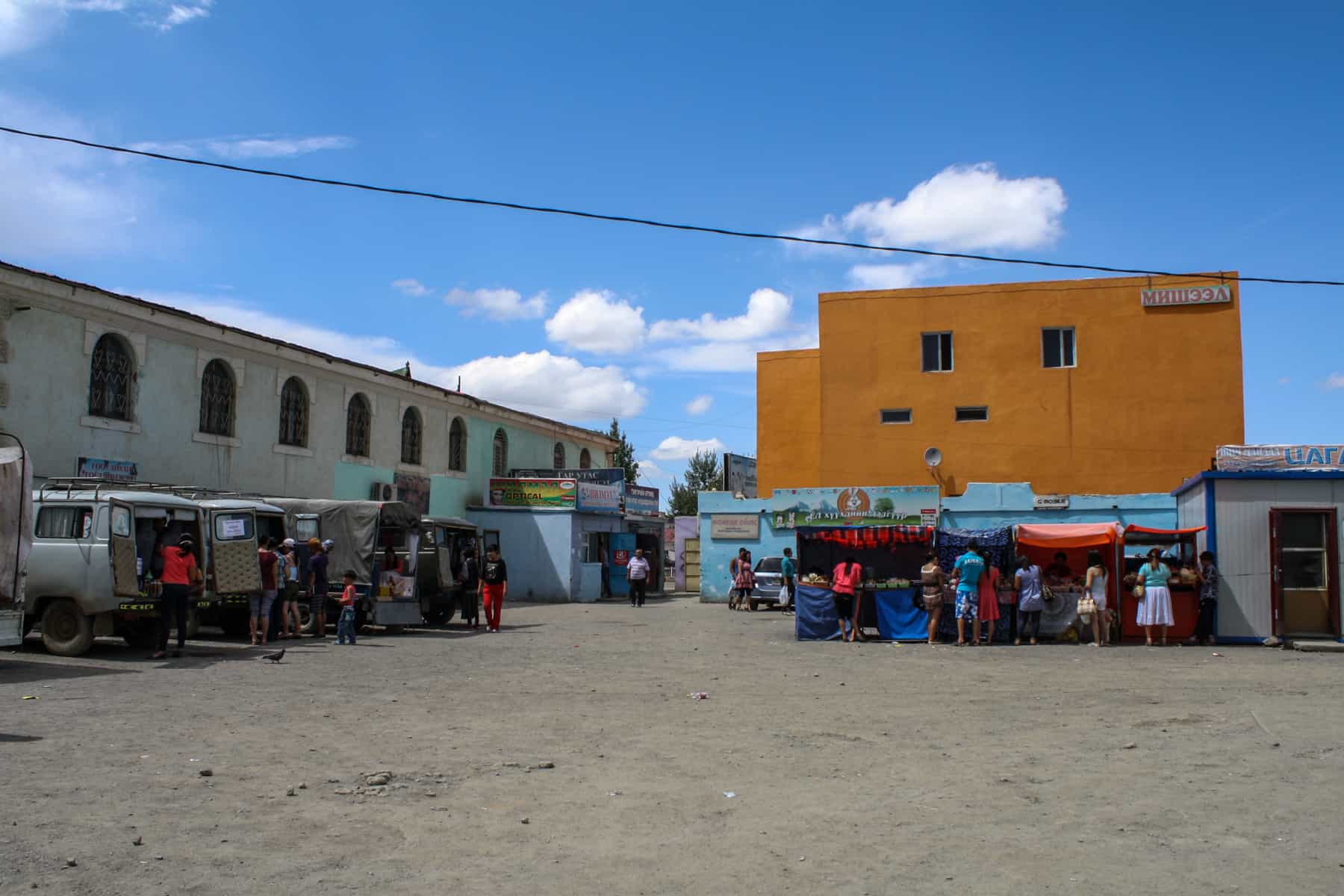
Market time in the town of Dalanzagad, Mongolia
We hiked in Yolin Am , a beautiful canyon in the Gobi, an ice valley, which hosts a colossal glacier all year round. The hike was spectacular, but, unfortunately for us, little of the iceberg remained, although we had lots of fun playing with what little ice there was regardless.
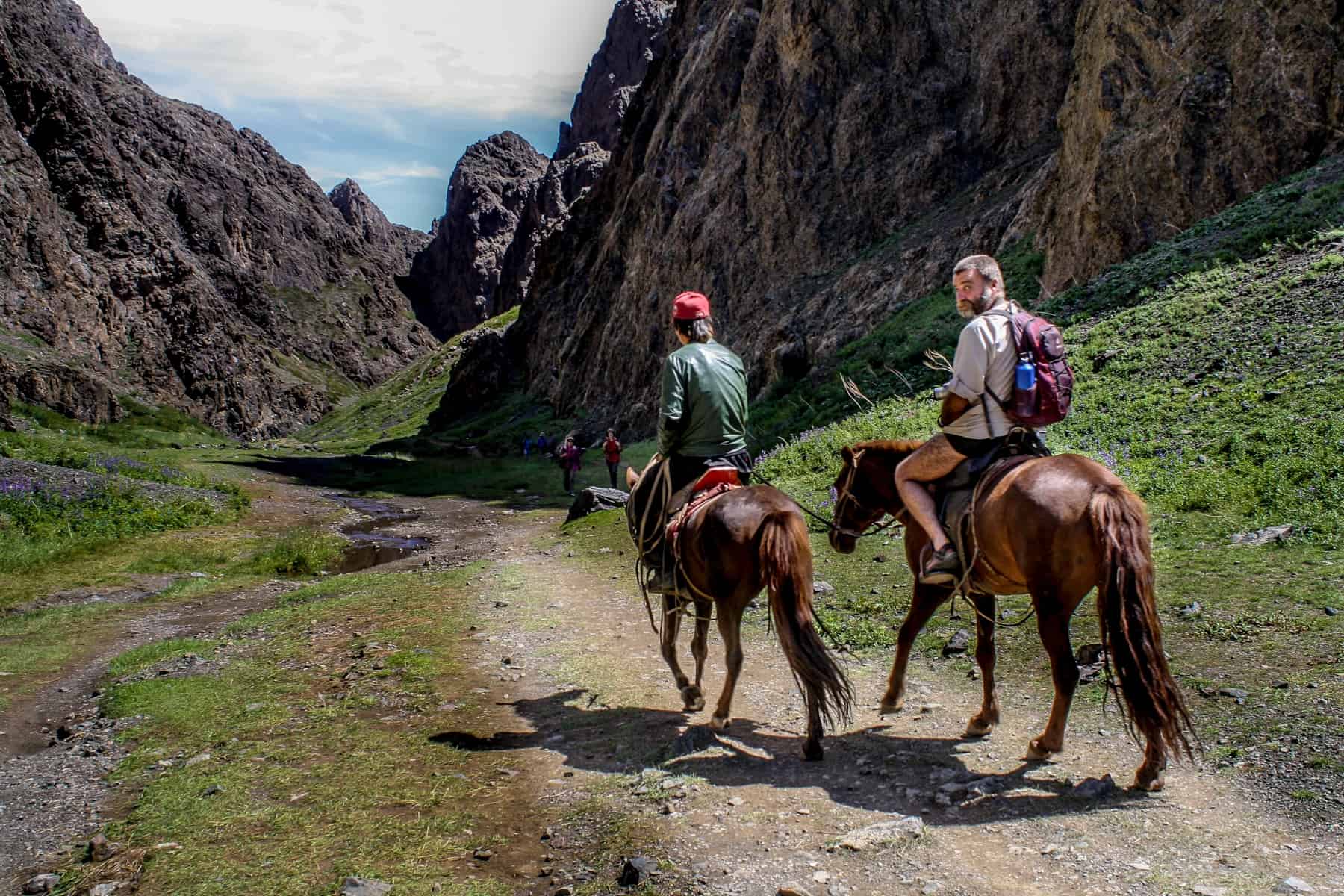
Hike or horseback in the Yolin Am Valley in Mongolia
Many sandy riverbed crossings eventually led us to our second Ger camp, Khongoryn Els Ger Camp. Here, you only have to open your ger door to be greeted with a breathtaking view of the Gobi and the Khongoryn Els Sand Dunes , which I later climbed, drank beer on and ran down. That was after a camel ride, of course.
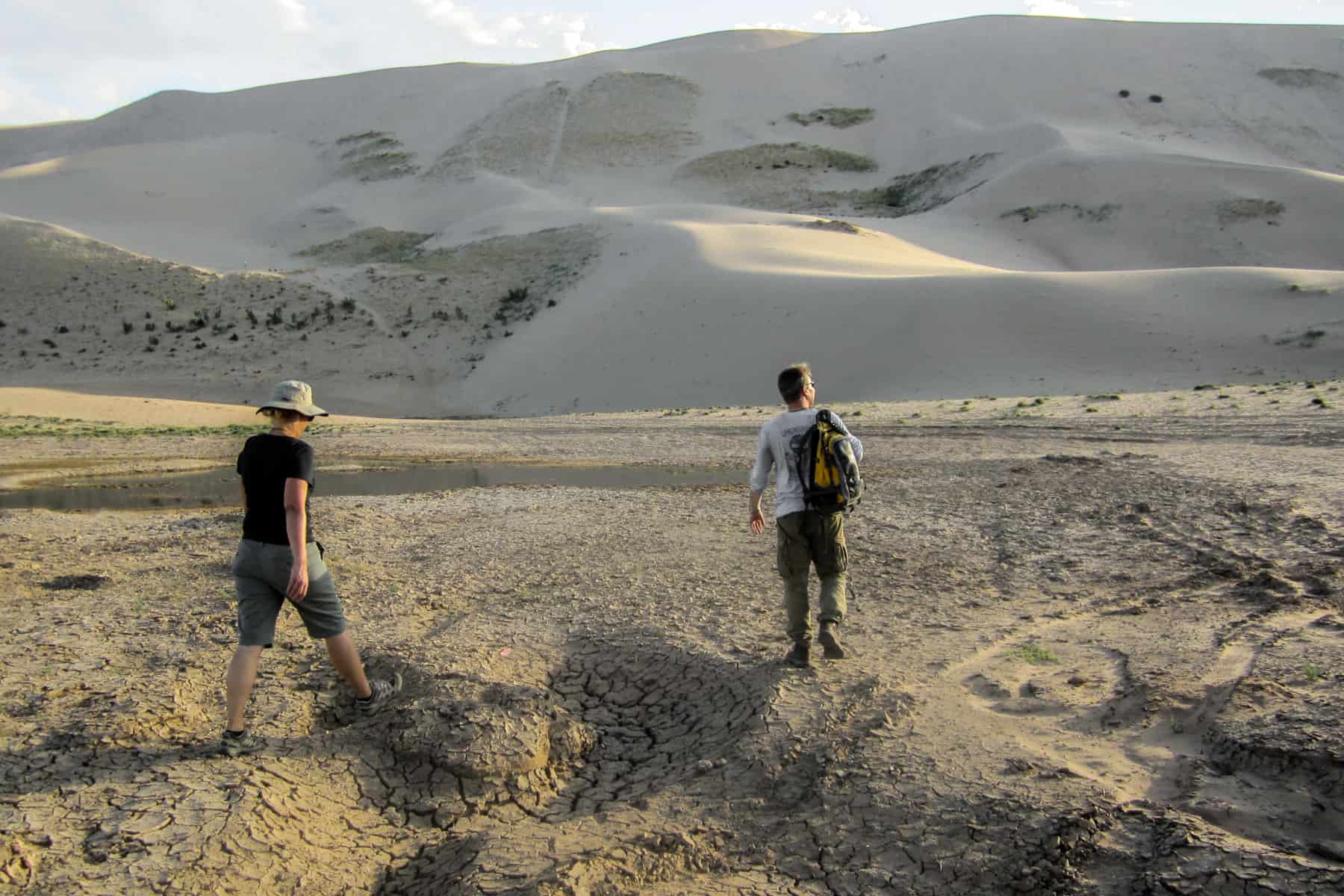
The glorious Gobi Desert Khongoryn Els Sand Dunes
Bumpy mountain roads took us to the spectacular Bayanzag Flaming Cliffs , which are a Mongolian version of the Grand Canyon, but smaller. It’s a significant site that unearthed many dinosaur fossils and eggs, and it is also a stunning backdrop for bush camping.
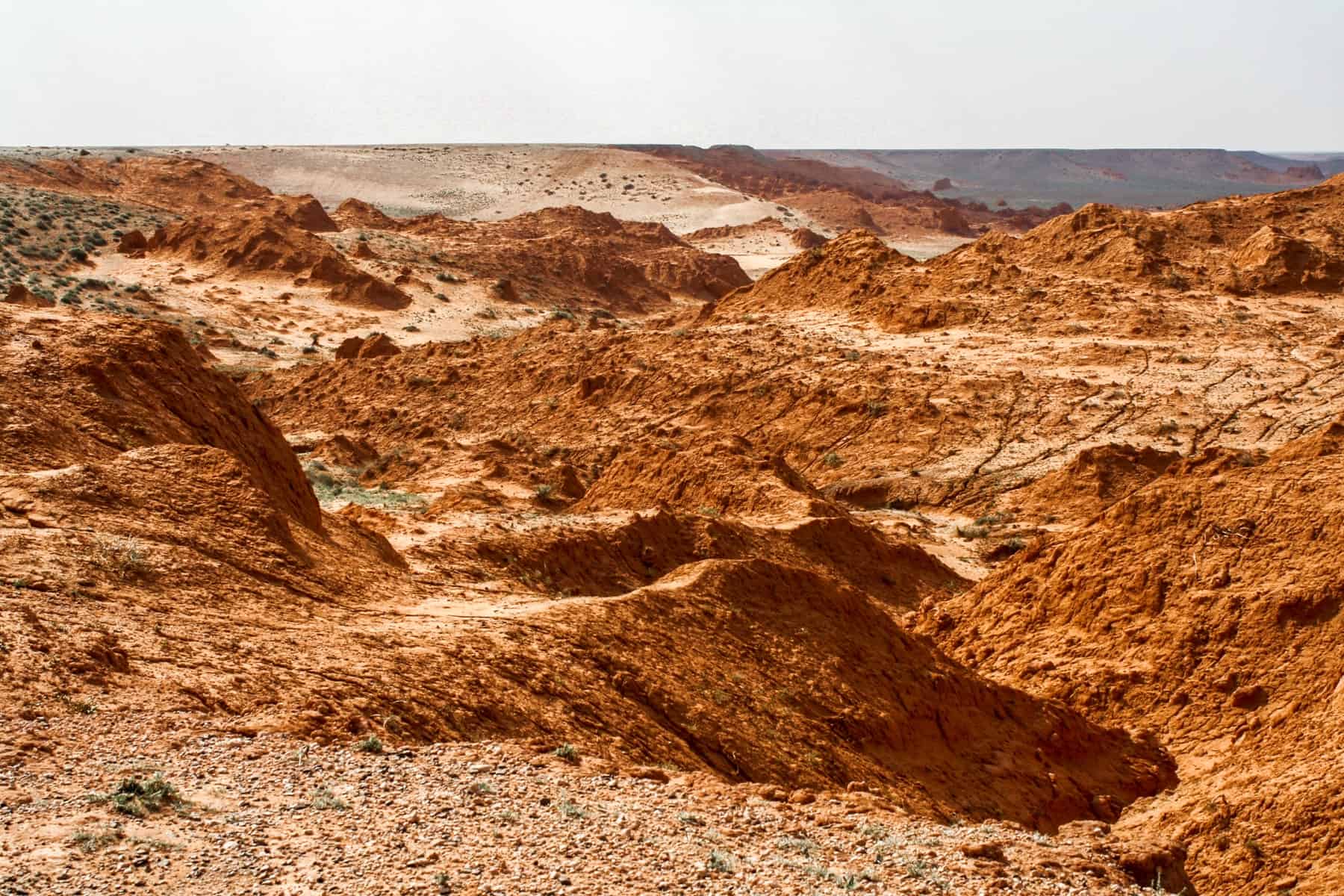
The blazing ochre colours of Mongolia’s Bayanzag Flaming Cliffs
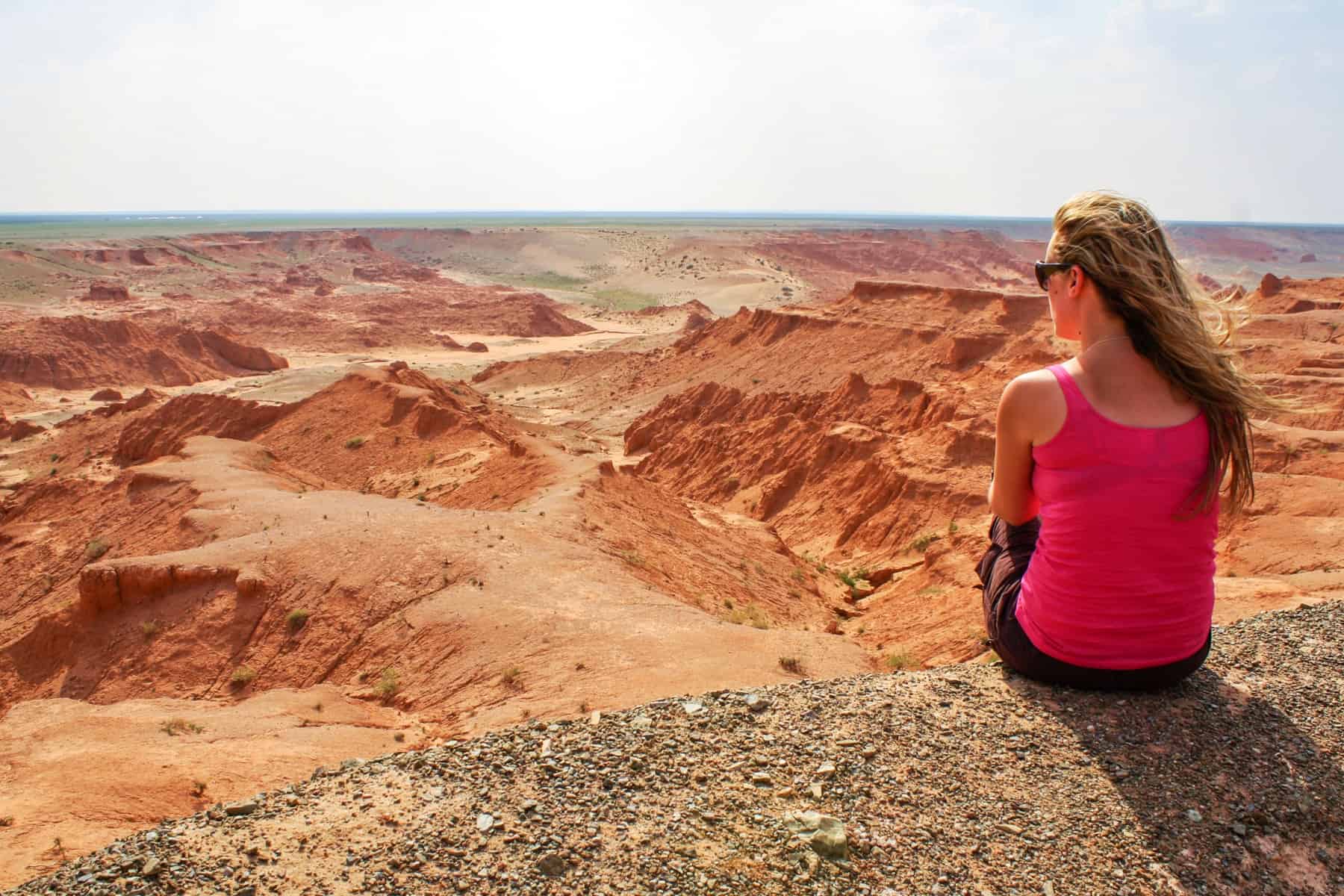
Marvel the mars-like landscape of Bayanzag Flaming Cliffs when you travel to Mongolia
When the communists invaded Mongolia in the 1930s (known as the Purges), nearly all Monasteries were destroyed. Ongii Monastery was one of them, and we visited the ruins here before driving to Arvaikheer, where heavy rain forced us into a hotel for the night. At times, random bad weather makes bush camping in Mongolia impossible, so it is essential to prepare for a budget recount at any given time.
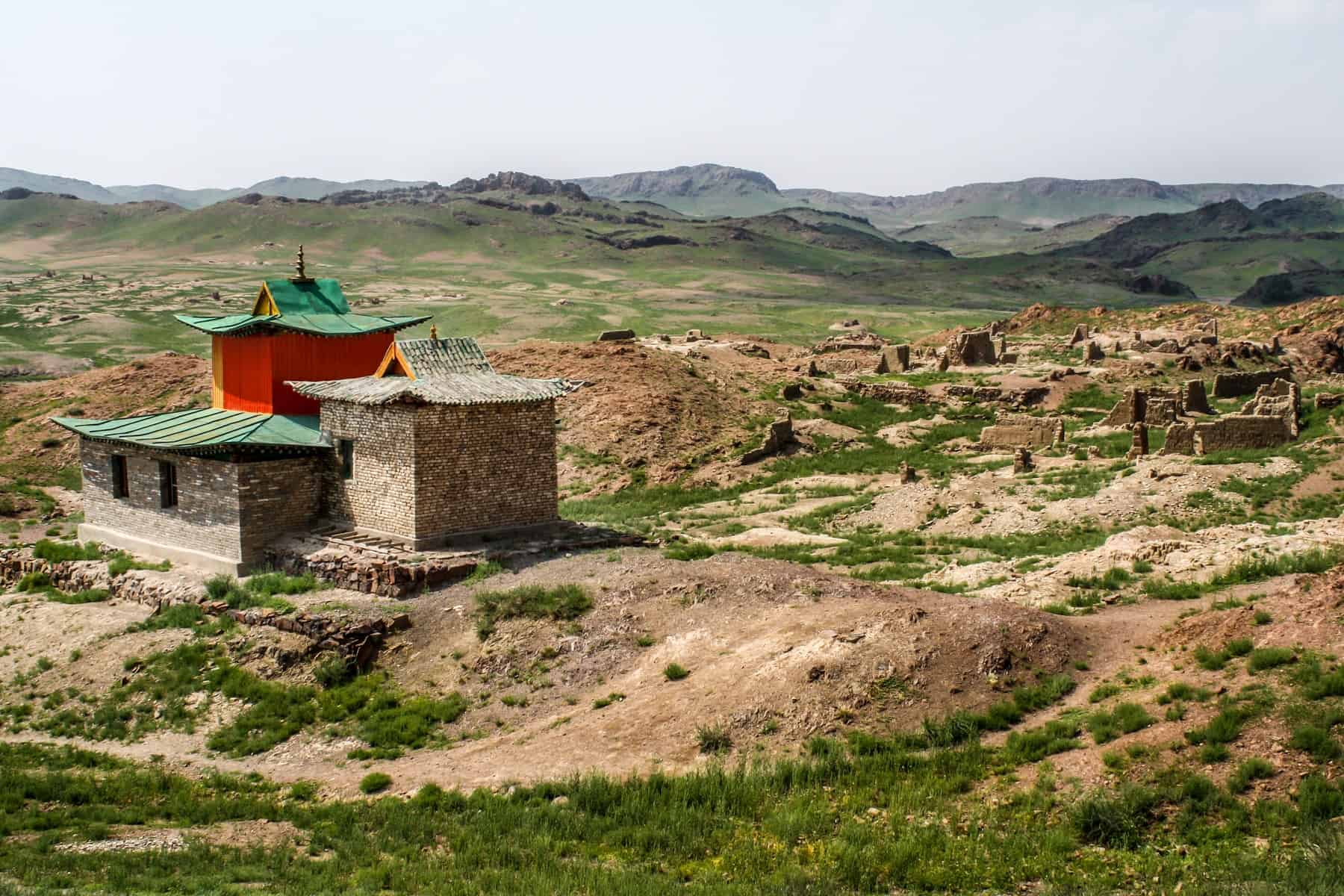
The site of the Ongii Monastery in Mongolia
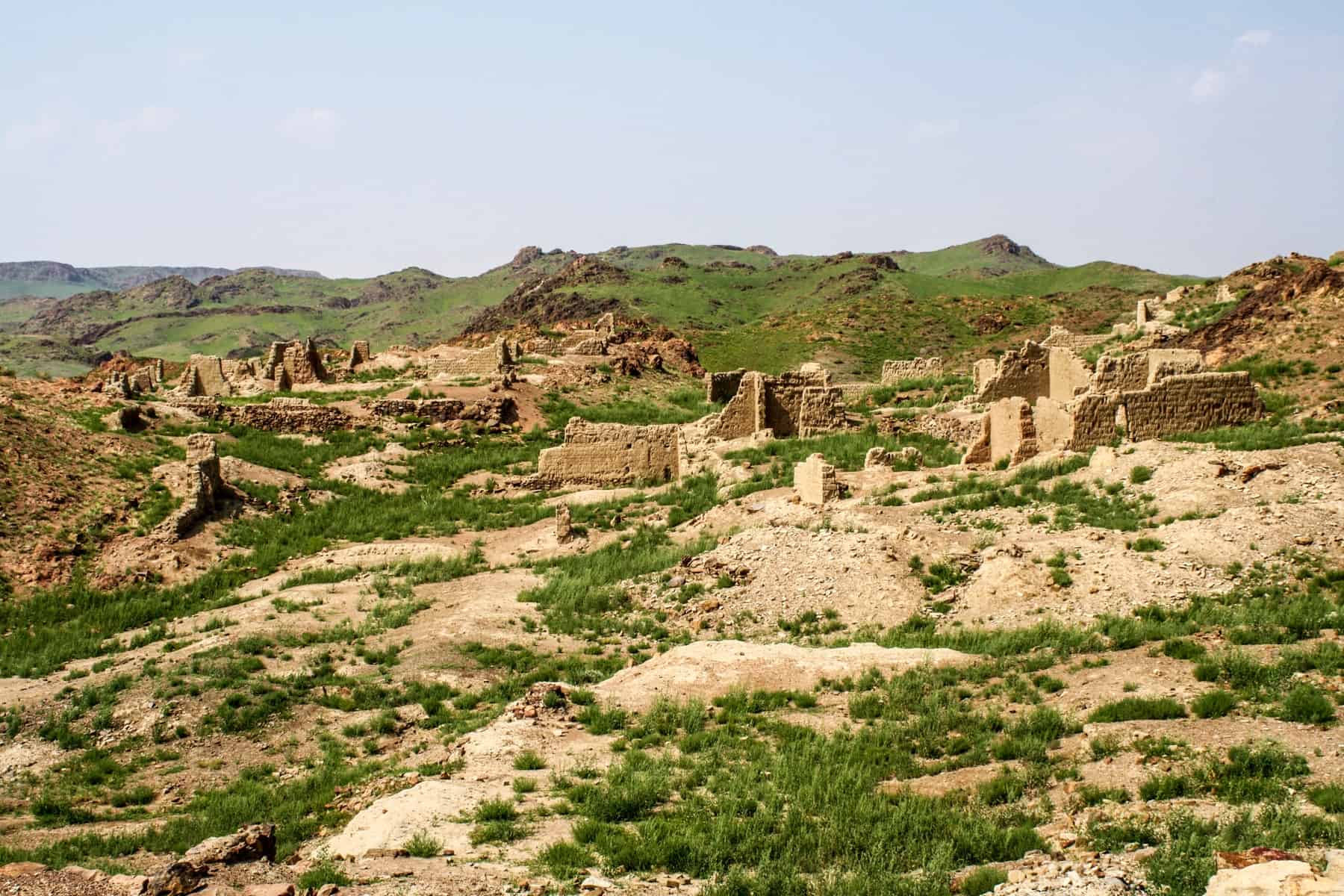
The scattered stone ruins of Ongii Monastery in Mongolia
We began our journey to the third ger camp but got badly bogged around midday after the truck had to swerve slightly, of course, to miss a drunk driver who came in our path (sadly, a lot of people drink and drive here). It took over five hours to get out, with the help of a small local tractor, and during that time, a few of us who remained to help with the truck (local jeeps rescued a few) lost our minds. It was a hilarious few hours that would have made an excellent documentary, probably how a Lord of the Flies scenario starts.
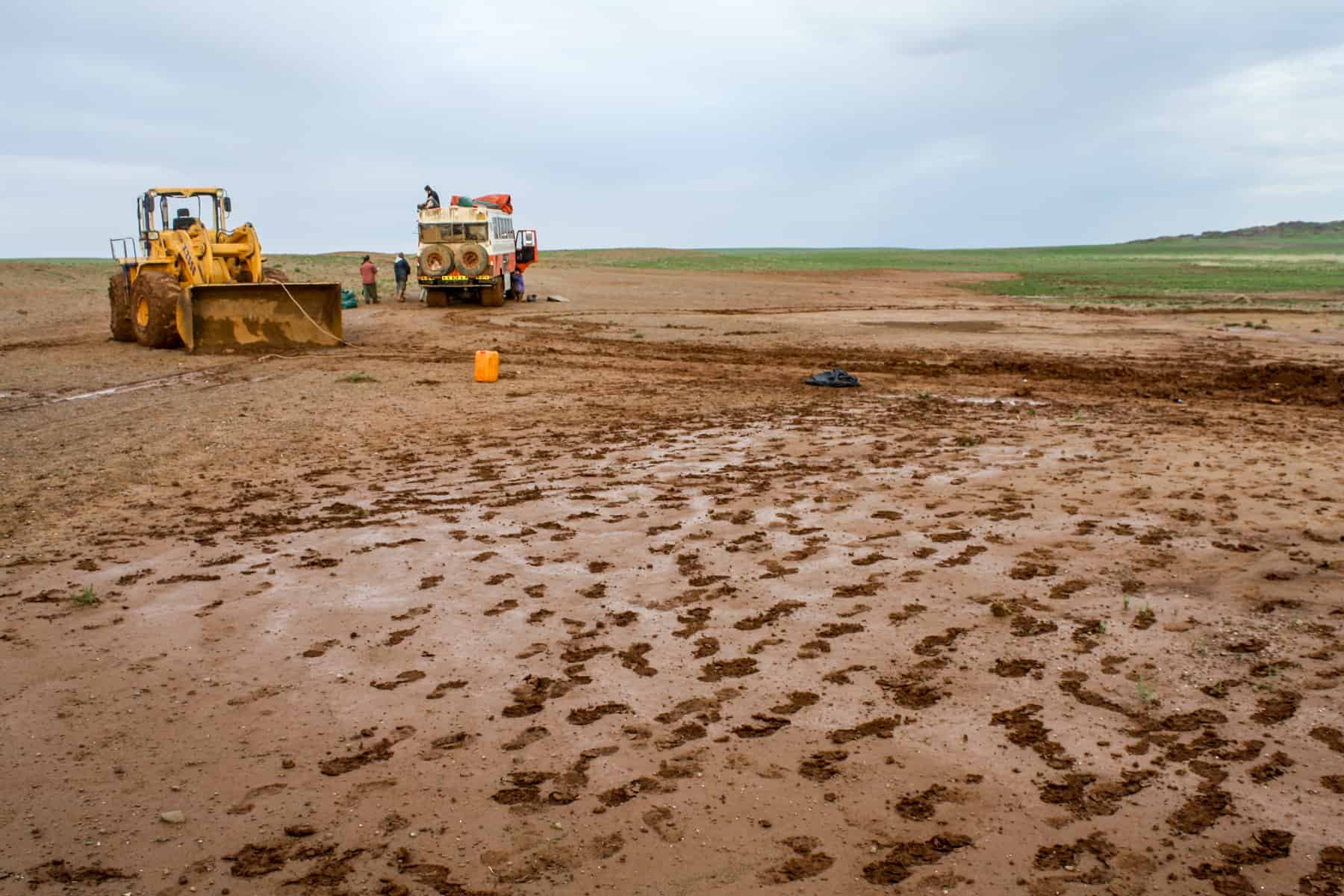
Tractors help pull the Overlanding truck out of the sticky mud in Mongolia’s rural landscape.
The roads were not rigid and stable enough for the truck to continue, especially with all the hills. After setting up tents and cooking dinner, two small vans came to the rescue to take us on our two-hour journey to the Ger Camp. It was a scary ride in the dark, where we stopped at the driver’s backyard and where a small boy jumped into the hold of the van for the rest of the journey.
I highly recommend staying in a ger camp in the beautiful Orkhon Valley . There’s nothing like a pleasant hike through the beautiful forest to reach the Tuvkhon Monastery and see the surrounding area. Pure bliss.
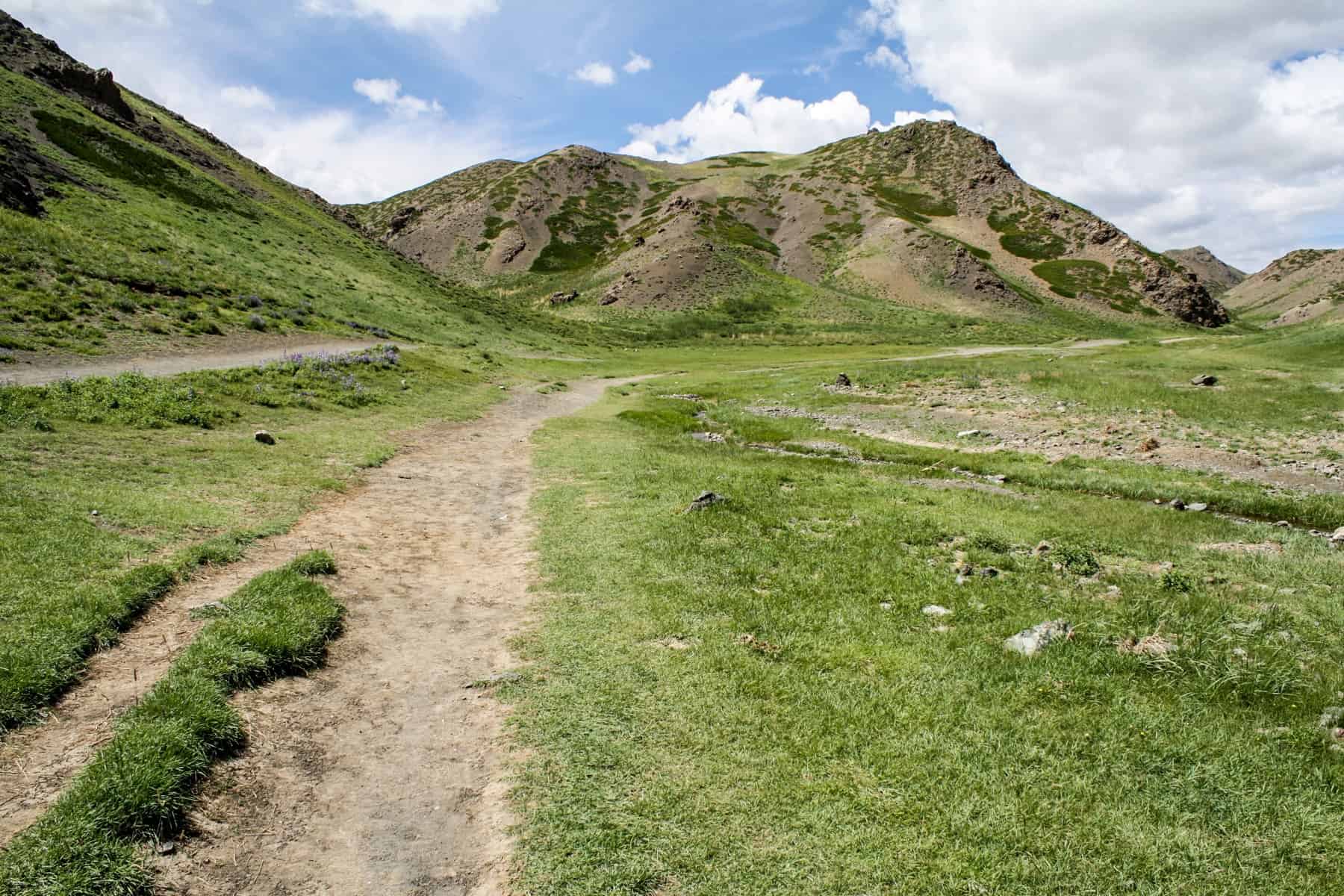
The lush green leading to the soft peaks in the Orkhon Valley Mongolia
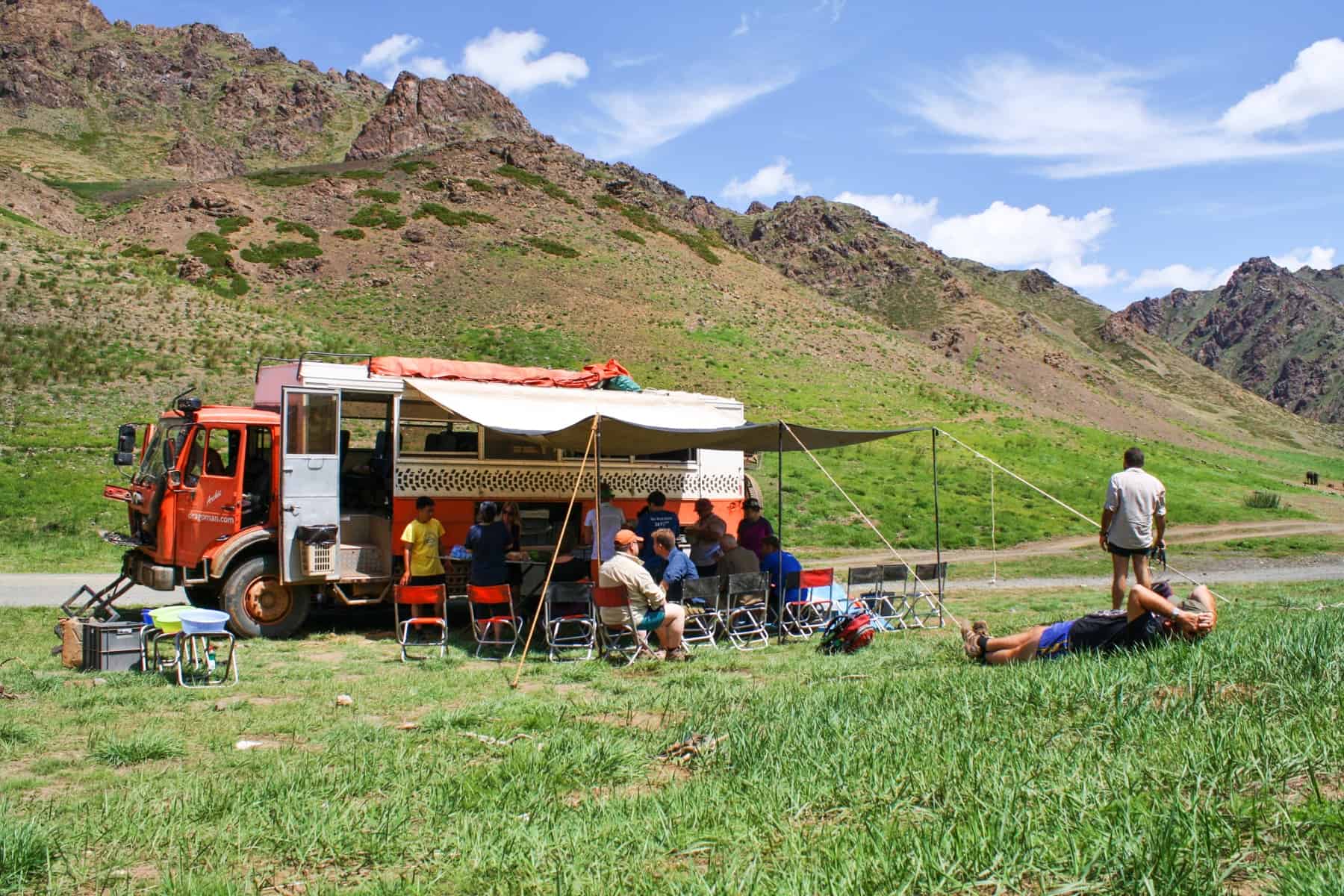
A rest stop in the scenic Orkhon Valley landscape
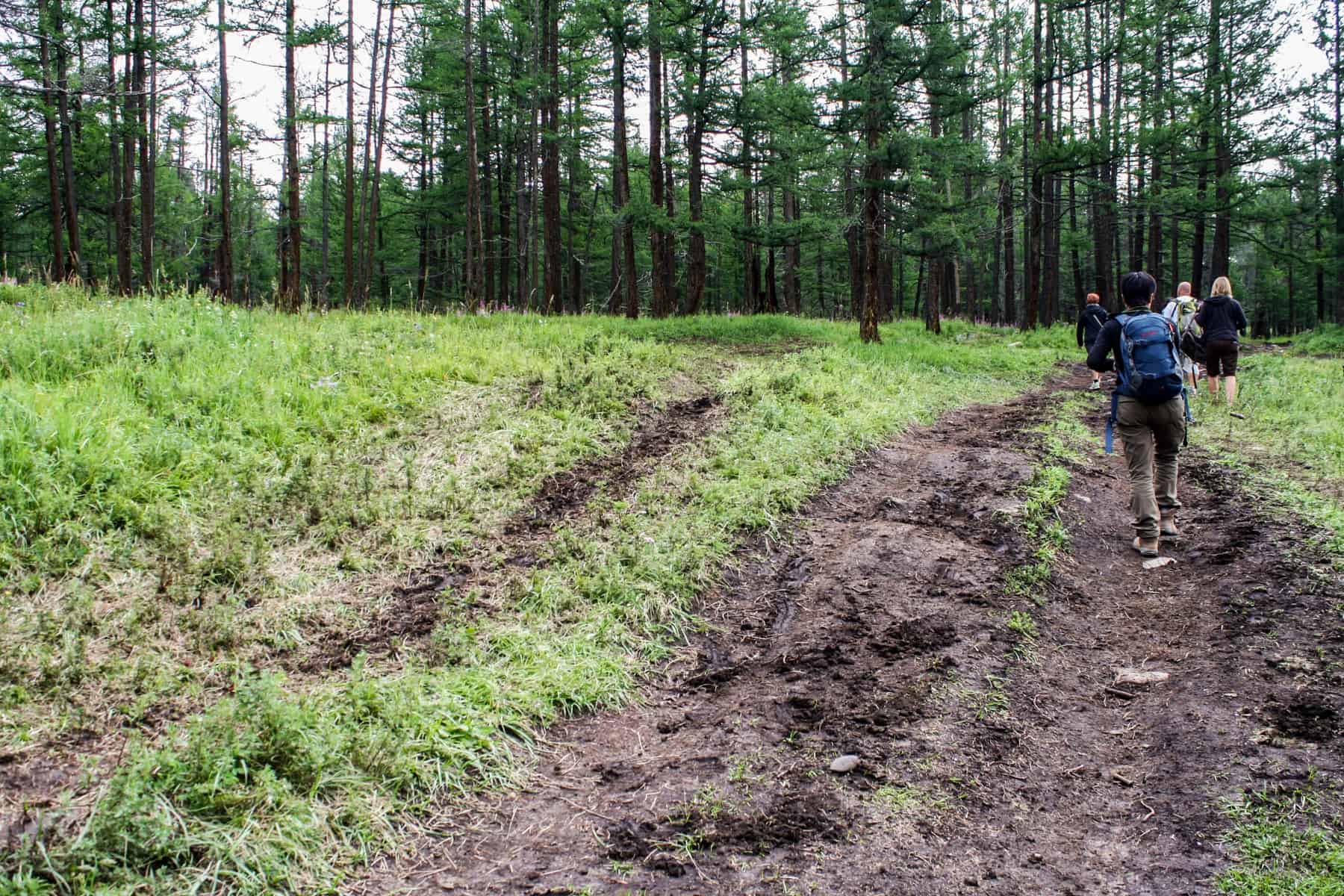
Hiking the forest trails of Mongolia’s Orkhon Valley

The rocky plateau that surrounds the Tövkhön Monastery in Mongolia

The colourful entrance to the Tövkhön Monastery
The Orkhon Valley waterfall was the next stop on our five-hour drive to the next ger camp. This camp plays host to the famous hot springs in the region, where we went skinny dipping and enjoyed a few refreshing beers.
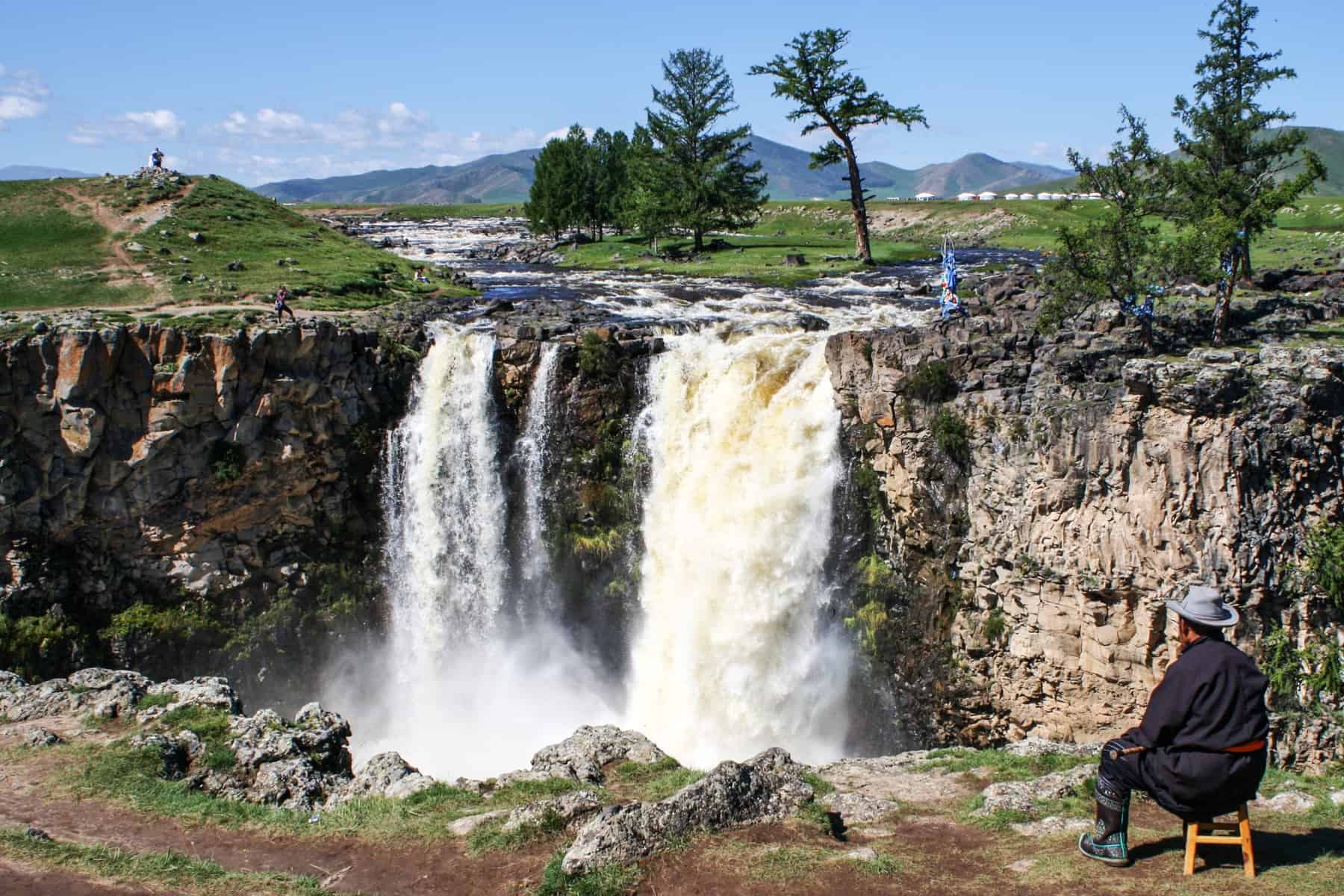
A Mongolian man sits in a chair peacefully enjoying the backdrop of the Orkhon Valley Waterfalls in Mongolia.
Fully clothed, of course, we took a short hike through the lush green forest to visit the source of the hot springs. When you come across your first sighting of trees after two weeks of barren land, you begin to appreciate such incredible surroundings.
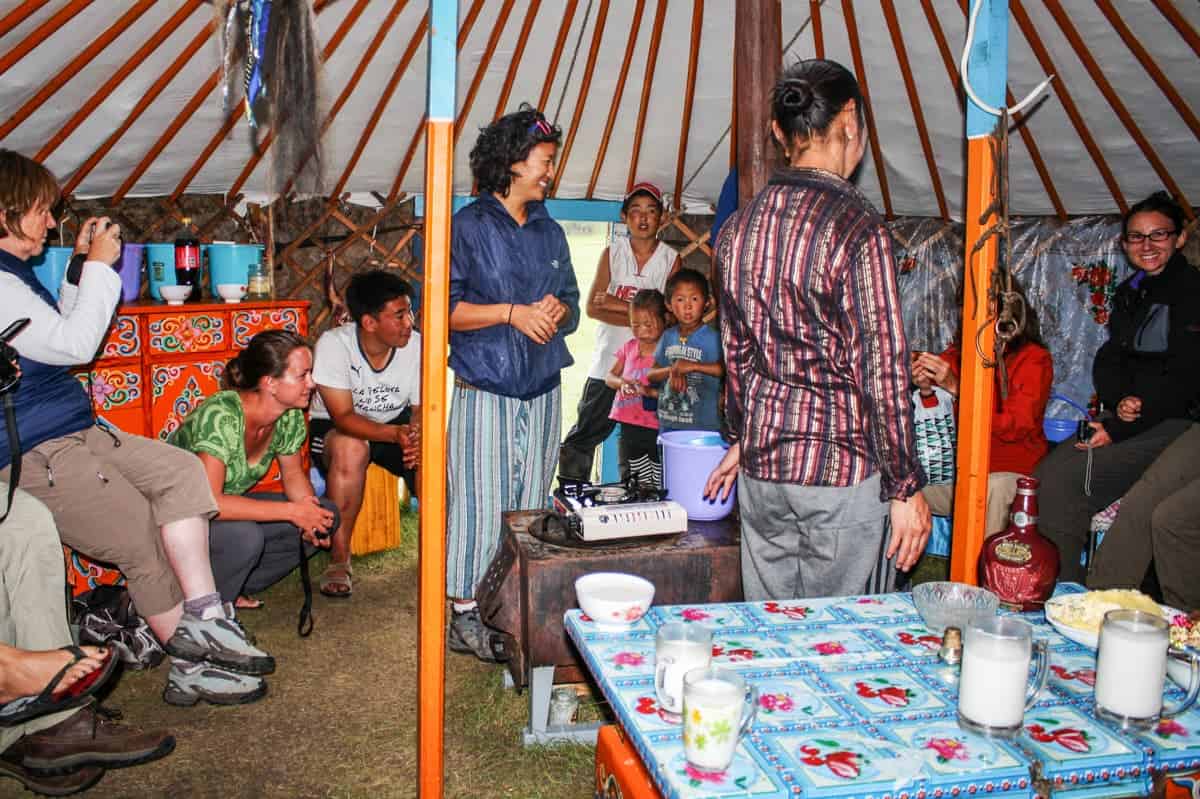
Visiting a local nomadic family in their ger in Mongolia
As we had two Mongolian guides with us (invaluable support in a country where very little or no English is spoken or understood), we could visit a Mongolian ger and a local family to learn about nomadic life.
It wasn’t a tourist set up, but a traditional, local family who lived on an isolated patch of land in the valley. We tried their dairy products (their source of income), including fermented mare’s milk, curd and butter, before learning about ger rules and traditions and asking each other many questions!
READ MORE: Visiting a Mongolian Ger – Understanding the Nomadic Culture of Mongolia
We needed a quick stop in the nearby town of Tsetserleg to stock up on food supplies. It was a market day with an electric atmosphere. I get a high from moments when you don’t know where you are and what to do, and where you have to work hard to communicate and negotiate.
We later visited the most important Monastery in the country, Erdene Zuu Monastery in Kharkhorin – the first Buddhist monastery in Mongolia that had up to 100 temples and 1,000 monks before the purges in 1937. Only three temples remained, alongside several statues and other items.
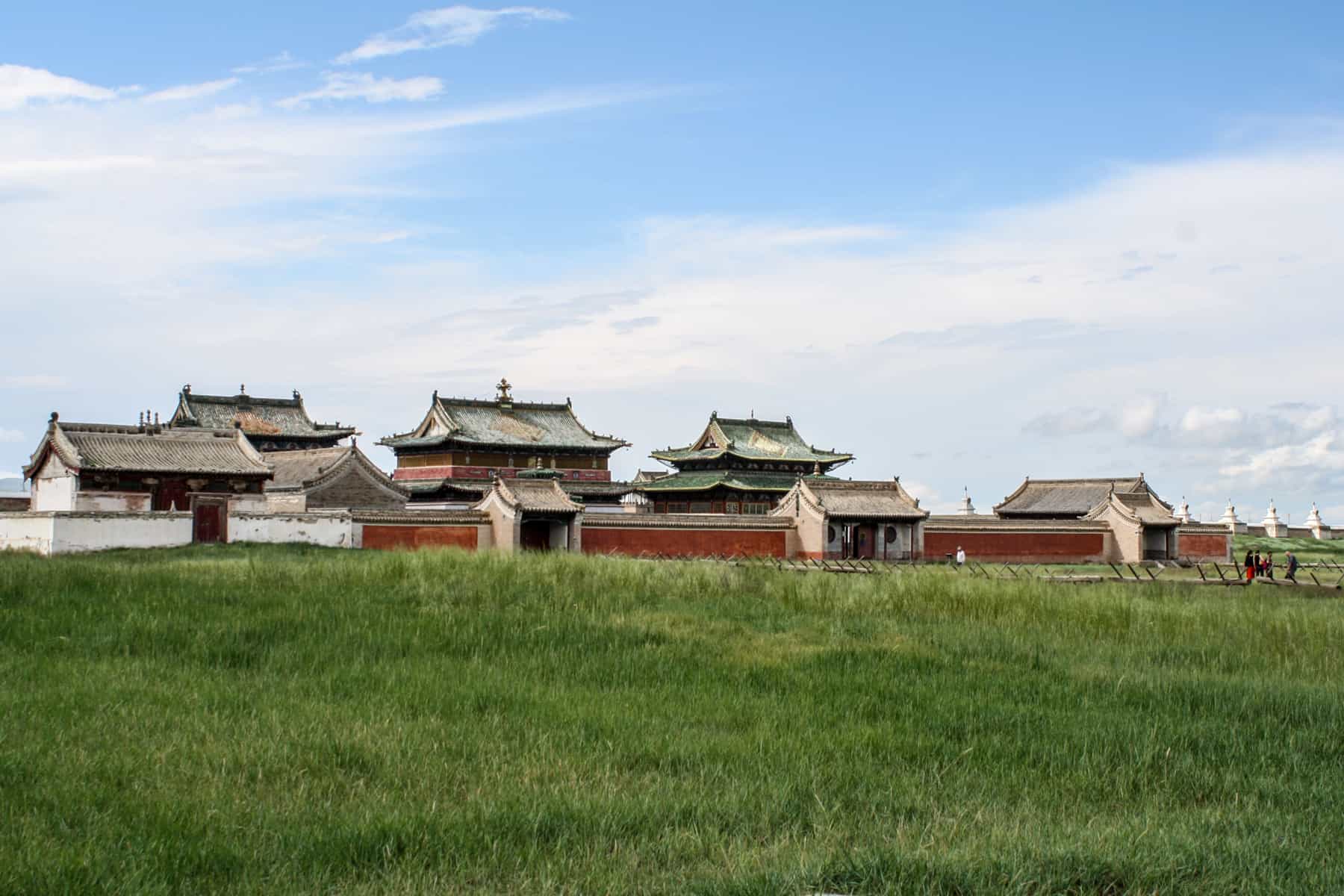
The exterior walls of the Erdene Zuu Monastery, Mongolia
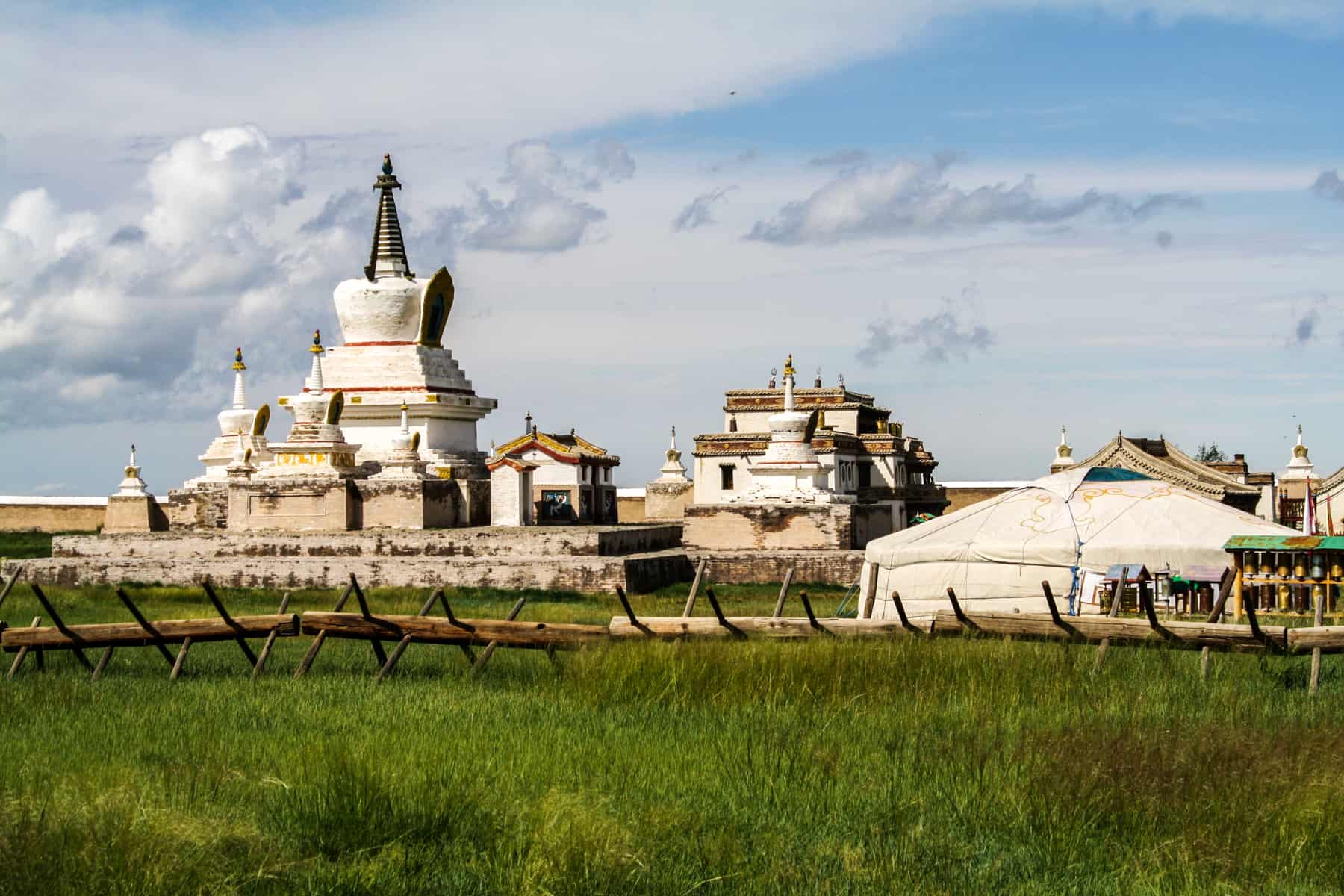
Part of the temple complex inside Mongolia’s Erdene Zuu Monastery
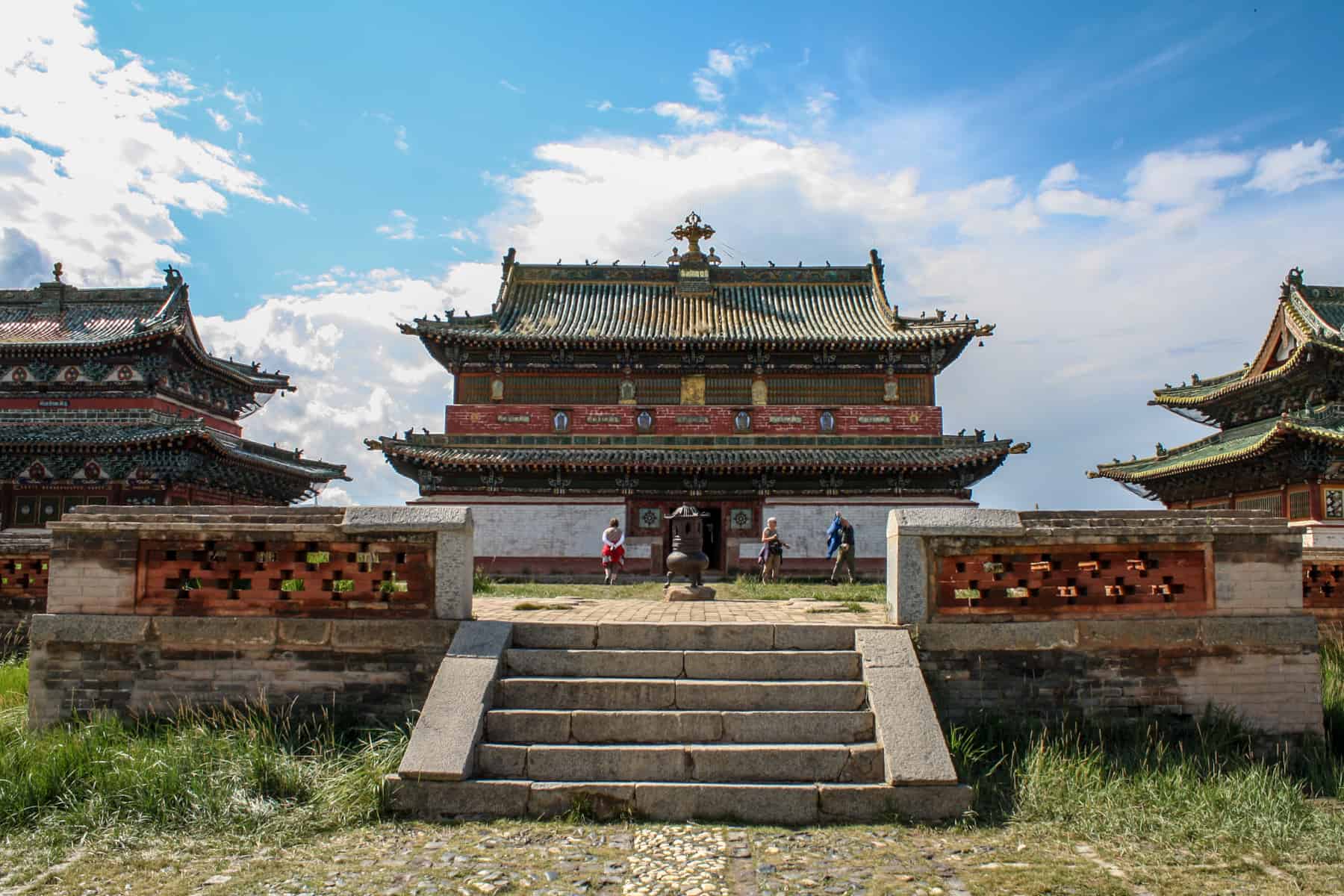
The red, gold and green temple structures at Erdene Zuu Monastery
A visit to the museum we camped next to – the Kultigen Monument, housing artefacts from the Turkish empire – set us on the way to the nearby Ugii Lake, where we would relax all day and camp for one night.
Ugii lake emits a calming atmosphere and invites you to traverse it slowly. While it would take almost a day to walk around, it’s a great place to unwind and reflect. I count this as one of my most favourite spots in all of Mongolia.
Our camping set-up beside Ugii Lake in Mongolia
We arrived at Hustain National Park in the afternoon to settle into a ger camp. This National Park is known for the rare Przewalski’s horse, unique to Mongolia. When you finally track down a small group, it’s still hard to see their beauty up close as you can’t get that close to them.
Still, we got to meet the ‘Best Mongolian Folk Band in Mongolia’ called Domog in the evening after a fantastic show where they performed rock-style tunes via the famed throat singing. I guess it is the equivalent of meeting Westlife in Ireland. Seriously.
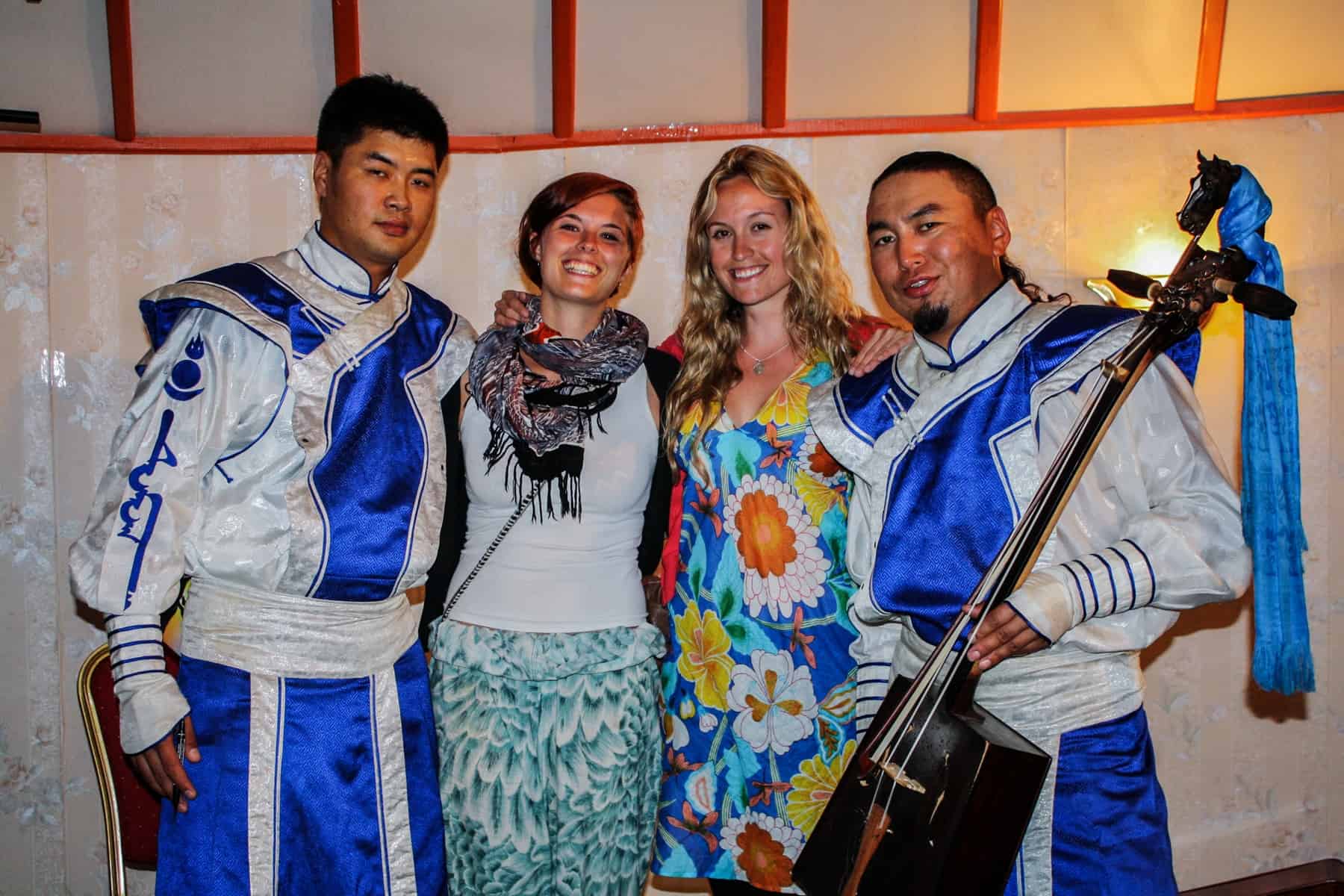
Meeting Damog, the Best Mongolian Folk Band in Mongolia
We had to journey back through the crazy, construction-overloaded, traffic-ridden Ulaanbaatar to get to Terelj National Park and the last ger camp of the trip (we were due to bush camp the weather put a stop to that).
It’s incredible how a few hours down the road from the capital brings you to some of the country’s most spectacular landscapes.
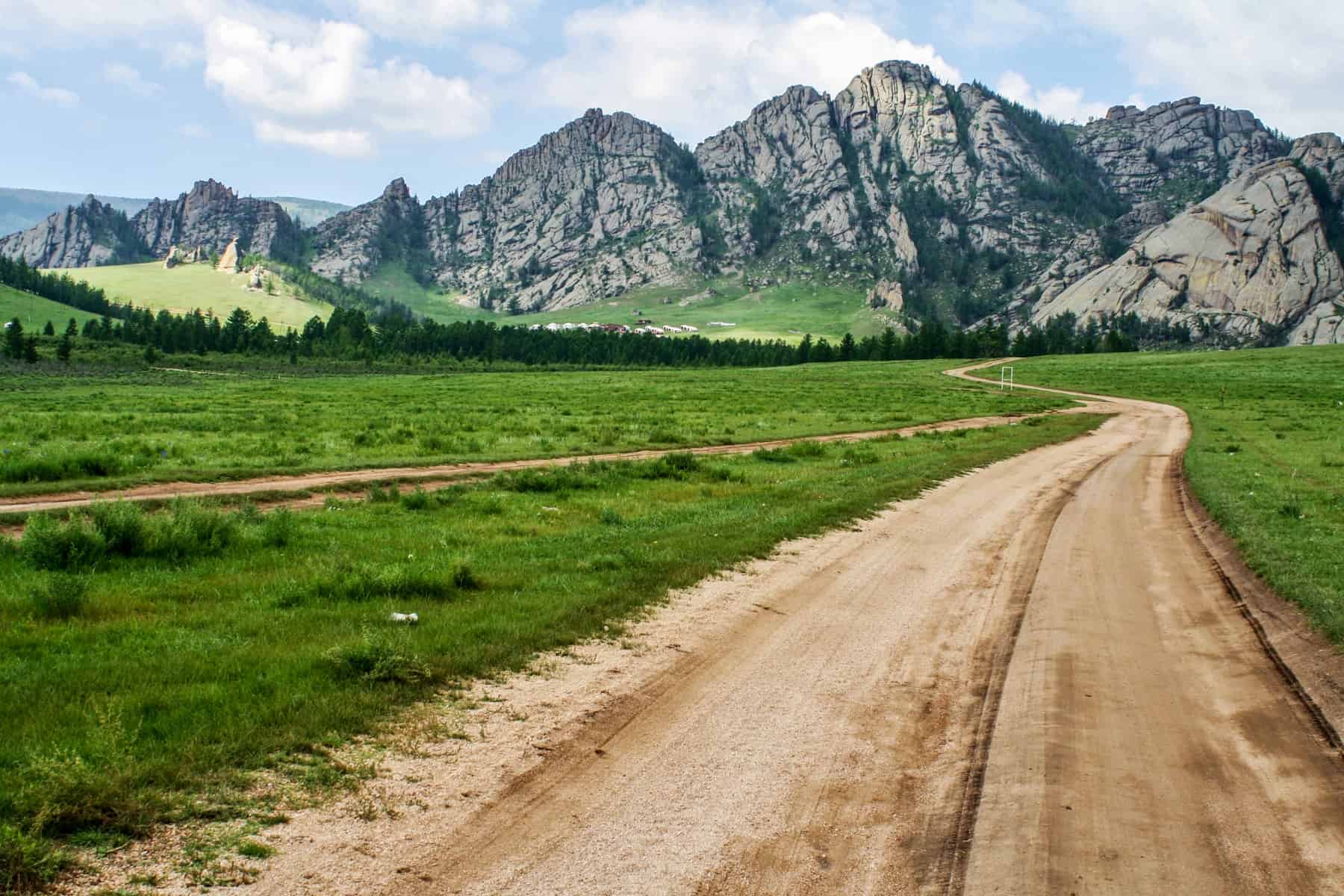
The road that leads to the heart of Terelj National Park, Mongolia
If you love walking and hiking, you will love Terelj National Park. Here you can wander for hours, hike to a Monastery and horse ride through the forests and rocky hilltops. Make sure you check out ‘Turtle Rock’ too. You may think it looks like something else from a certain angle!
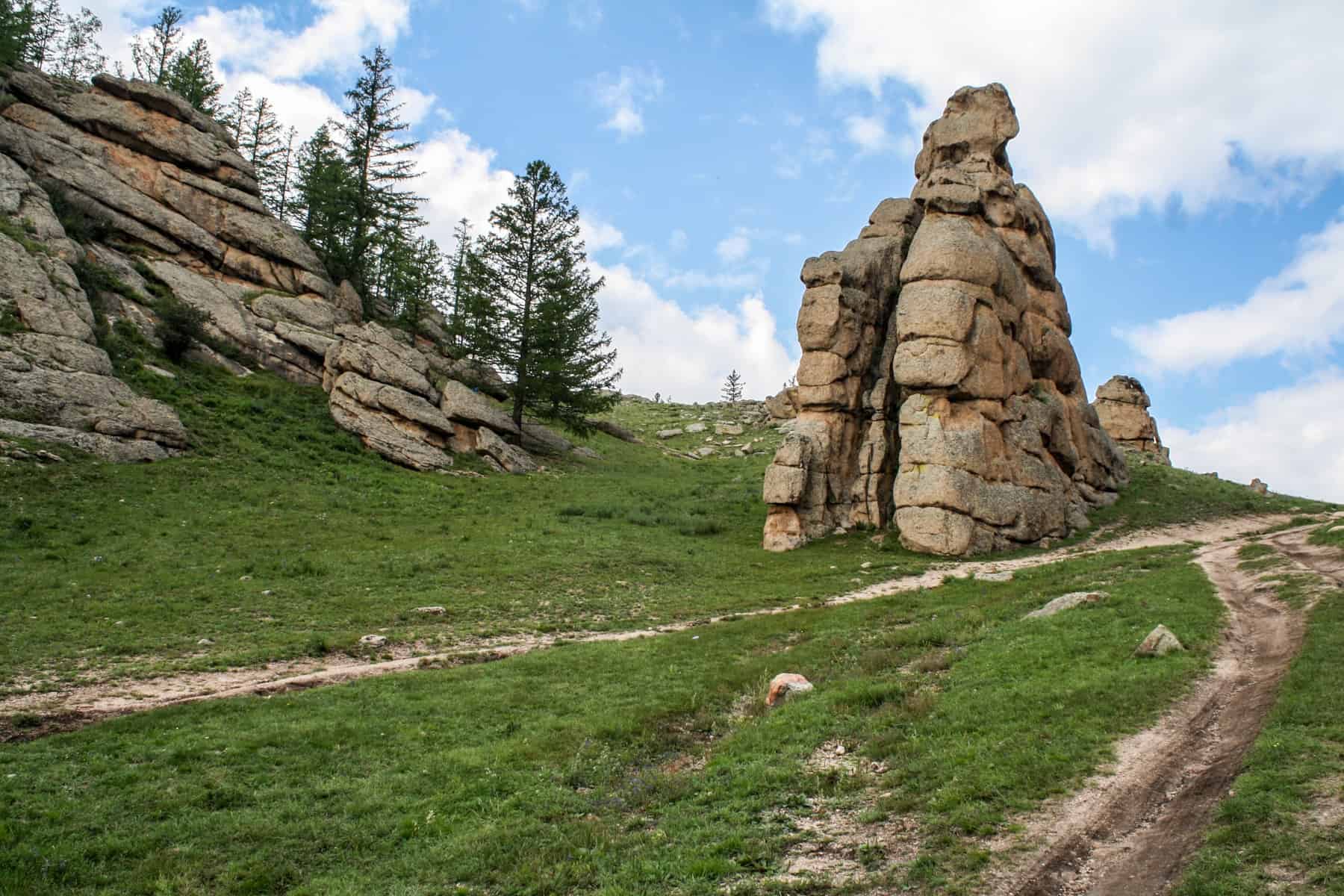
One of the layered rock formations in Terelj National Park in Mongolia
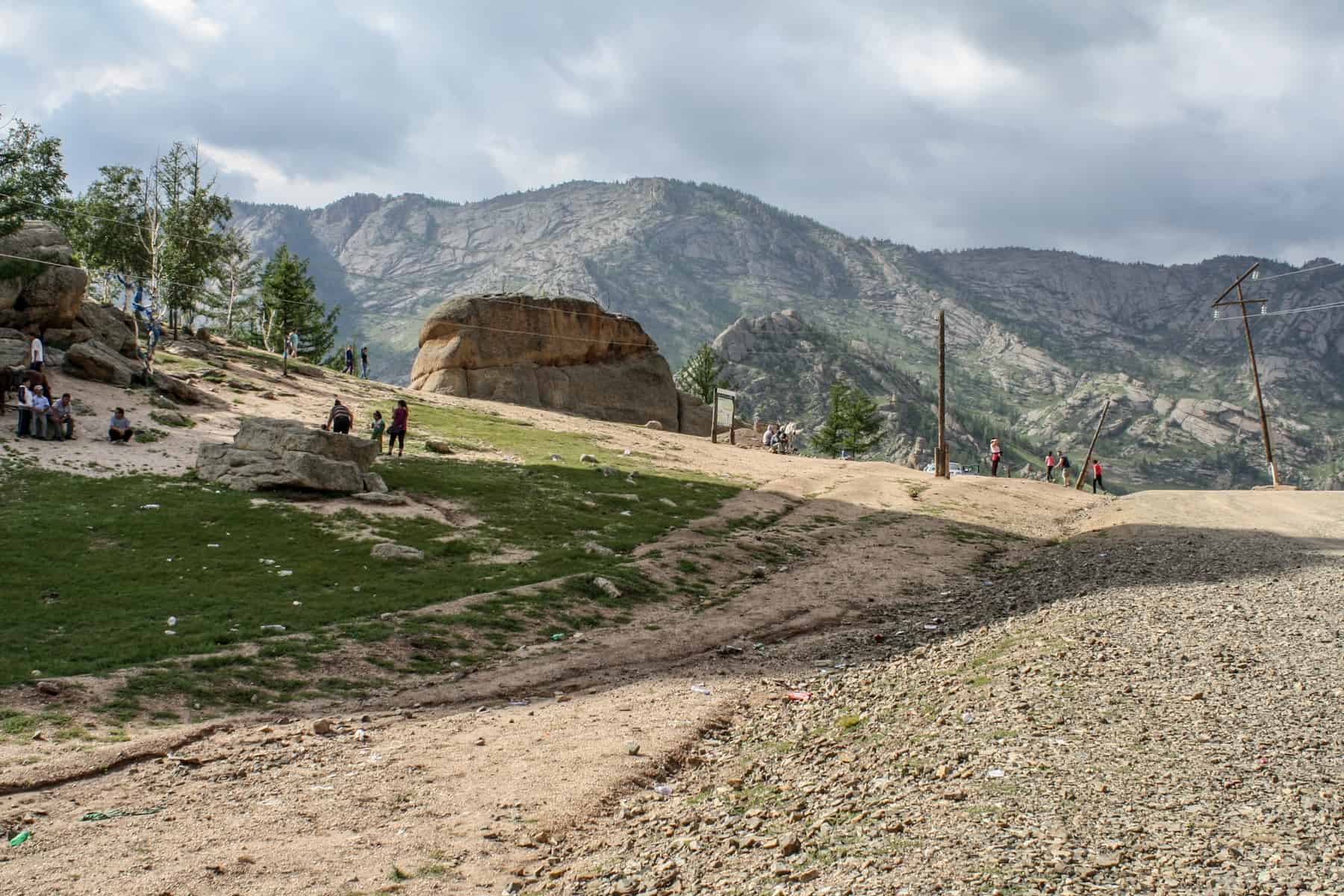
Visiting Turtle Rock in Terelj National Park Mongolia, named for its shape similar to the animal
Nothing beats the end of the wilderness journey than a visit to the giant 40-metre tall silver Ghengis Khan statue just outside of Ulaanbaatar on the banks of the Tuul River. Legend has it that it was at this spot that Ghengis Khan found his golden whip. Anyhow, a bit of a pilgrimage spot for locals, it was fascinating (if not a bit odd and imposing in the same way a colossal silver statue of Hitler in Germany would probably evoke the same feeling).
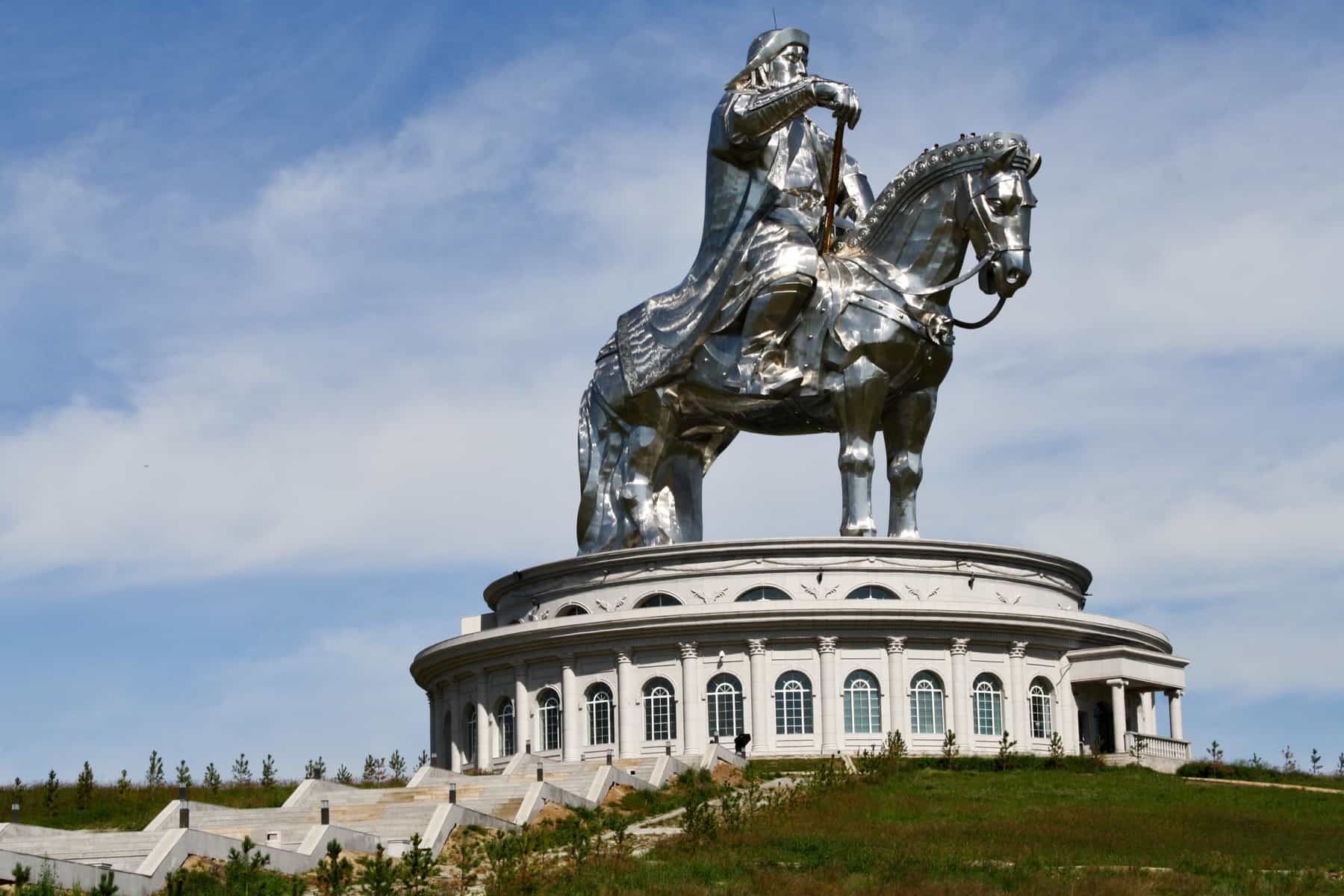
40-metre tall silver Ghengis Khan statue just outside of Ulaanbaatar, Mongolia
Back in Ulaanbaatar, I turned my hostel room into an office and distracted myself with a pizza slice, cake and coffee at Wendy’s Bakery – worth a visit alongside the State Department Store, which is right next to the hostel area. It’s an excellent chance to rest up after adventure through the vast landscapes of Mongolia.
The Dragoman overland truck is what we called home, except we didn’t sleep on it overnight. Instead, we went wild camping and every night, checking into a hotel once when the rains were too much to settle a tent comfortably.
The Outside
The truck’s exterior has lots of compartments – storage for luggage and tents and a clean water supply, mealtime equipment and food supplies. It’s a travelling transformer, and everyone has to lend a hand setting up and packing down for breakfast, lunch and dinner.
If you have no sense of camaraderie or hate getting dirty, then this isn’t the kind of adventure trip for you. I embraced it and loved every minute of ‘roughing it’.
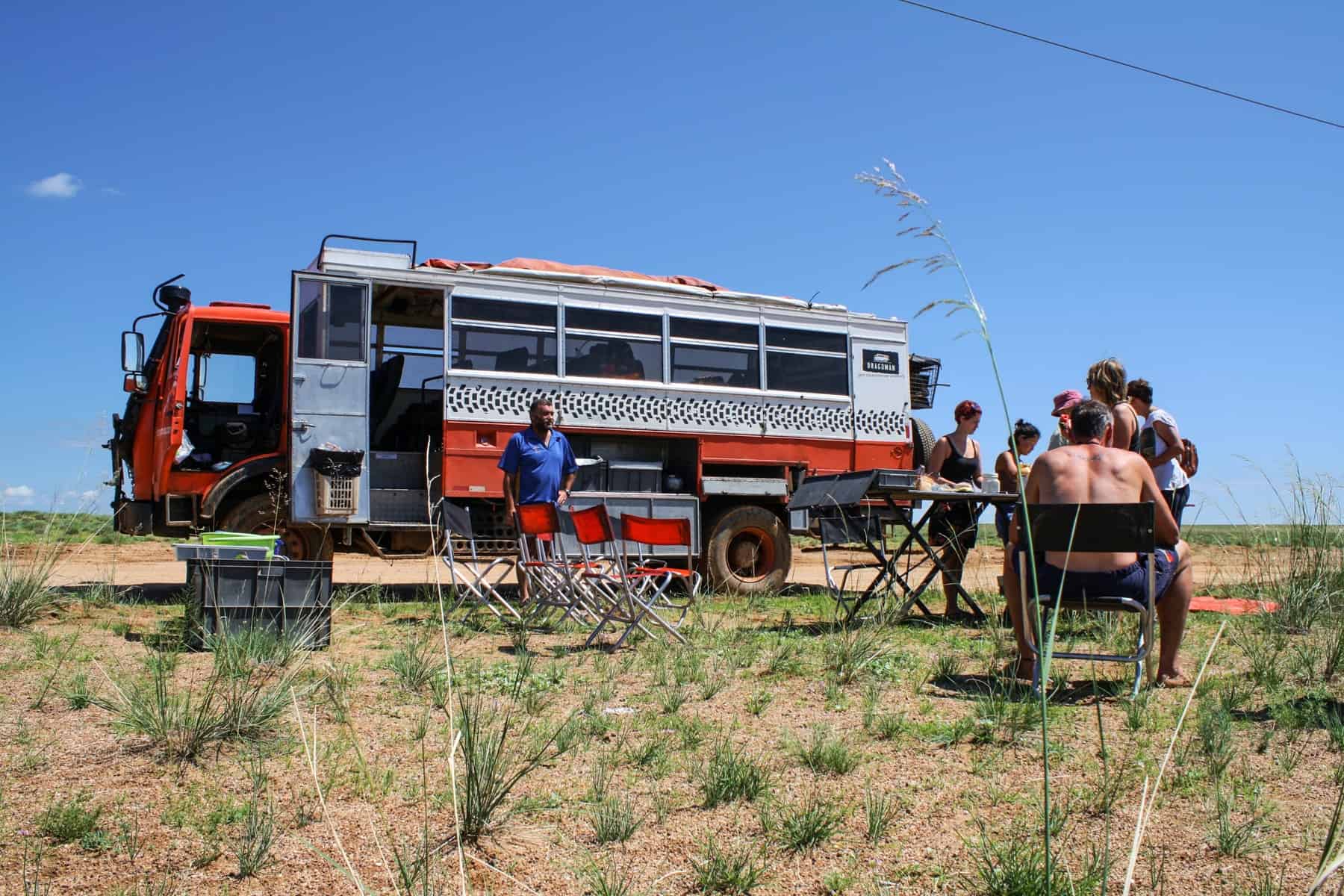
Travel in Mongolia was mostly about camping.
Twenty-three seats, a fridge, a safe, a bookshelf, prominent speakers and a place to recharge equipment, this is where we spend hours at a time, or what could end up being an entire day, traversing the landscape. We filled it with our belongings like a messy bedroom and made it cosy.
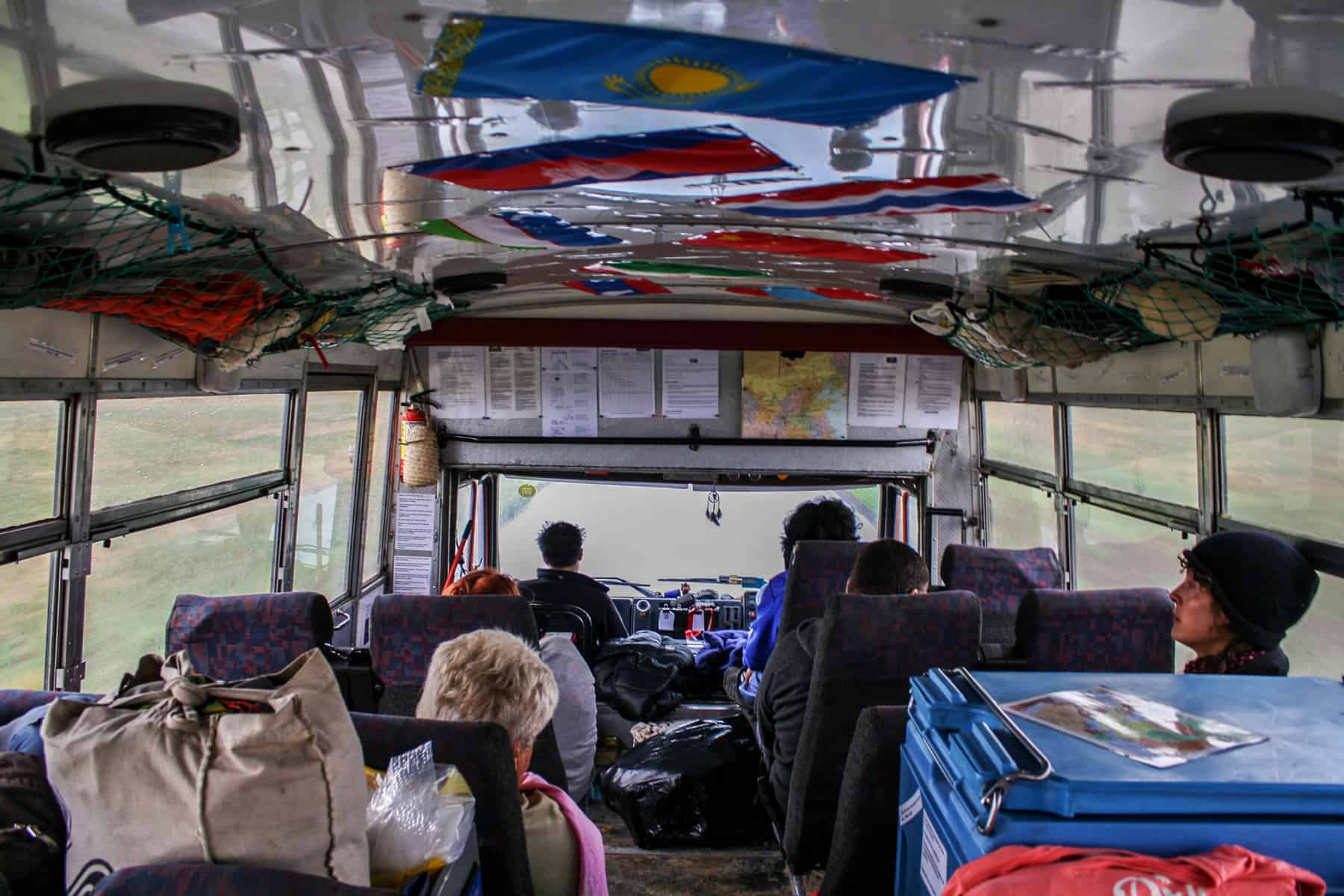
Inside the Overlanding truck on the journey travelling Mongolia
Along the Way
The two drivers are the mechanics, the navigators and the troubleshooters. Everything about the truck, from where it goes and how it gets there, hangs on their decision making, alongside our Mongolian guide who knew the land better than anyone else and could speak the language when we needed to call upon locals for help.
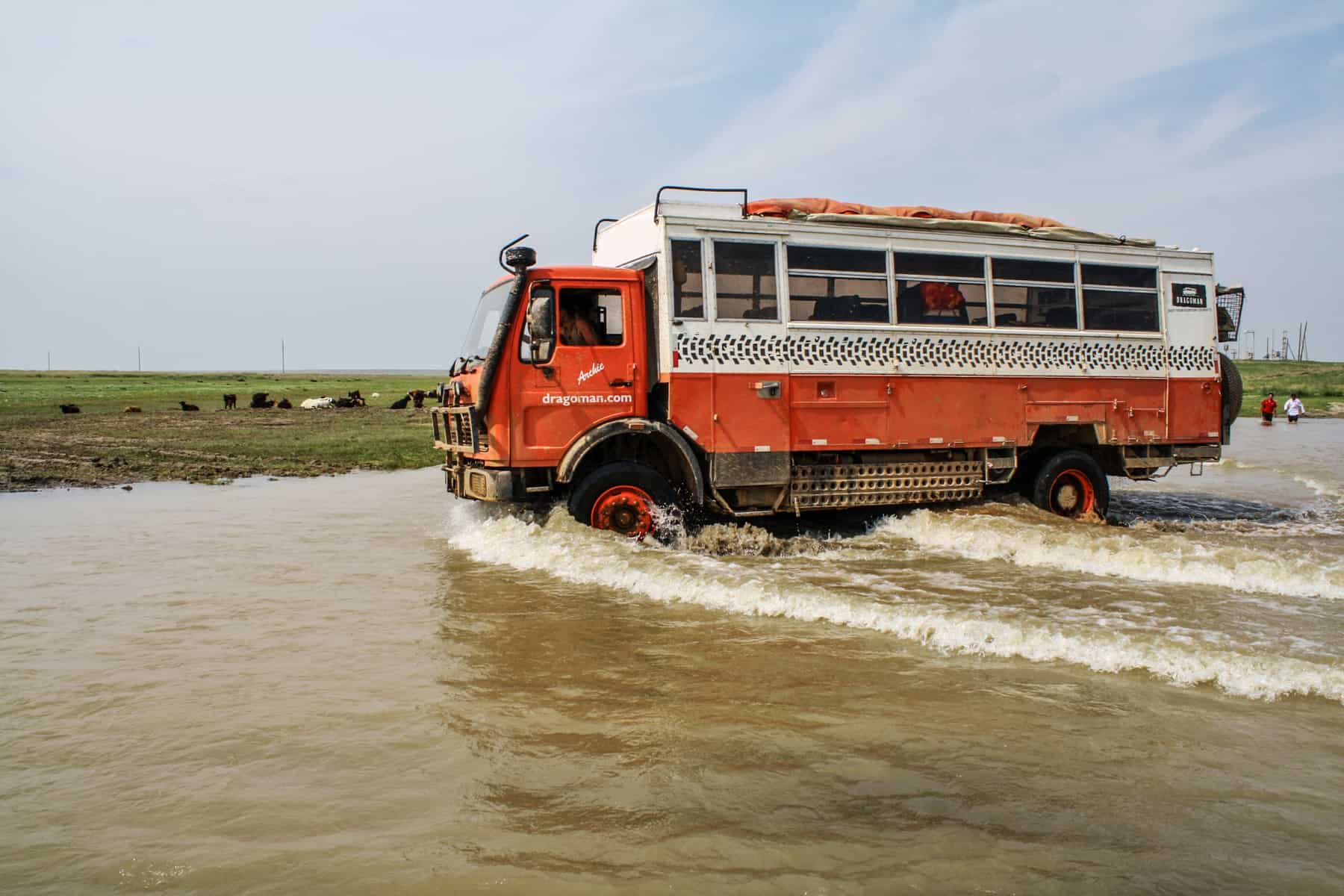
Overlanding in Mongolia was a real adventure.
Although the drivers would jump out to check the road, walking far ahead to determine the best track to take or check waterlogged areas (often by getting in the water) to limit the truck’s chances of getting bogged. We often stopped to help locals whose cars were stuck, knowing that karma would need to be returned one day.
The Realities of Rural Travel in Mongolia
“Ok, guys, you have to get off. It’s not looking good.” This phrase, accompanied by the engine’s low hum and strain as it finally gave up, became a regular occurrence during the three weeks I spent in Mongolia. Getting dirty in Mongolia is a given, but I never thought on my travels that I would push a truck out of thick, stodgy mud, build a road complete with a dam or wade knee-deep through a river to get to the other side.
In Mongolia, aside from the small handful of roads available, you will take the path less travelled, one that hasn’t been used for days or worn in by other vehicles for an easy pass. You could call it bad luck, or you could call it a reality, but travel comes with its challenges and getting stuck in Mongolia is by far the most common. While I wasn’t expecting substantial bogging incidents on this trip, I began to embrace them when they did happen. After all, the locals have to face these situations regularly. It became a part of what Mongolia is and what it means to cross her lands.
The drivers of the truck were responsible for assessing each situation when it arose. They were the first to get dirty, walk through the water and determine the outcome. At times it put you on edge, wondering how long you would be stuck somewhere with no one passing by for hours. At other times it merely meant us having to walk a short distance to lighten the truck.
Either way, the result was a massive whoop and roar for our truck, Archie, when he made it through. It felt good, and we then knew the next stage of the journey could begin. These are the times I’ll always remember.
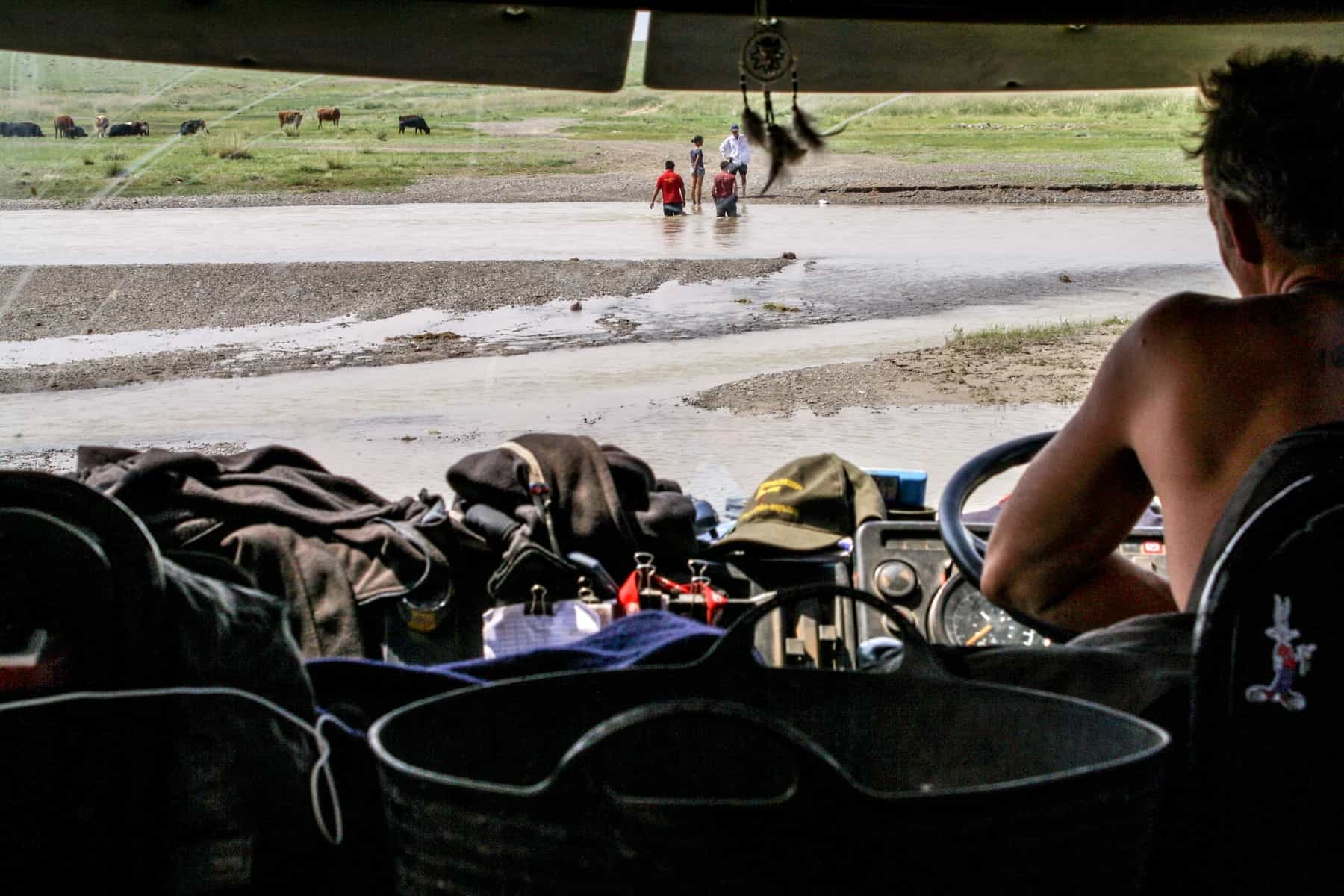
Our group helps find a track in the water for the truck to pass in Mongolia.
It had been raining on and off for a few days, mainly in short spurts in the evenings, and we were bumping along the wet dirt tracks just fine. When the truck stopped, and we saw that two pools of water had filled two road tracks, we knew a bogging incident was imminent. The drivers walked, pondered and walked through the water. Could we drive through it without getting stuck?
The usual scenario rested on two possibilities – drive through it or find hard enough ground around it. Except that this time it was different. We were told: “We need to empty this road of water and then let the ground dry out so we can cross over it.”
Cue the mad dash to empty our camping gear to find our plastic washing-up bowls and any other form of a plastic container to begin the removal process. The ladies rolled up their shorts to get right in there and scoop out the water as the men started digging to create a road. Everyone built a dam by hand on each side of the tyre track grooves so that the emptied water wouldn’t flow back in.
It was hard work, but we became a team, a great team. The sun was shining that day which meant we only had to wait a couple of hours while the heat dried out our creation. We ate, we played, we sang, and we marvelled at what resourceful people we were. It was a scary moment when Archie made his move to cross our road (our beautifully crafted highway that could be crushed in seconds and need rebuilding), but he made it in one unbeaten run, and our handmade route was left to the land and in nature’s control.
Happening upon grassy, muddy areas is sporadic. You can never tell exactly how hard the ground is beneath it. After bouts of rain, the ground softens, and even though there were times when the truck had to work a little harder, it made it through.
We had just had a fantastic afternoon checking out a local Nadaam festival and were in high spirits, which we needed knowing that we would be driving for the rest of the day. Except we didn’t – we were soon stuck in thick, sticky mud, and no amount of pushing and revving was going to change it.
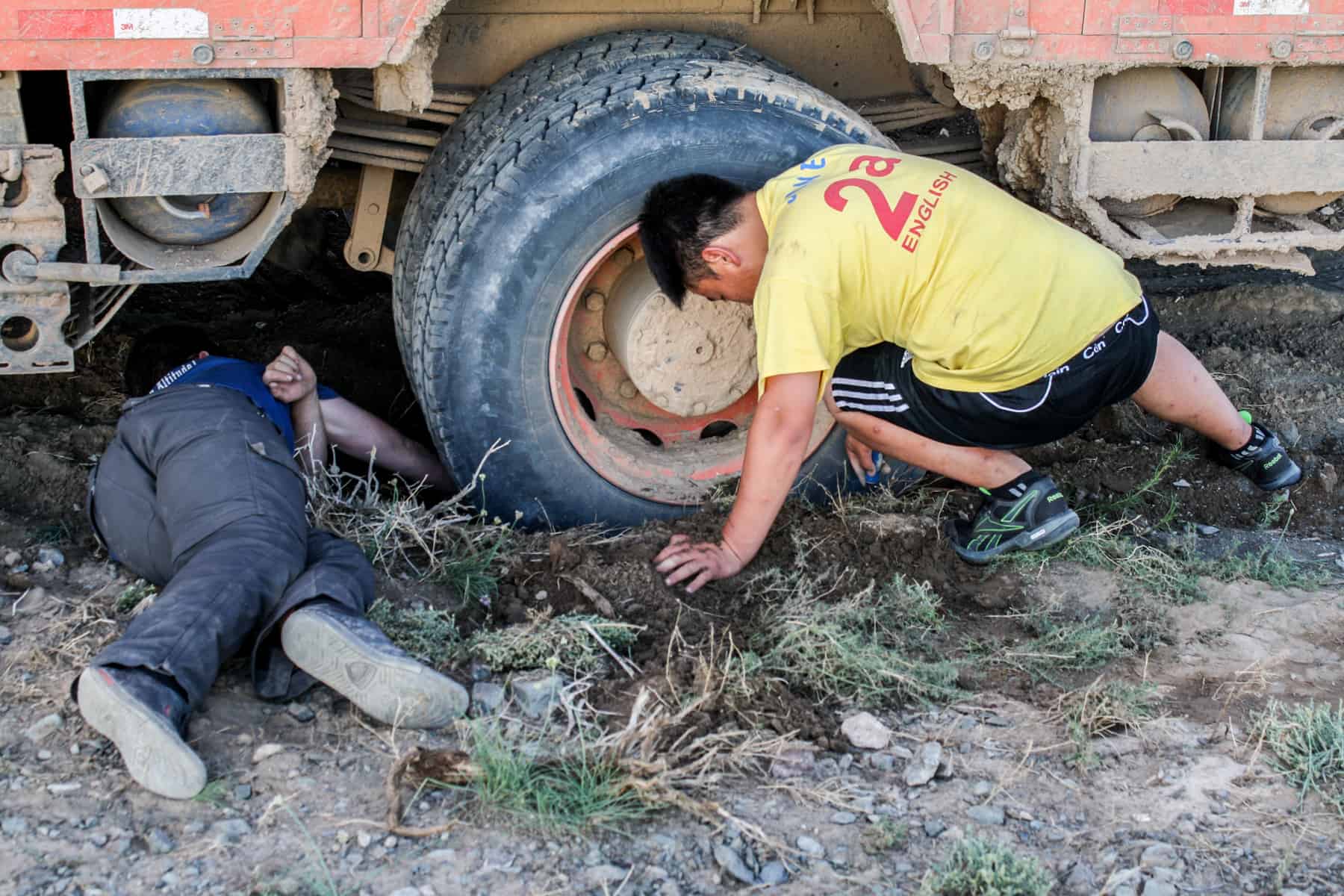
Digging out the truck wheels from the deep, wet mud in Mongolia
Our Mongolian guide walked to the nearest ger to get help, and the locals later returned on a motorbike to check out the situation. The whole family came out – we regularly became a source of fascination or amusement en route through the country. However, they kindly decided to use their big, industrial tractor to help pull the truck out of the mud – that too got stuck.
With two vehicles out of action and night starting to fall, we decided to set up camp on a drier patch of land nearby, and the drivers worked relentlessly with the locals throughout the evening. We got bogged at 5 pm, and it took until midnight for the truck to be pulled from sludge. It was a day wasted, but another example of how unpredictable travelling here can be.
When the truck stops dead at a deep area of water, you know the situation isn’t going to be resolved quickly. Can a truck this size pass through a river without sinking or getting stuck? Although we enjoyed paddling in the freshwater, we didn’t know whether we could have to completely re-route to get around it and lose more time.
The conclusion was that there was a distinct lack of knowledge about alternative roads around the river, and somehow we would have to find a way to get through it. With a small truck already stuck right in the middle, it was a scary prospect.
The drivers identified the most shallow and hard ground area in the water to pass, although we couldn’t be on the truck, unfortunately. You can imagine the chaos – a group of locals trying to rescue their vehicle and 20 non-locals trying to navigate through the water, knee-deep and screeching, scared of falling in.
My heart skipped a beat watching our truck splash through the water and wondering whether it would stop dead in its tracks and slowly swim in a sea of mud, taking all our belongings with it. But Archie made it, and this time, he got the biggest cheer. And a giant sigh of relief.
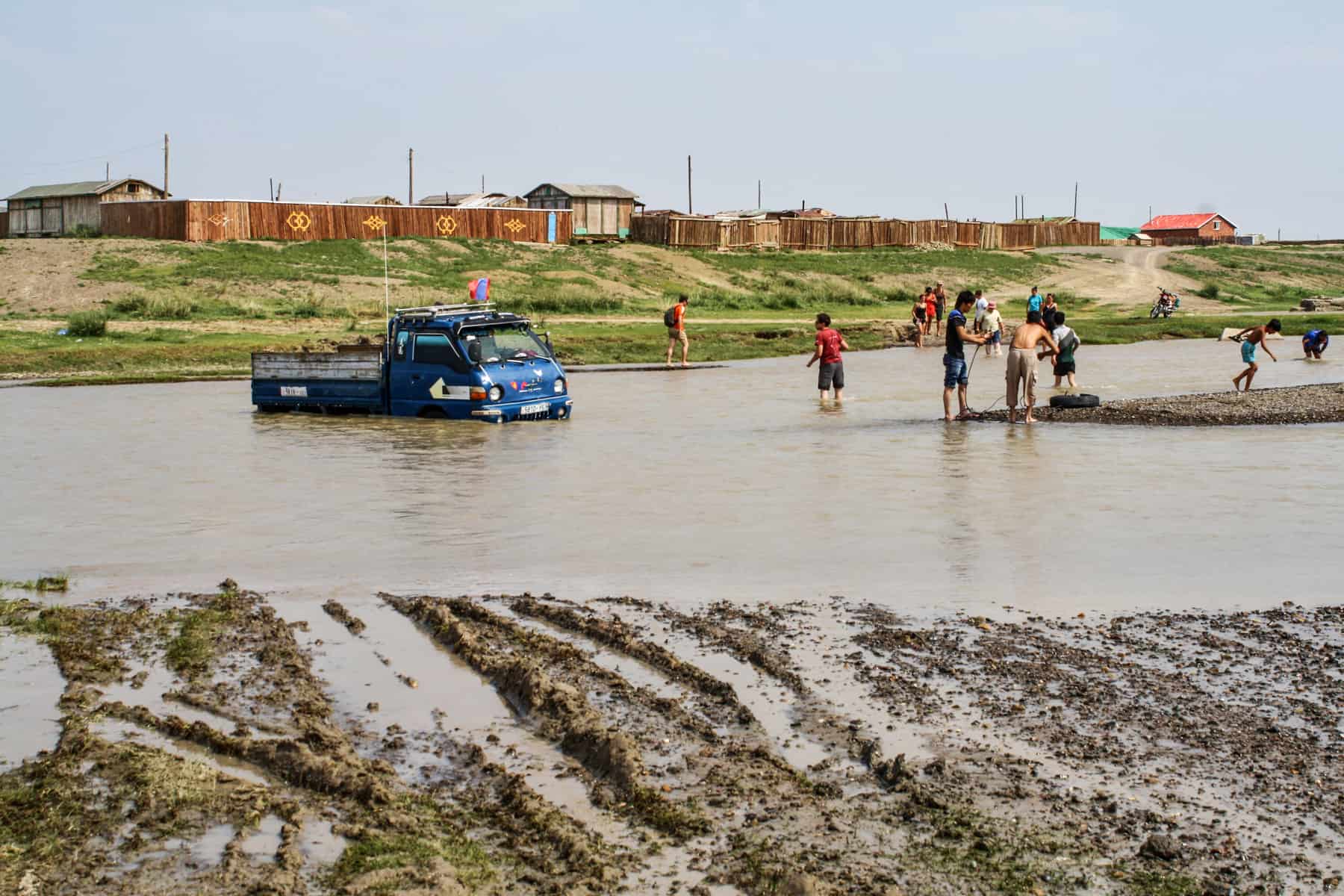
Typical river crossings in Mongolia and helping out locals who were also stuck
With unpredictable weather conditions, a challenging landscape to navigate and a trip mostly comprised of wild camping, packing for Mongolia requires some planning. In short, you need to factor in the following:
- Items of clothing that you don’t mind getting dirty and wholly ruined.
- Clothing layers for the constant switch of hot and cold climates – thermals to moisture-wicking and waterproof items.
- Sun protection and bug spray for mosquitos and sandflies.
- All medications you need as you’ll often be far from any significant stores or aid.
- Snacks from home as the food variation can get very repetitive.
For a more extensive overview, read my full Mongolia Packing List .
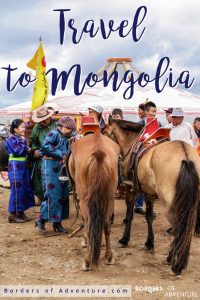
About Becki
Becki Enright is a British Travel Press Award-winning writer whose work focuses on changing perceptions about misunderstood aspects of destinations. Her writing combines storytelling with insight into the social, historical, political and economic factors that shape the country or place in relation to tourism. Becki has appeared live on Sky News and CNN and has contributed to high profile media including National Geographic, Time.com, Guardian online, New York Times, Grazia and Buzzfeed.
- Article Archives
- Work with me
- Privacy Policy

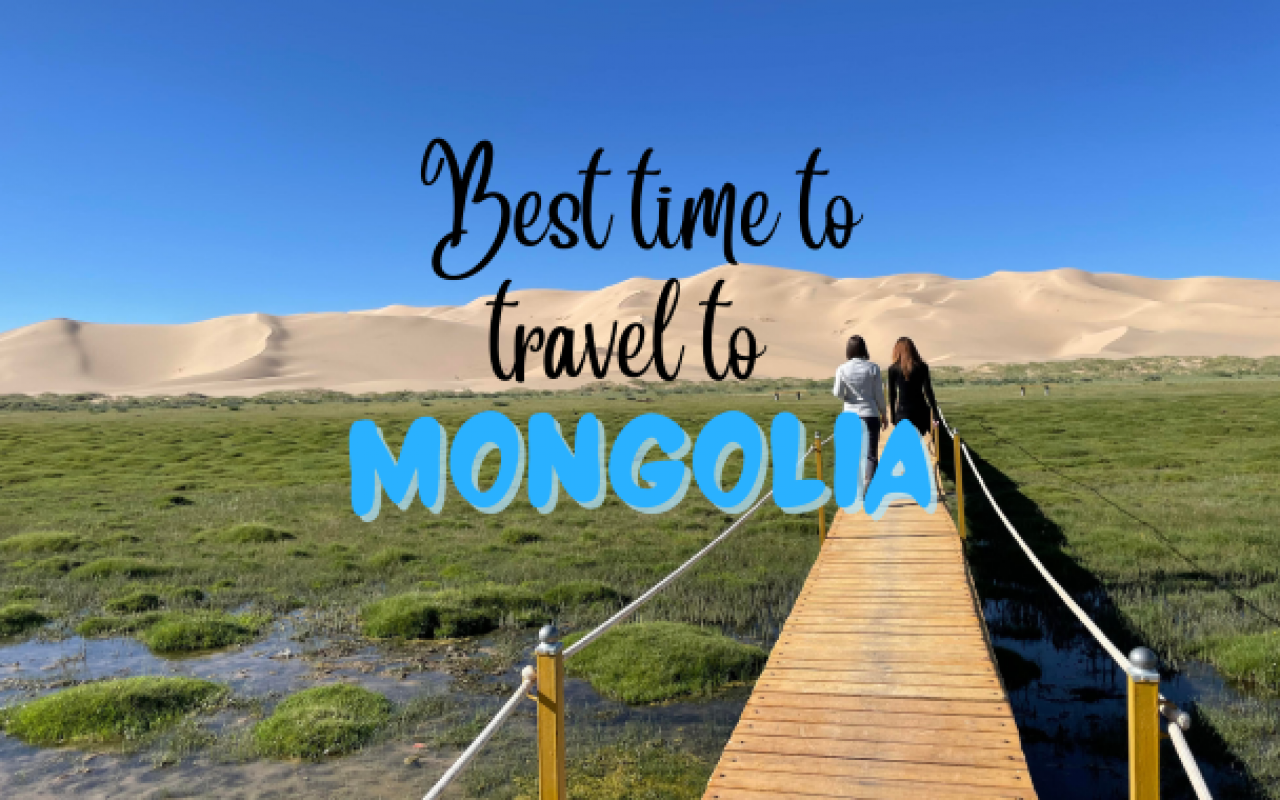
- Best time to visit Mongolia
The Best time to visit Mongolia
The most popular time to visit Mongolia is generally from June to late September, when the weather is either warm or pleasant. June through August are the warmest months in Mongolia. Going into autumn, the temperatures tend to get a bit cooler specially at night but are still comfortable for travel. Spring and winter can all be good times to visit, but it depends upon the activities you want to do and where you want to go.
Here we described best times to visit to certain regions of Mongolia to help you make the right decision.
Best time to visit Gobi Desert The best month to visit to Gobi Desert is autumn from August to early October. However, tourism period to Gobi is the longest, compared to other regions in Mongolia due to its warm weather even in spring and autumn. That’s why Most tours to Gobi are organized from May to early October.
Best Time to visit Western Mongolia The best time to visit Western Mongolia is also July to August when sunny days throughout Mongolia. But early October is chance to see Golden Eagle Festival in Ulgii town, Western Mongolia.
Best time to visit Northern Mongolia & Khuvsgul Lake Since Northern Mongolia gets colder earlier than other parts of Mongolia, Only July to August is the best season to travel to Northern Mongolia and Khuvsgul Lake. Though deep Taiga where reindeer herders camp in winter can also be popular in the winter months.
Best Time to visit Ulaanbaatar and Central Mongolia Perfect time for sightseeing and exploring Ulaanbaatar is from mid-June to August. In summer time, the city experiences the pleasant weather and very relaxing days due to schools are on holiday, most of Ulaanbaatar residents get their annual leave in summer time between July and August. City’s surrounding beautiful National Parks like Terelj National Park and Hustai National Parks are great to explore all year around.
When is the best time to experience Mongolian winter? February is the best time to experience Mongolia winter season. Because there are some fascinating events like “Ice Festival” in Khuvsgul Lake, “Camel Festival” in Gobi Desert area and Mongolian Tsagaan Sar (Lunar New Year) is celebrated which is very worth to experience. However, from November till the January is still an option. Mongolia offers other daily activities in winter such as visiting nomad family winter camp, dog sledding, ice skating, and skiing etc...
- 5 Drinks You Should Try in Mongolia
- Mongolia Tour Planning
- Top destinations to visit in Mongolia
- Mongolian Visa
- Mongolian Weather
- Travel planning
- Mongolia Overview
- Facts about Mongolia
- Mongolia Geography
- Mongolian Economy
- Ulaanbaatar
Tours you may like

Bogd Khan Mountain & Manzushir monastery hiking day tour
- Visit nomad family & experience their unique lifestyle
- Perfect destination for 1 day hiking tour
- Enjoy hiking in serene nature and taking photos
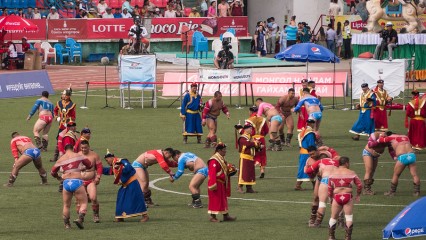
Naadam Festival Classic 3 days short tour
- Enjoy dramatic scenery of Terelj N.P
- Experience the madness of biggest national Naadam Festival

Mini Gobi & Terelj National Park 3 days tour
- See the truly Wild horse
- Visit fabulous mini Gobi- Elsen tasarkhai sand dunes.
What our Clients Say
"great customized service", "trip of a lifetime", "exceed all expectations".

- Car rental & airport transfer service
- Terms & Condition
- How to book a tour?
- How to pay?
- email [email protected]
- phone +976 70117770
- WhatsApp: +976 90099908
MONGOLIA WEATHER » MONGOLIA CLIMATE
Best time to travel to mongolia.
The warmest and the best time to travel to Mongolia is between 15 May and 15 September. Mongolia is a unique country, climatically, culturally, and the grandeur of pristine nature. It has four distinctive seasons; all seasons have specific features, colors, and activities to offer almost all types of travelers. Getting to know about the vast open country’s climate, which fluctuates dramatically depending on the season, varied geography, altitude, daytime, and nights could help you plan your perfect holiday, whether you are a leisure traveler or an adventure seeker. Also, you will find out when is the best time to travel to Mongolia except for getting to know the best things to do during specific months and seasons.
Mongolia Spring: 15 February to 30 April
Spring is the time for the nomads to welcome newborn baby animals. We recommend you to travel to Mongolia in spring for a stay with nomads if you are a curious traveler, who likes adventures, and are interested in culture while enjoying scenic places, attractions, and the vastness of Mongolia. Mongolian spring weather fluctuates somehow; it is windy, occasionally stormy, particularly in the Gobi desert. Spring is an off-tourist season. The seasonal accommodation ger camps close 5 October through 1 May, which will allow you to experience authentic Mongolia and communicate with the locals. As well as, the spring tour price is lower compared to summer.
Mongolia weather in February
The spring starts in February, but there are still signs of winter with random snowfalls and chill wind until mid-March. Mongolians celebrate the famous winter holiday Tsagaan Sar at the end of January or February. It depends on the lunar calendar. February temperature ranges -15°C to -3°C daytime and -23°C to -8°C at nights between 15 February and 28 February.
Mongolia weather in March
March is a month of the winter festivals and events ; Ice Festival at Khuvsgul Lake, Eagle Festival near Ulaanbaatar, and Thousand Camel Festival near Bulgan town of Umnugobi province. The temperatures in March are -8°C to +15°C daytime and -15°C to +5°C at nights.
Mongolia weather in April
The average temperature in April alters between -2°C to +22°C daytime and -8°C to +15°C at night.
Mongolia Summer: 1 May to 31 July
Mongolia weather in may.
Pleasant weather starts in May, the temperature averaging +8°C to +28°C daytime and 0°C to +16°C at night. However, May can surprise you with occasional snowfalls, and the spring chill lasts until the 20th, particularly when you travel north, west, and central Mongolia.
Mongolia weather in June
June is one of the best months to travel to Mongolia in terms of weather; pleasant and dry without a crowd of travelers. The temperature could cool down at night, ranging from +8°C to +20°C, and much warmer daytime between +15°C and +33°C. The landscape turns greener. It is less windy and less rainy.
Mongolia weather in July
1 July through 10 August is the warmest through all Mongolian regions and hottest in the Gobi Desert. Alternatively, it can be wet and cool. The rain in Mongolia is a shower or drizzle rain that lasts some minutes to a few hours most of the time. Average day temperature is +25°C to +38°C and night temperature is +10°C to +18° C. July is a high tourism month due to the weather and Mongolian national holiday Naadam Festival . The official Naadam Festival day is on 11 and 13 July, although the towns, cities, provinces, and villages celebrate their Naadam festival on different days in the first half of July. We have the best group and private Ulaanbaatar Naadam Festival and Local Naadam Festival tours. On top of the Naadam Festival, the Orkhon Valley Yak Festival and Reindeer Festival at Khovsgol Lake are worth attending.
Mongolia Autumn: 1 August to 31 October
Mongolian weather in august.
August is still the high tourist season with pleasant weather and stunning colorful landscapes. The temperature remains warm, ranging from +25°C to +38°C during daytime and +8°C to +20°C at nights until mid-August. The daytime temperature cools down +7°C to +22°C in the last half of August. August and September are good months to explore and experience nomad life. The cooler weather will make your nomad homestay pleasant with a bit of fire if required. With the nomads, you will have authentic experiences, learn about centries old, still existing culture, and try traditional Mongolian meals. If you wish, you can volunteer their animal-related chores and winter preparation.
Mongolian weather in September
September is enjoyable, colorful, not hot, and not too cold. Night temperatures start dropping below 0°C. It sometimes snows in the higher elevated area. Due to the relatively high altitude of Mongolia, you could see four seasons within a day. You may start a day in a T-shirt and shorts. Then wear your windproof warm clothes to stay warm in the wind and snow on the same day. In autumn, nomads’ animals are fat and graze peacefully. Nomads have plenty of dairy products and are busy processing milk and preparing for the winter makes your visit to the nomad families more interesting. Attractive Golden Eagle Festival takes place in Western Mongolia two times in September and October. We advise you the attend the September Eagle Festival as it is less packed by tourists, costs less, and the weather will be milder. In September, you will have more chances to communicate with the Eagle Hunters and take good pictures. September average daylight temperature is +5°C to +25°C and -5°C to +12°C at nights. Concerning weather and scenery, we suggest you travel to Mongolia in September.
Mongolian weather in October
October is the low season and the end of the autumn. The temperature in October lowers much; -4°C to +12°C daytime and -8°C to +5°C at night. The seasonal accommodation ger camps do not operate from 5 October through 1 May, which allows you to have more local experiences and interact with the locals. As well as, the tour price is low compared to summer. You can check our low season and winter tours .
Mongolia Winter: 1 November to 15 February
Mongolian weather in november.
The weather is relatively mild in the first half of November, with agreeable winter temperatures of -10°C to -17°C daytime. The temperature continuously drops after 15 November, lowering -18°C to -25°C during the sunlight and -22°C to -32°C at nights. The snowfall usually starts in mid-November. Daylight is short between 7:30 am to 6 pm.
Mongolian weather in December and January
January is the coldest, December is the second cold month in Mongolia but no worries. There is more chance of snow cover over the land, which adds beauty. The snow-covered land makes more warm feeling than the snowless area. And it is true because of the sunlight reflection on the snow. Mongolia is unique in winter with the glittering landscapes, fresh air, frozen rivers, lakes, waterfalls, and the nomadic herders deal with the cold, neglecting their comfort for their pasture animal survival. We suggest you not travel to too isolated areas in winter to prevent lack of emergency in case snowstorm closes the road or phone reception. Few people travel to Mongolia in December and January. In winter, we will not promise you comfortable king-sized beds, WC, and shower in most accommodations in the countryside. Even though the tourist accommodation ger camps work in the national parks near Ulaanbaatar, those are more western-friendly. Of course, the tour price is lower than in summer. We offer carefully developed, activities and authentic experiences packed winter tours . The comfort and enjoyment of our clients have always been our priority. Wherever you go, our staff and hosts will do their best to make sure you will stay warm and enjoy your winter activities. Do you need some warm clothes? You can borrow our traditional cloth deel free of charge. Deel has always been the most suitable cloth for the Mongolian climate.

- +976 99035601
- [email protected]
- Why visit mongolia
- Short tours
- Horseback riding
- Special tours
WHEN TO VISIT MONGOLIA
Description, it depends on what you are seeking for. if you are an adventure-seeker with a love of fascinating outdoors, mongolia has a plenty to offer throughout the year. winters are long and cold, and average temperatures over most of the country are below freezing from november through march and close to it in april and october. winter days are mainly – 25 °c (-13 °f) but sometimes can drop to −35 °c (−34 °f) in most years. even in this freezing weather mongolia offers a great number of activities as dog and horse sledding, ice festival, camel festival and most interestingly eagle festival., warm summer days are around 20 °c, but extremes reach as high as 40 °c (104 °f) in the great gobi area and 33 °c (91.4 °f) in ulaanbaatar. the warm summer lasts from may to september with an average daily temperature of 20°c. during this short period of time mongolia displays its beauty of nature and attracts many tourists. tourism peaks in july and august, most companies are fully booked and prices are higher, so booking in advance is advisable..there are also many festivals held throughout the year such as the ‘three manly sports’ of naadam festival (archery, horse racing and wrestling) in july, the thousand camel festival (camel race and polo) in march, khuvsgul ice festival (horse sled) in march and golden eagle festival (eagle hunting) in late september, and there are plenty of opportunities for visitors to experience these and other aspects of mongolian culture..

WHAT TO EAT IN MONGOLIA

WHAT TO DO IN MONGOLIA IN WINTER

CLIMATE IN MONGOLIA

MONGOLIA’S EVENTS & FESTIVALS
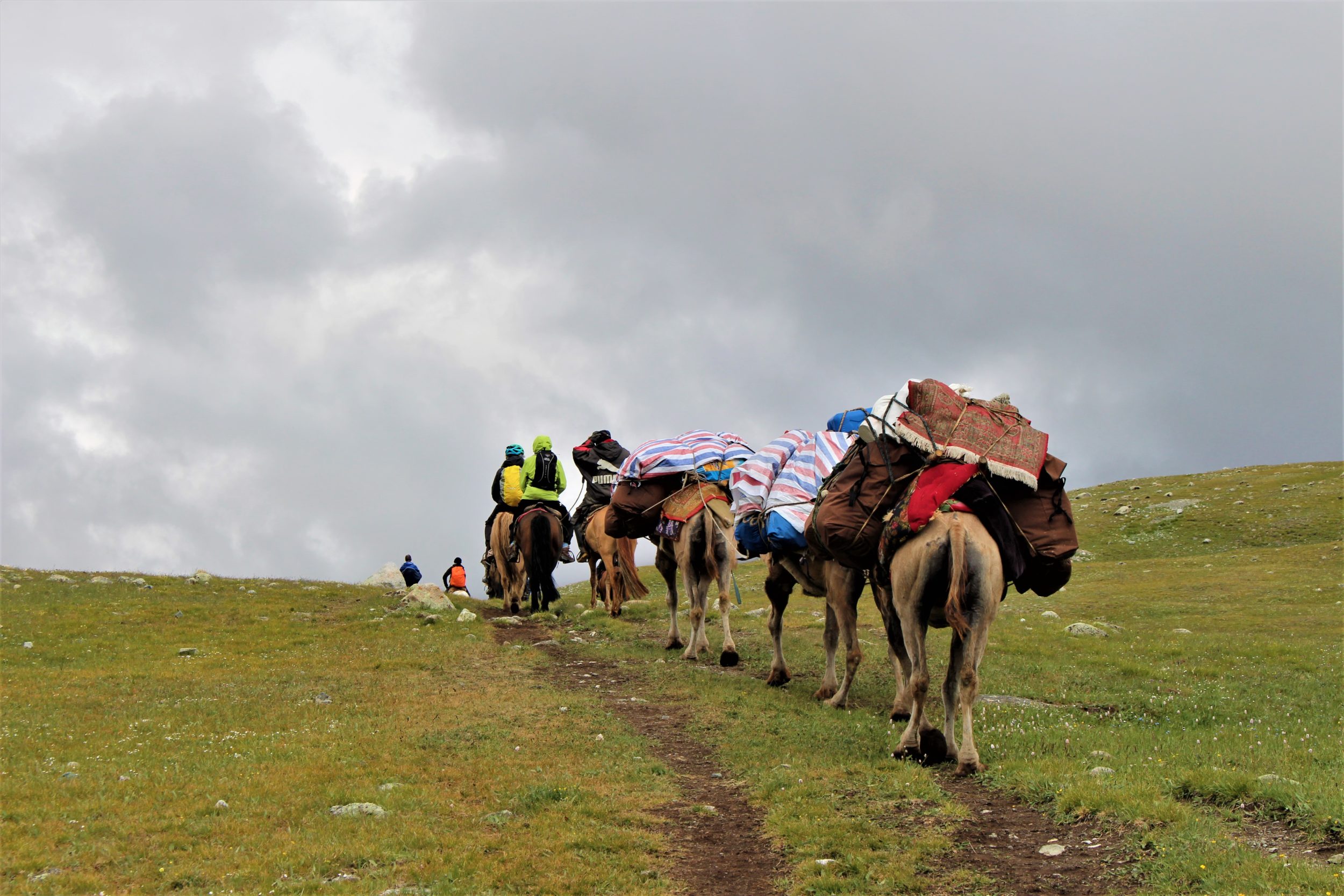
HOW TO GET TO MONGOLIA

LIST OF VISA-FREE COUNTRIES TO MONGOLIA

FACTS & FIGURES
Copyright © 2024. All right reserved.

Look Mongolia is expertise in orchestrating diverse travel and hospitality services, or business networking events, the company's success is also rooted in enduring partnerships with key service providers

Tailor-made adventures in Mongolia
Look Mongolia tours are not typical mass tourism programs; instead, we will tailor the unique, adventurous, and culturally immersive experiences for you.

We pursue excellence
We are dedicated to excellence in our products and services, meticulously attending to every detail. Our commitment is to deliver not only what our customers expect but also the unexpected, ensuring an exceptional experience.
- Seasons and climate

When is the best time to visit Mongolia? The optimal time to visit Mongolia is from May to September. The summer months, spanning June to August, are characterized by sunny days, minimal rain, and lush green landscapes. This period coincides with Mongolia's celebrated Naadam festival, a major tourist attraction held between July 11 and July 13. Due to the festival's popularity, it is advisable to book accommodations, tourist camps, international flights and trains well in advance.
Spring, from March to May, offers fewer crowds but abundant experiences. As nature transitions to green, nomads welcome newborn animals, and migratory birds arrive. May brings warmth, prompting nomads to migrate to their summer settlements in search of optimal pastures at higher altitudes.
Autumn, from September to October, reveals a vibrant display of colors in nature, despite chilly temperatures in the early mornings and late evenings. While winter, with temperatures potentially dropping to -30°C, is not the most favorable time to visit Mongolia, well-prepared adventurers can enjoy rewarding experiences of stunning natural scenes and witness the unique way of life of nomads with minimal tourist presence.
- What is the weather like?
- Nationalities with visa-free entry to Mongolia
- Booking and Pricing Questions: About Our Tours
- Tour Questions: About Our Tours
- Mongolian visa requirements
- About Look Mongolia
- Health and Safety questions
- Traveling to Mongolia: Before Arrival Questions
- After Arrival Questions: Traveling in Mongolia
- Small group tours
- Private custom-made tours
- Cultural tours
- Wilderness Expeditions
- Geology Exploration & Adventurous journeys
- Wilderness Survival & Outdoor Education
- Culture & Art Experiences
- STEAM Learning
- Nomadic Music Festival
- Incentive programs
- Glamping experiences
- How to get a Mongolia visa?
- Nationalities with Visa-Free Entry To Mongolia
- When is the Best Time to Visit Mongolia?
- What is the Weather Like?
- Company Questions: About Look Mongolia
- Health and Safety Questions
- Before Arrival Questions: Traveling to Mongolia
- Look Mongolia travelogue
- Authentic Experiences
- Our expertise
- A Message from our founder

18 Best Places To Visit In Mongolia
By Jessie Festa. This guide to planning a trip to Mongolia contains affiliate links to trusted partners.
Looking for the best places to visit in Mongolia ?
This guide can help!
Located in Asia between Russia and China, Mongolia is one of the world’s most unique places to visit.
Unlike many destinations, Mongolia remains largely untouched by mass tourism. Because of this, you’ll typically get a more authentic experience when it comes to discovering its history, culture, and scenery.
And there certainly is a lot to discover.
Along with breathtaking landscapes that range from steppe grasslands to rugged mountains to dramatic deserts, you can immerse yourself in local culture by doing a ger homestay, visit historic sites to get a glimpse into the country’s fascinating past, spot diverse wildlife that includes rare and endangered species, and visit true bucket list destinations like the famed Gobi Desert.
But, where can you have these experiences? And what are the most important places and landmarks in Mongolia to see?
Keep reading to learn some of the most unforgettable destinations you should consider adding to your Mongolia itinerary!
Free Mongolia Travel Planning Resources
But first, before we go over some incredible Mongolia tourist attractions , I invite you to grab access to my free Ultimate Travel Planning Kit — which includes 40+ travel resources — from printables to quizzes to itineraries — all meant to help you explore the world beyond the guidebook!
Some highlights of the kit include:
- Free “Where Should You Travel Next?” personality quiz
- Pre-plotted Google Maps for 45+ destinations
- Printable travel journal with writing prompts
- Packing lists for different types of trips
Once you’ve grabbed your copy , keep reading to discover some of the top Mongolia things to do.
Mongolia Travel Map
To help give you a lay of the land, here is a map for visiting Mongolia in Asia . It includes the recommended places to visit in Mongolia mentioned below pre-plotted:
Click here for an interactive version of the Mongolia map .
Best Places To Visit In Mongolia
On that note, let’s dive into some of the top places you should add to your Mongolia itinerary. As you’ll soon see, a few main draws to visiting Mongolia include its astounding natural beauty, rich culture, and fascinating history, all of which you can explore through the below spots.
1. Ulaanbaatar
No trip to Mongolia would be complete without spending time in the capital city of Ulaanbaatar. This is the country’s cultural hub where you can explore Mongolian heritage while also enjoying modern amenities. Museums, art galleries, performances, restaurants, and cultural events can all be enjoyed here.
While there are many fun things to add to an Ulaanbaatar itinerary, a few not to miss Mongolia attractions in the city include:
Zaisan Hill Memorial was built between 1971 and 1974 to show gratitude to the Soviet Union (USSR) for its assistance during Mongolia’s fight against Japanese forces. It features a memorial complex honoring the Soviet soldiers who lost their lives during WWII.
Additionally, you can enjoy sweeping views over Ulaanbaatar as you take in the city skyline, the Tuul River, and the surrounding hills and mountains.
Just note that to reach the top you’ll need to walk up 600 steps, though you can cheat a bit by going inside the mall at the base of the hill. Here there is an elevator that can get you about halfway up.
Gandantegchinlen Monastery (Gandan Monastery) was founded in 1838 and is one of Mongolia’s only Buddhist monasteries to survive Soviet rule when many of these sacred places were destroyed. Today, it’s the country’s largest active monastery. Inside, you can also view a golden 26.5-meter-tall Avalokiteshvara, the Buddha of Compassion.
The National Museum of Mongolia is one of the most important museums in the country. Here you can peruse a huge collection of artifacts and exhibits that showcase the country’s history, from prehistoric times to the present. A few highlights of the museum include viewing traditional costumes, archaeological discoveries, and religious artifacts.
2. Gorkhi-Terelj National Park (Töv Province)
If you’re looking for Mongolia places to visit near Ulaanbaatar, Gorkhi-Terelj National Park is a top pick. Known for its stunning landscapes that range from vast valleys to lush forests to towering rock formations, it’s a great place for hiking, horseback riding, and camping.
Additionally, you can interact with nomadic families and can even stay overnight in a ger — a must-have experience during a visit to Mongolia. A ger is a portable and round traditional dwelling that is similar to a yurt, though there are some regional and cultural variations in the terminology and design.
Two popular attractions in this park include Turtle Rock , a giant rock you can hike up that looks like a turtle, and Ariyabal Meditation Temple , a spiritual retreat where you can meditate and relax in a serene setting.
3. Hustai National Park (Töv Province)
Home to beautiful landscapes and diverse wildlife, the main reason this is one of the best places to see in Mongolia is its wild horses.
In fact, Hustai National Park is famous for reintroducing the endangered Przewalski’s horse, also known as the Takhi or Mongolian wild horse.
Today, the park acts as a protected area and reserve for these horses which, according to my guide when I visited, is the only true wild horse in the world.
You can drive around on your own or with a biologist to try to spot these beautiful creatures. Additionally, keep your eyes peeled for marmots (you’ll see a ton of them), red deer, Mongolian gazelles, and a variety of bird species.
To further your education, the Hustai Visitor Center has a small but informative museum, video viewing room, and gift shop.
4. Gun-Galuut Nature Reserve (Töv Province)
This protected area in Mongolia showcases diverse landscapes — including wetlands, mountains, rivers, and grasslands.
If you enjoy outdoor adventure , it’s one of the top places in Mongolia for hiking, horseback riding, and cycling. Birdwatching is also popular, particularly around Lake Khökh .
Additionally, the nearby Kherlen River provides opportunities for kayaking, rafting, and fishing.
If you enjoy wildlife spotting, Gun-Galuut Nature Reserve is home to animals like the endangered Saker falcon, Mongolian gazelle, argali sheep, and wild boar.
Want to immerse yourself in Mongolian culture? Opt to stay overnight in a ger!
5. Lake Khovsgol National Park (Khövsgöl Province)
Lake Khovsgol National Park, also known as Khövsgöl Nuur National Park, features 8,865 square kilometers (3,423 square miles) of natural beauty.
Along with typical outdoor adventures like hiking, horseback riding, and camping, it’s one of the best places in Mongolia for wildlife spotting. This is because it’s home to several endangered and rare species, such as the Siberian ibex, argali sheep, Eurasian lynx, and the gray wolf.
The main attraction within the park is the namesake Lake Khövsgöl — one of Central Asia’s largest and deepest freshwater lakes and one of the best places to visit in Mongolia.
Showcasing crystal clear waters surrounded by mountains, meadows, and forest, its nickname is the “Blue Pearl of Mongolia.”
6. Amarbayasgalant Monastery (Selenge Province)
The main reasons to visit this Buddhist monastery include its cultural significance and stunning traditional architecture with intricate artwork, detailed carvings, and vibrant murals.
In terms of design, the Amarbayasgalant Monastery complex features several temples, prayer halls, dormitories for monks, and administrative buildings — with the most impressive structure being the Zuu Temple , which houses a large statue of Buddha Amitayus.
Amarbayasgalant Monastery was originally constructed in the 18th century to honor Zanabazar, a spiritual leader and an influential figure in Mongolian Buddhism.
7. Gobi Desert (Several Provinces)
No list of the best places to visit in Mongolia would be complete without mentioning the Gobi Desert. Personally, this was a main highlight for me when I visited Mongolia thanks to its epic scenery, diverse landscapes, and outdoor adventure opportunities.
As the Gobi Desert is vast, it actually spans several provinces, including:
- Ömnögovi Province
- Dundgovi Province
- Bayankhongor Province
- Dornogovi Province
This also means you’ll encounter a wide variety of landscapes: open spaces, rolling sand dunes, rocky cliffs, canyons, and steppe grasslands that seem to stretch on forever.
In terms of other worthwhile activities in Mongolia, keep your eyes peeled for snow leopards, Bactrian camels, Gobi bears, Gobi gazelles, and numerous bird species.
Speaking of camels, did you know Mongolia is one of the few places in the world where you can see two-humped camels? During my three days in the Gobi, I saw these rare camels multiple times, so your odds of spotting them are pretty good.
Something really neat about the Mongolian Gobi Desert is that it’s the largest dinosaur fossil reservoir in the world, according to UNESCO . I’ll share more about how to explore this when we discuss Bayanzag!
8. Baga Gazriin Chuluu Nature Reserve (Dundgovi Province)
I’ll never forget driving through the Gobi Desert and approaching Baga Gazriin Chuluu Nature Reserve. Suddenly, vast open space turned to giant rock formations and granite outcroppings begging to be climbed and photographed.
Interestingly, only 5% of the Gobi Desert is covered in sand , and this reserve in particular showcases a landscape so different from what you might typically picture when thinking of a desert.
It’s recommended to camp overnight so that you can be perfectly situated for evening stargazing and a morning sunrise hike. Also be on the lookout for snow leopards, argali sheep, ibex, and various bird species.
9. Tsagaan Suvarga (Dundgovi Province)
Also known as White Stupa, this unique geological formation showcases giant limestone cliffs that look like a row of stacked stupas due to erosion and weathering over millions of years.
Not only does the shape of the cliffs make them striking, but also the colors, as they range from white to orange and red. Definitely bring your camera to take photos from a variety of angles as you walk the designated paths.
Another highlight of Tsagaan Suvarga: the panoramic views of the surrounding desert landscape and Mongolian countryside!
10. Ongi Monastery Ruins (Dundgovi Province)
During the late 1930s, a series of political repressions and purges known as the Mongolian Purges took place. They were the result of Soviet leader Joseph Stalin and his policies that aimed to eliminate perceived threats to his regime and establish tighter control over Mongolia.
This included replacing religious beliefs with communist ideology. It is estimated that thousands of Buddhist lamas were killed or imprisoned during the purges and over 700 monasteries were destroyed.
The Ongi Monastery was sadly one of these, though it is still one of the top places to visit in Mongolia due to its cultural significance as well as its architectural beauty. The latter can still be seen despite the tragedy, especially as work is being done to restore the monastery.
Established in the 18th century, Ongi Monastery was one of the largest monastic complexes in Mongolia until its destruction. At its peak, it housed over 1,000 monks and consisted of two main sections, the Barlim Monastery and the Khutagt Monastery.
Pilgrims would come from all over Mongolia and beyond to visit the sacred site, see the ornate temples, and view huge collections of religious artifacts.
Today, the ruins of the temples, stupas, and other monastery structures offer a glimpse into the rich history and spiritual significance of Buddhism in Mongolia while allowing you to take in the beauty of the vast Mongolian steppe.
11. Bayanzag (Ömnögovi Province)
Also known as the Flaming Cliffs, Bayanzag is a famous paleontological site within the Gobi Desert. Everything from dinosaur eggs to the remains of various dinosaur species has been found here.
You’ll be able to explore the site, learn about the region’s prehistoric past at a small nearby museum and, if you’re lucky, you might even spot ongoing excavations.
Another highlight of Bayanzag is hiking around the striking red sandstone “Flaming Cliffs.” Sunrise and sunset are particularly amazing here.
12. Orkhon Valley (Arkhangai Province)
A UNESCO World Heritage Site , the Orkhon Valley is one of the top Mongolia tourist spots thanks to its historical, cultural, and natural significance.
First of all, it’s breathtaking with expansive grasslands, rolling hills, winding rivers, and picturesque waterfalls.
In fact, it’s home to Mongolia’s largest waterfall, Ulaan Tsutgalan (Orkhon Waterfall), which measures about 10 meters (33 feet) wide and 20 meters (66 feet) tall. It’s truly one of the most beautiful places in Mongolia!
Hiking, fishing, camping, and other outdoor adventure activities are popular here — as is staying in a Mongolian ger to learn more about traditional nomadic life.
The Orkhon Valley is also one of the more important historical places in Mongolia, as it once sat at the center of the ancient Mongol Empire. Today, you can explore various archaeological sites — including the ruins of ancient cities, burial mounds, and stone monuments.
13. Khorgo-Terkhiin Tsagaan Nuur National Park (Arkhangai Province)
The thing that makes this protected area one of the top tourist spots in Mongolia is its incredible natural beauty, with its two main features being Khorgo , a dormant volcano, and Terkhiin Tsagaan Nuur (White Lake), a pristine alpine lake.
If you love adventure, one of the best things to do in Mongolia is to hike to the top of Khorgo and take in panoramic views of the surrounding volcanic landscapes. Follow this with some camping along the shore of the lake, which is also a great spot for boating and fishing.
Other fun activities in Khorgo-Terkhiin Tsagaan Nuur National Park that make it worth the trip include hiking other scenic trails, horseback riding, and trying to spot wildlife like ibex, argali sheep, and various bird species.
14. Tsenkher Hot Springs (Arkhangai Province)
Looking to enjoy wellness travel in Mongolia? The Tsenkher Hot Springs are renowned for their therapeutic benefits and are one of the best places to visit in Mongolia.
The temperature of the water can reach up to 86°C (187°F), but it is usually cooled down for bathing.
You’ll be able to soak in several pools with water containing minerals that are believed to have healing properties for certain skin conditions, joint pain, and other ailments.
The hot springs offer the perfect way to unwind after a day hiking around the local forests and meadows or kayaking and fishing on the nearby Tsenkher River.
And for a dose of local culture, consider staying overnight in a ger camp!
15. Kharkhorin (Övörkhangai Province)
Established by Genghis Khan in 1220, Kharkhorin was once the ancient capital of the Mongol Empire, then known as Karakorum.
Strategically located along the Silk Road, it was a place of trade and cultural exchanges between East and West. Interestingly, even famed explorer Marco Polo visited !
While much of the city was destroyed and abandoned in the 14th century following the collapse of the Mongol Empire and subsequent invasions, today it remains a fascinating place to explore Mongolian history.
Here you can visit archaeological remains — including the remnants of the palace of Ogedei Khan — and visit the Kharakhorum Museum .
Another highlight is visiting the Erdene Zuu Monastery , which sits just outside the ruins. Built in the 16th century, it’s considered one of the oldest and most important monastic complexes in Mongolia.
16. Khögnö Khan Strictly Protected Area (Bulgan Province)
The Khögnö Khan Strictly Protected Area – sometimes also called Khögnö Khan Nature Reserve or Khögnö Khan National Park – is one of the top places of interest in Mongolia as it’s an important conservation area showcasing a variety of ecosystems and attractions.
Named after the park’s Khögnö Khan Mountain, you can explore mountain ranges, steppe grasslands, sand dunes, and rocky outcrops.
In terms of Mongolia sightseeing in the park, you’ll definitely want to visit the Elsen Tasarkhai Sand Dunes . These dunes stretch for 80 kilometers (50 miles) and are often referred to as the “Mini Gobi.”
It’s the perfect place for some sandboarding – one of the more unique things to do in Mongolia – and taking in a gorgeous sunset.
Other fun things to do in Mongolia in this park include hiking, horseback riding, camping, and trying to spot wildlife like argali sheep, Siberian ibex, and numerous bird species.
17. Altai Mountains (Bayan-Ölgii Province)
In my opinion, the Altai Mountains offer some of the most jaw-dropping scenery I’ve ever seen. Prepare to be wowed by the snowcapped peaks and colorful mountains that stretch dramatically toward the puffy clouds above. Crystal rivers cut through a landscape dotted with gers, livestock, and colorful wildflowers.
When visiting, you’ll fly into Ulgii (Ölgii) – the capital city of the Bayan-Ölgii Province in western Mongolia – to begin your exploration. Within this mountain-hugged city, you can enjoy hotels, restaurants, markets, and museums, though I highly recommend also driving out into the countryside.
One thing to realize is this area is predominantly inhabited by the nomadic Kazakh ethnic group. You’ll be able to immerse yourself in local Kazakh culture by staying in a ger with a Kazakh family, witnessing eagle hunting demonstrations, experiencing Kazakh music, viewing local handicraft displays, and eating traditional Kazakh cuisine.
For example, when I stayed with a couple named Asker and Ahgul and their family, they hosted a big welcome feast. This included Beshbarmak, a Kazakh dish of boiled meat and noodles meant to be eaten with the hands.
The family also took me hiking to explore mountain peaks, glacial lakes, and other gorgeous landscapes. In my opinion, the Altai Mountains are home to some of the most amazing hiking trails in the world !
18. Altai Tavan Bogd National Park (Bayan-Ölgii Province)
Building on things to see in Mongolia specifically in the Altai Mountains, Altai Tavan Bogd National Park is highly recommended.
Here you’ll find Mongolia’s highest peak, Khuiten Peak , as well as beautiful lakes, glaciers, and diverse wildlife. Actually, the park is home to the five highest peaks in Mongolia, which form a stunning natural backdrop for activities like hiking, climbing, fishing, and horseback riding.
Another attraction not to miss is Potanin Glacier , the largest glacier in Mongolia. This alongside other glaciers helps to contribute to the park’s stunning topography.
Love wildlife? Have your camera ready as you try to spot ibex, argali sheep, and snow leopards. The park is also a top location for bird-watching in Mongolia.
And for a bit of history, Altai Tavan Bogd National Park features ancient rock art, including petroglyphs (rock carvings) that depict scenes from ancient times.
Basically, this park has it all and is a must see in Mongolia!
Top Mongolia Tours
Along with the above-mentioned Mongolia tourist places, it’s recommended to book a few tours with a knowledgeable local guide. This can help you truly learn about the place you’re visiting and immerse yourself in the culture without having to worry about transportation.
A few top-rated Mongolia tours, each departing from Ulaanbaatar, include:
- Genghis Khan Statue with Terelj National Park & Aryabal Temple
- Cooking Class in a Traditional Ger Home in Ulaanbaatar Suburbs
- 4-Day Essencence on Mongolia Tour
- Full-Day Tour of Ulaanbaatar with Museum & Black Market
- Bogd Khan National Park Hiking Day Trip
Click here for a full list of Mongolia tours .
Mongolia Travel Tips
As you explore the best places to visit in Mongolia, make sure to keep the following advice in mind:
Work with a local tour operator. Many of the experiences mentioned above, such as staying with a local family in a ger, can be tricky to book on your own – not to mention navigating Mongolia’s roads is very challenging. Then once you’re there you’ll need someone to translate.
When I visited Mongolia, my experiences were booked through a local company called Eternal Landscapes . They were excellent!
Additionally, if you’re a woman who loves adventure, I highly recommend WHOA Travel ‘s Mongolia itinerary.
Visit Mongolia with a go-with-the-flow attitude. Things will not always go according to plan; but, remember that is all part of the adventure. Instead of getting frustrated, be grateful that you’re experiencing a place many don’t get the chance to.
Carry a lot of protein-rich snacks if you’re a vegetarian. Mongolians eat a very meat-heavy diet. As a vegetarian myself, it would have been nearly impossible to avoid meat had it not been for my local guides who helped prepare special meals for me.
If you don’t have a guide who can help, create a plan for how you’ll stay nourished, particularly outside of Ulaanbaatar where you’ll have a wide range of restaurants.
Adding on this, dairy is also a huge part of the Mongolian diet, so if you’re vegan you’ll need to plan for this as well.
Prep for long drives on bumpy roads. During my trip to Mongolia, there were many days where I spent over four hours in a car – and this typically isn’t on pavement.
Along with downloading audiobooks and podcasts to pass the time, consider how you might make the drive more comfortable, such as with cozy socks or a travel pillow. And if you get carsick you’ll absolutely want to have medication to help combat this.
Always drink the milk or milk tea offered by hosts. When doing a ger homestay, you’ll always be offered some type of warm milk or milk tea drink. This is a gesture meant to welcome and show respect to visitors, and it reflects their nomadic way of life where dairy products are essential and also symbolize abundance. It is rude to refuse it, so drink up.
Pack essential hygiene products. When doing a ger homestay, there isn’t typically a formal bathroom. Instead, you’ll be cleaning yourself up in your ger and going to the bathroom in a small shed with a hole in the ground. While I often found there was soap and water readily available outside, you’ll definitely want to bring toilet paper, hand sanitizer, and biodegradable baby wipes. I also suggest bringing self-care products that don’t require water, like biodegradable face wipes.
Best Places To Visit In Mongolia FAQ
Here are answers to frequently asked questions about visiting Mongolia:
Q) What is Mongolia best known for?
Mongolia is known for its diverse landscapes, nomadic culture, rich history – including Genghis Khan and the Mongol Empire – and world-renowned tourist attractions like the Gobi Desert.
Q) Is Mongolia safe?
According to Travel-Safe Abroad , the risk of being the victim of a violent crime in Mongolia is low. That being said, you should be careful of pickpockets and other scams in the capital city of Ulaanbaatar.
Q) Is Mongolia worth visiting?
Mongolia is absolutely worth visiting, particularly if you want to experience authentic culture and gorgeous landscapes. Because Mongolia is largely untouched by mass tourism, it can be both challenging and rewarding to travel through.
Q) Is Mongolia pretty?
Mongolia is home to an array of diverse landscapes that are striking and vast. It is truly stunning and you’ll definitely want to bring your camera. If you have a telephoto lens, you’ll also be able to capture epic shots of the local wildlife.
Q) Is Mongolia an expensive country?
While someone’s opinion on a country being cheap or expensive is relative, in general, Mongolia is considered a very budget-friendly country to travel through. Budget travelers can expect to spend around $30 to $50 per day, while mid-range travelers may spend approximately $70 to $100 per day.
Q) What is the best time to visit Mongolia?
While you can visit Mongolia any time of year, summer (mid-June to late August) is typically considered the best time to visit. This is when you’ll experience warm temperatures and pleasant weather and can attend the famous Naadam Festival in July.
Mongolia Travel Insurance
When visiting Mongolia — or anywhere else in the world — it’s wise to get travel insurance.
One of the best travel medical insurance for travelers is SafetyWing as they’ve got a large network and offer both short-term and long-term coverage — including coverage if you’re traveling for months as well as limited coverage in your home country.
Additionally, SafetyWing is budget-friendly and offers $250,000 worth of coverage with just one low overall deductible of $250.
Click here to price out travel insurance for your trip in just a few clicks .
Final Thoughts On Visiting Mongolia
Mongolia is an incredible travel destination for those wanting to explore astounding natural beauty, rich history, and authentic culture.
And because the country hasn’t seen mass tourism, you’ll be able to enjoy your trip without crowds and in a very genuine way.
Adding the above-mentioned places to visit in Mongolia to your itinerary can also help ensure you see the best of the destination. Visiting just a few of these places will undoubtedly lead to an unforgettable trip!
What places to visit in Mongolia would you add to this list?
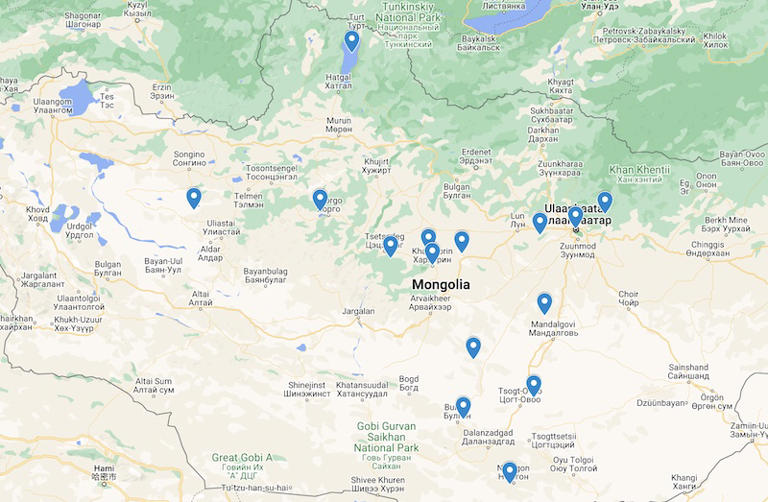

IMAGES
VIDEO
COMMENTS
Given the temperature extremes in Mongolia - peaking at 45°C (113°F) and plummeting to -40°C (-40°F) - the weather is obviously a big factor in deciding the best months for a visit. But truth be told, anytime is a good time to visit Mongolia, with each season bringing unique, memorable experiences.
John Williamson from our supplier, Zavkhan Trekking shares his advice on the best time to visit Mongolia: "For me, the best time to visit Mongolia is during July and August, the peak summer months when the weather is pleasant and warm, around 25 degrees and the landscape is green and lush. The nature is beautiful then too and slightly earlier ...
The average summer temperature is +21°C, (+65°F) and winter is -20°C, (-13°F). The average rainfall is 200-220 mm. The best time to visit Mongolia is during the Mongolian summer, from the mid of June till last week of August. This is the safest time of the year to travel to Mongolia in terms of weather, sunny days throughout Mongolia and ...
If you are planning to travel to Mongolia, the most significant thing to consider is the weather. The country experiences an extreme continental climate; it is so far inland that no sea tempers its climate. Mongolia has four seasons and each has its own character. Keep in mind that the country has an average of 230-260 annual days of sunshine.
Best time to visit. The best time to visit Mongolia is between mid-June and late August, which is the summer season, characterized by sunny days and a little rain to keep the scenery lush and green. It's a pleasant time of year, although only the southern Gobi is truly hot. The country's landlocked location gives rise to an extreme ...
Photo via Jessie Festa. Summer in Mongolia, from late June to early September, is characterized by warm and pleasant weather and is the best time to visit Mongolia. Daytime temperatures range from 18°C to 25°C (64°F to 77°F). The vast steppes and landscapes flourish with greenery and wildflowers, coupled with extended daylight hours.
June: 16° C-26° C (60° F-78° F) July: 22° C-32° C (71° F-89° F) August: 20° C-28° C (68° F-82° F) With temperatures like this, short sleeves and pants are comfortable in the day, and extra layers sometimes necessary at night. Mongolia's weather is often unpredictable, so it's always a good idea to be prepared for anything here.
The best time to visit Mongolia is between June and August, when the landscapes are lush and green, and temperatures are warm, ranging from 18°C to 28°C. Mongolia's landlocked location gives rise to an extreme continental climate, with temperatures varying wildly. Only the southern Gobi is truly hot during the summer months, though this is ...
The best time to travel to Mongolia depends on your preferences and the experiences you seek. Here is a detailed breakdown of the different seasons and what they offer: Summer (June to August): Mongolia's summer is the peak tourist season, and for good reason. During this time, the landscapes transform into lush green meadows, making it ideal ...
This is when most tourists visit Mongolia, so you can expect peak rates, sometimes crowded natural landmarks and museums, and full flights. The average summer temperature in Mongolia is between 25° and 32° C, with cold nights. You can comfortably wear t-shirts during the day and a light jacket when it gets dark.
Weeks with ideal weather are listed above. If you're looking for the very warmest time to visit Mongolia, the hottest months are July, August, and then June. See average monthly temperatures below. The warmest time of year is generally late July where highs are regularly around 80.4°F (26.9°C) with temperatures rarely dropping below 55.3°F ...
The best time to visit Mongolia is between June and August, which is the peak of summer. The weather is particularly warm (compared to the other months), and except for a few scattered rainstorms, there is little to no precipitation either! ... Mongolian summers are the best time to travel to the country, for the winter can get rather merciless ...
The best time to travel to Mongolia is usually from May to early October. July is considered an ideal time to visit Mongolia. The weather is cool, and pleasant, only hot when the sun is not obscured by clouds. However, this is the high time of the tourist season here, the accommodation is not enough and the traffic is very heavy.
Best Time To Visit Mongolia. The best time to travel to Mongolia depends on where you plan to go, what you plan to do, and your ability to handle extreme heat and cold.. Summer (June-August) is the peak tourism season, with warm weather and important festivals in Mongolia like Naadam taking place.. If you want to enjoy nice weather while saving money on high-season prices, autumn (September to ...
Where to Go in Mongolia - Itinerary. Day 1: Visiting Ulaanbaatar. Day 2: Getting from Ulaanbaatar to the Gobi desert. Day 3: Visit the Baga Gazryn Chuluu Rock Formations. Day 4: Sleep at a Ger Camp in the Gobi Desert. Day 5: Dalanzagad to Gobi Discovery Ger Camp. Day 6: Hiking in Yolin Am - Mongolia's Ice Valley.
The Best time to visit Mongolia. The most popular time to visit Mongolia is generally from June to late September, when the weather is either warm or pleasant. June through August are the warmest months in Mongolia. Going into autumn, the temperatures tend to get a bit cooler specially at night but are still comfortable for travel.
Mongolia weather in June. June is one of the best months to travel to Mongolia in terms of weather; pleasant and dry without a crowd of travelers. The temperature could cool down at night, ranging from +8°C to +20°C, and much warmer daytime between +15°C and +33°C. The landscape turns greener.
The best time to visit Mongolia is from July to September. These summer months see the sun wash across the landscape to reveal its vibrant colours and dramatic details in perfect definition. ... Visitor numbers pick up, but it is a very good time to travel with long, warm days to explore. Visiting Mongolia in July. The hottest month, with ...
Warm summer days are around 20 °C, but extremes reach as high as 40 °C (104 °F) in the Great Gobi area and 33 °C (91.4 °F) in Ulaanbaatar. The warm summer lasts from May to September with an average daily temperature of 20°C. During this short period of time Mongolia displays its beauty of nature and attracts many tourists.
When is the best time to visit Mongolia? The optimal time to visit Mongolia is from May to September. The summer months, spanning June to August, are characterized by sunny days, minimal rain, and lush green landscapes. This period coincides with Mongolia's celebrated Naadam festival, a major tourist attraction held between July 11 and July 13.
Mongolia Travel Tips. As you explore the best places to visit in Mongolia, make sure to keep the following advice in mind: ... While you can visit Mongolia any time of year, summer (mid-June to ...